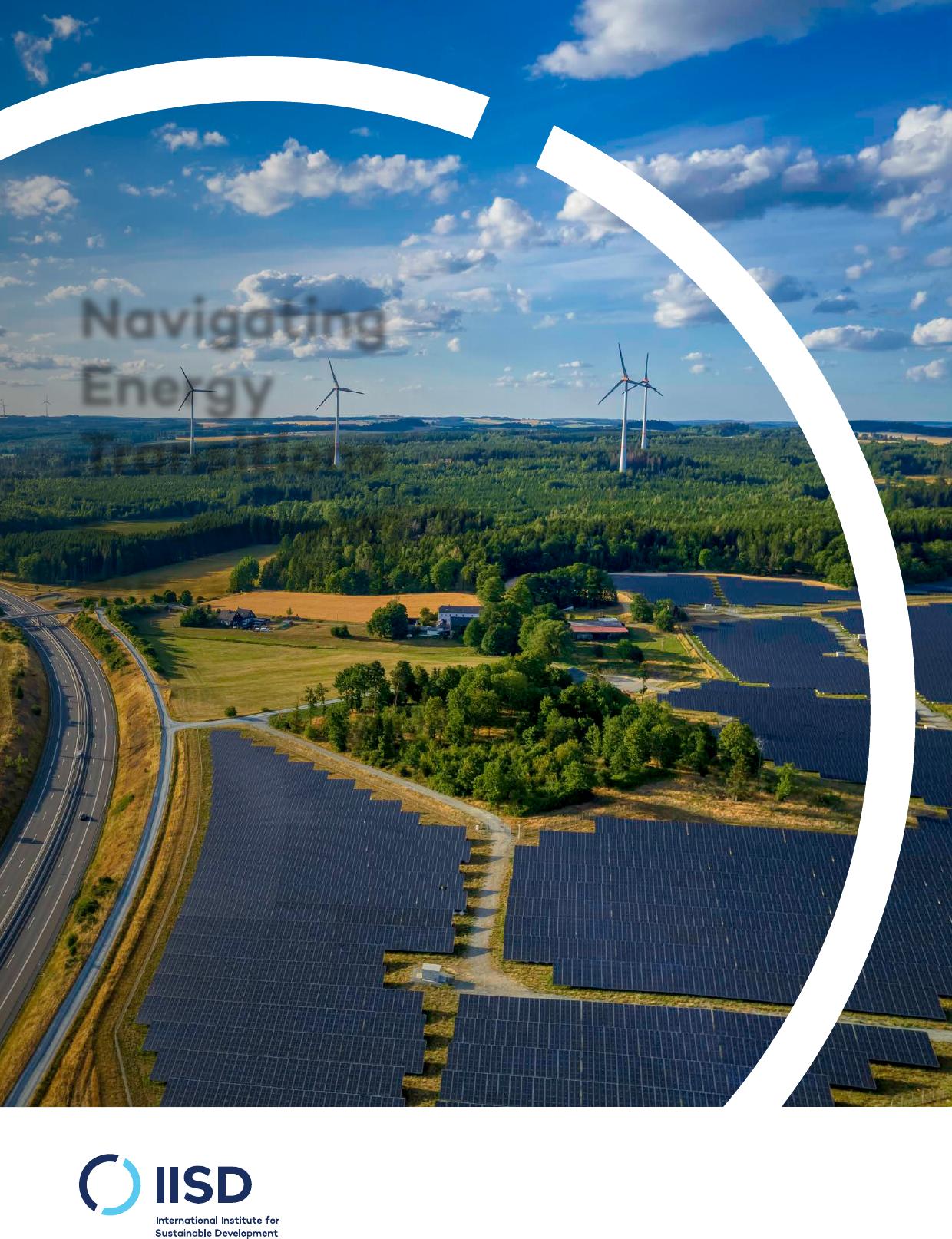NavigatingEnergyTransitionsMappingtheroadto1.5°CIISDREPORT©2022InternationalInstituteforSustainableDevelopmentIISD.orgOctober2022NavigatingEnergyTransitions©2022InternationalInstituteforSustainableDevelopmentHeadOfficePublishedbytheInternationalInstituteforSustainableDevelopmentThispublicationislicensedunderaCreativeCommonsAttribution-111LombardAvenue,NonCommercial-ShareAlike4.0InternationalLicense.Suite325Winnipeg,ManitobaInternationalInstituteforSustainableDevelopmentCanadaR3B0T4TheInternationalInstituteforSustainableDevelopment(IISD)isanTel:+1(204)958-7700award-winningindependentthinktankworkingtoacceleratesolutionsWebsite:www.iisd.orgforastableclimate,sustainableresourcemanagement,andfairTwitter:@IISD_newseconomies.Ourworkinspiresbetterdecisionsandsparksmeaningfulactiontohelppeopleandtheplanetthrive.Weshinealightonwhatcanbeachievedwhengovernments,businesses,non-profits,andcommunitiescometogether.IISD’sstaffofmorethan120people,plusover150associatesandconsultants,comefromacrosstheglobeandfrommanydisciplines.WithofficesinWinnipeg,Geneva,Ottawa,andToronto,ourworkaffectslivesinnearly100countries.IISDisaregisteredcharitableorganizationinCanadaandhas501(c)(3)statusintheUnitedStates.IISDreceivescoreoperatingsupportfromtheProvinceofManitobaandprojectfundingfromgovernmentsinsideandoutsideCanada,UnitedNationsagencies,foundations,theprivatesector,andindividuals.NavigatingEnergyTransitions:Mappingtheroadto1.5°COctober2022IISD.orgiiNavigatingEnergyTransitionsAcknowledgementsTheInternationalInstituteforSustainableDevelopmentwouldliketothanktheauthorsandthereviewersfortheircontributiontothepreparationofthisreport.Theauthorsandreviewershavecontributedtothereportintheirindividualcapacities;theiraffiliationsareonlymentionedforidentificationpurposes.AuthorsChapter1:AngelaPicciariello(InternationalInstituteforSustainableDevelopment)Chapter2:OlivierBoisvonKursk,GregMuttitt(InternationalInstituteforSustainableDevelopment)Chapter3:OlivierBoisvonKursk,GregMuttitt,AngelaPicciariello(InternationalInstituteforSustainableDevelopment)Chapter4:MohamedAdow(PowerShiftAfrica),AndreasGoldthau(WillyBrandtSchoolofPublicPolicyattheUniversityofErfurtandInstituteforAdvancedSustainabilityStudies),DialaHawila(InternationalRenewableEnergyAgency),ThijsVandeGraaf(GhentUniversity)Chapter5:MaraAbbot(Ceres),ThomasDay(NewClimateInstitute),FredericHans(NewClimateInstitute),AndrewLogan(Ceres),SilkeMooldijk(NewClimateInstitute),KylaTienhaara(Queen’sUniversity,Ontario)Chapter6:LucileDufour,AngelaPicciariello(InternationalInstituteforSustainableDevelopment)ReviewersAlaaAlKhourdajie(ImperialCollegeLondon;IPCC,WorkingGroupIIITechnicalSupportUnit),AndreaBassi(InternationalInstituteforSustainableDevelopment),NicoBauer(PotsdamInstituteforClimateImpactResearch),SarahBrown(Ember),AnnaChristie(UniversityofEdinburgh),KateDooley(UniversityofMelbourne),LucileDufour(InternationalInstituteforSustainableDevelopment),LisaFischer(E3G),ClaireFyson(ClimateAnalytics),PhilGass(InternationalInstituteforSustainableDevelopment),AnnaGeddes(InternationalInstituteforSustainableDevelopment),IvettaGerasimchuk(InternationalInstituteforSustainableDevelopment),NeilGrant(ClimateAnalytics),KaisaKosonen(GreenpeaceInternational),MichaelLazarus(StockholmEnvironmentInstitute),AmanMajid(ClimateAnalytics),MereteVillumPedersen(MinistryofForeignAffairs,Denmark),AnnalisaPerteghella(ECCOClimate),ElkePfeiffer(NetZeroAssetsOwnerAlliance),StevePye(UCLEnergyInstitute),LukasSchaugg(InternationalInstituteforSustainableDevelopment),KellyTrout(OilChangeInternational)ChiefscientificeditorsOlivierBoisvonKursk,LucileDufour,GregMuttitt,AngelaPicciariello(InternationalInstituteforSustainableDevelopment)MediaandoutreachcommunicationsCharlyBlais,AiaBrnic,NatalieJones,PaulinaResich(InternationalInstituteforSustainableDevelopment),MariaDolben,ConorQuinn(GreenhouseAgency)GraphicandlayoutdesignKatherineClark,EliseEpp,AnnaPokhilenko(InternationalInstituteforSustainableDevelopment)LanguageeditingStrategicAgendaIISD.orgiiiNavigatingEnergyTransitionsExecutiveSummaryKeyMessages:•Accordingtoalargeconsensusacrossmultiplemodelledclimateandenergypathways,developinganynewoilandgasfieldsisincompatiblewithlimitingwarmingto1.5°C.Globaloilandgasproductionandconsumptionmustdecreasebyatleast65%by2050.•Governmentsshouldcreateenablingenvironmentsforredirectingbothpublicandprivatecapitalflowstowardthecleanenergytransition,includingthedeploymentofadditionalsolarandwindcapacity.TheannualinvestmentgapfortherequiredwindandsolardeploymentamountstoUSD450billionuntil2030.ForecastsindicatethatuptoUSD570billionwillbespenteveryyearinnewoilandgasdevelopmentandexplorationduringthesameperiod.•ThereisnoroomfornewfossilimportinfrastructureinEuropein1.5°C-alignedgasphase-outpathways.ExistingimportcapacitycanmeetthegasdemandforEuropeinthemedium-andlonger-term.In2022and2023,theshort-termsupplycrunchanditspotentiallydireconsequencescannotbealleviatedintimebynewlyaddedgascapacity.Thisreportaimstoinformpolicy-makers,investors,andcompaniesonwhatisrequiredtoaligntheirenergydecisionswiththegoalsoftheParisAgreement,basedonmodelledpathwaysconsistentwithlimitingwarmingto1.5°C.Webasethisanalysisonthefirst-evercomparisonofselectedclimateandenergyscenariosacrossthefullbodyofpublishedglobalmodelledpathways:thosereviewedbytheIntergovernmentalPanelonClimateChange(IPCC),thoseproducedbyintergovernmentalorganizationssuchastheInternationalEnergyAgency(IEA)andtheInternationalRenewableEnergyAgency(IRENA),andbytheprivatesector.Thereportfocusesonpathwaysforthephase-outofoilandgas,andfortheexpansionofwindandsolar,requiredtoprovideagreaterthan50%probabilityoflimitingglobaltemperatureswithinthe1.5°Climit.Wedonotaddresscoal,becauseParis-alignedpathwaysforcoalphaseouthavebeenextensivelyreviewedelsewhere(YanguasParraetal.,2019).Moreover,wefocusonwindandsolarenergysincetheyprovidethemostgreenhousegasmitigationpotentialatthelowestcostfromallcurrentlyavailableoptionsinallsectors(IPCC,2022).Wefindahighdegreeofalignmentbetweenscenarios,suggestingthatacommonsetofactionsisrequired.Thesmallvariationsfoundacrossscenariosillustratethatthereisstillarangeofpathstoimplementthissetofactionsinlinewiththe1.5°Ctarget.Nowmorethanever,understandinghowenergydecisionsbypolicy-makers,investors,andcompaniesaffectourabilitytocomplywiththistargetisessential.Thecurrentenergycrisisposessubstantialriskstotheachievementofacleanenergytransition,butalsoshowsthevalueofshiftingourenergysystemsfromfossilfuelstocleanenergy.IISD.orgivNavigatingEnergyTransitionsPhase-outPathwaysforOilandGasProductionOurcomparisonofmultipleclimateandenergyscenariosfindsthat,fortheworldtoreachnet-zeroemissionsinlinewiththe1.5°Ctarget,globaloilandgasproductionneedstodeclinerapidly.AccordingtothemedianofselectedIPCCscenariosandtheIEA’sNetZeroEmissionsby2050(NZE)scenario,oilandgasproductionshoulddeclinerespectivelyby15%and30%by2030,andby65%by2050,comparedto2020levels.Productionvolumesfromalready-operatingfieldsandthosecurrentlyunderdevelopmentwouldgeneratemoreoilandgasemissionsthanwouldbepermissibleunderthesepathways(FigureES1).Itimpliesthatnonewoilandgasfieldsshouldbedeveloped,astheywouldeithergeneratestrandedassets,orpushtheworldbeyondthe1.5°Ctarget,unlesscurrentlyproducingfields’operationsaresignificantlycurtailed.FigureES1.Globaloilandgasproduction,basedonselectedIPCCandIEA1.5°Cpathways2520SelectedIPCC1.5°CpathwaysNewfieldsIEANZEpathway15exceed1.5°CNewexplorationGtCONewfieldsFieldsunder10developmentProducingfields502025203020352040204520502020Sources:Byersetal.,(2022);IEA(2021);RystadEnergy(2022b).Allotheranalyzedpathways—theillustrativemitigationpathwayhighrenewables(IMP-Ren)scenario,theBloombergNewEnergyFinanceNewEnergyOutlookpathway,theIPCCIMPlowdemand(IMP-LD)scenario,theOneEarthClimateModel,Navigant,andtheIRENAWorldEnergyTransitionsOutlookscenario—reinforcethefindingsoftheselectedIPCCscenariosandIEA’sNZEscenario.Theypointtotheurgentneedforproductiontodeclinebyatleast65%betweennowand2050,withsmallvariationsinthesteepnessofproductiondeclinerates.Sinceoilandgasconsumptionneedstodeclineatroughlythesamepaceasforecastedproductionfromexistingfields,thesescenariosbearsimilarimplicationstotheIISD.orgvNavigatingEnergyTransitionsIPCCscenarioandIEA’sNZEscenario:inordertoalignwiththe1.5°Cgoal,nonewfieldsshouldbeopened(FigureES2).FigureES2.Globaloilandgasproduction,basedonotherselected1.5°Cpathways25Newfieldsandexploration20UnderdevelopmentandproducingfieldsGtCO15SelectedIPCC1.5°Cpathways10IEANZEpathwayBPNet-Zero5IRENADNVNet-Zero0IMP-Ren2020BNEFIMP-LDNavigantOECM202520302035204020452050Sources:BNEF(2021);BP(2022);Byersetal.,(2022);DNV(2021);IRENA(2022);Navigant(2018);RystadEnergy(2022b);Teskeetal.,(2022).DevelopmentPathwaysforWindandSolarCapacityEnablingastructuralshiftintheenergysectorinlinewith1.5°Cpathwayswillrequiresignificantlyscalinguptheannualrateofrenewabletechnologydeployment.Ourreportfindsthatpoliciescurrentlydeployedinsupportofrenewableenergyfallshortoftheseobjectives:accordingtotheselectedIPCCscenariosandIEA’sNZEscenario,by2030,annualcapacityadditionsshouldbeatleast2.5timeshigherforwindand1.5timeshigherforsolarenergycomparedtocurrentpolicyforecasts(FigureES3).Allotheranalyzedscenariosbroadlyconfirmtheneedtorapidlyaddfarmorewindandsolarcapacitythanplanned,andgenerallypointtoevenhigherrequiredratesofdeploymentforthetwotechnologies.IISD.orgviNavigatingEnergyTransitionsFigureES3.AnnualwindandsolarcapacityadditionsunderselectedIPCCandIEA1.5°Cpathways400WindcapacityWIND(IEANZEpathway)350Windcapacity(selectedIPCC3001.5°Cpathways)250Newpoliciesneededtoenablefastergrowth200GW150100Windprojection(basedoncurrentpolicies)5020202025203002015700SolarcapacitySOLAR(selectedIPCC1.5°Cpathways)600Solarcapacity(IEANZEpathway)500Newpoliciesneededto400enablefastergrowthGW300Solarprojection200(basedoncurrentpolicies)02020202520302015Sources:BNEF(2022);Byersetal.,(2022);IEA(2022).FinancingSolarandWindDeployment:TheinvestmentgapAllanalyzedscenariospointtheneedtomassivelyincreasewindandsolarcapacitiesinordertoeffectivelydisplaceoilandgasproduction.Toachievethis,investmentsinrenewableswillneedtoincreaserapidlyduringthecourseofthisdecade.OurselectionofIPCC1.5°Cpathwaysshowsthat,betweennowand2030,totalannualinvestmentsinbothwindandsolarshouldamounttoaboutUSD830billion.Currentinvestmentplansdonotcomeclosetosuchamounts.Unlessnewpoliciesareimplemented,therewillbeanannualinvestmentgapofmorethanUSD450billionuntil2030.IISD.orgviiNavigatingEnergyTransitionsHowever,estimatesshowthatcapitalandoperationalexpendituresfortheexplorationandextractionofoilandgasinnewfields—incompatiblewithIPCC,IEA1.5°Cpathways,andourbroaderselectionofscenarios—areexpectedtoreachUSD570billionannuallyby2030,foracumulativetotalofUSD4.2trillionbetween2020and2030(FigureES4).Bythemselves,theseinvestmentswouldsufficetobridgetheentireinvestmentgapforwindandsolarby2030.FigureES4.WindandsolarinvestmentneedsandinvestmentgapsSelectedIPCC1.5°Cpathways2030investmentforecast1,000USDbillion/year800SolarInvestmentNewfieldsand600gapexploration400Investmentgapissmallerthaninvestmentforecastinnewoilandgasdevelopment200InvestmentforecastWindProducingfields0202020252030Windand2015SolarOilandGasSources:Byersetal.(2022);RystadEnergy(2022b)TheWarinUkraineanditsImplicationsforEnergySystemsIn2022,theenergymarketdisruptionsduetotheRussianinvasionofUkraineandtheconsequenteconomicsanctionsonRussiahavestrainedglobalgassupplies.Theybringquestionsonthepresentandfutureroleofgasinenergyandpowersystemstotheforefrontofpolicydiscussions.Yetthereplacementofgaswithcleanpowergenerationalternativesisanimportantstepinachievingoilandgasproductionlevelsthatarecompatiblewitha1.5°Cfuture.Ourreportfindsthatglobalgaspowergenerationcapacityshoulddecreasebymorethan55%by2035comparedto2020levels.Currentlyforecastedgenerationfromgaspowerplantsalreadyinoperation,inconstruction,orbeingplanned,isexpectedtodelivermoregenerationcapacitythanwouldbeconsistentwiththeParisAgreementthroughouttheforthcomingdecades(FigureES5).Therefore,theconstructionofnewgas-firedpowerplantsrisksleadingtoadangerouslyhighnumberofstrandedassets.IISD.orgviiiNavigatingEnergyTransitionsFigureES5.Globalgaspowercapacity2,500GW2,000Gaspowerplants1,500Announced1,000Inpre-constructionUnderconstruction500OperatingSelectedIPCC1.5°Cpathways02025203020352040204520502020Source:Byersetal.(2022);GlobalEnergyMonitor(2022).InEurope,theshortageofgassupplyhassofarpushedpolicy-makerstoacceleratethetransitiontorenewableenergies,ontheonehand,andtopursuealternativegassupplies,ontheother.BasedontheselectedIPCCpathways,ourreportfindsthatexistingglobalimportcapacitycouldmeetmedium-andlong-termEuropeandemandwithoutRussianimports,ifEuropeweretoreducegasconsumptioninlinewiththe1.5°Ctarget(FigureES6).Thepotentialsupplycrunchin2022and2023couldhavedireconsequences,butnewgassupplyinfrastructurewillnotcomeonlineintimetoaddressitadequately.NotonlycanEuropemeetitsenergyneedsbyreducingdependenceonRussiangassupplythroughacceleratingrenewableenergy,energyefficiencyandelectrification,itmustdosotoalignwith1.5°Cpathways.TheEuropeangascrunchhasalsopromptedaglobaldashforgas,whichisincompatiblewiththetimelyachievementofanenergytransitioncompatiblewiththe1.5°Ctarget.Assuch,theimpactsoftheenergycrisismayalsobeconsiderableindevelopingcountries,especiallythosewithexploitablegasreserves.TheymayfacehigherrisksofstrandedassetsoncetheEuropeandashforgashasreacheditspeak.Itisthereforeessentialthatdevelopingcountriescontinuetopursue1.5°C-compatibletransitionpathways,andleapfrogfromcurrentfossil-basedenergyparadigmstocleanenergysourcesthatcanguaranteeamoresustainableandsecureenergyfuture.Itrequiresdedicatedpoliciestofostercapacitybuildingandinfrastructuredevelopment,andsupportofdonorcountriesandinternationalfinancialinstitutionsthroughadequatestreamsofclimatefinance.IISD.orgixNavigatingEnergyTransitionsFigureES6.EuropegasconsumptionandsupplyEuropegasconsumption(Bcm/year)800Europe1.5°C700alignedgas600consumption500400Russiagassupply300200LNG100(80%utilization)0MENApipelines2020(90%utilization)AzerbaijanexistingfieldsEuropeexistingfields202520302035Source:Author’scalculations,basedonBP(2022b);Byersetal.(2022);GlobalEnergyMonitor(2022a);RystadEnergy(2022b);EuropeanCommission(2022c)ThePrivateSectorandtheEnergyTransitionPhasingoutoilandgasproductionanddeployingwindandsolarcapacitiesinlinewiththe1.5°Ctargetrequiresconcertedeffortsfrompublicandprivateactorsalike.Inthisreport,wehavetakenacloserlookattwokeyareaswheretheprivatesectorcanpositivelycontributetothetransition,andwheregovernmentscanplayanenablingrole.Governmentsmustactpromptlytopreventthelicensingofnewoilandgasfields.Currently,considerablebarriersexisttogovernments’abilitytodosowithoutincurringtheriskoflegalaction.Ifgovernmentsweretocancelallupstreamoilandgasprojectsby2050inlinewithIEA’sNZEscenario,ourreportfindsthattheymightriskanaggregateUSD234billionclaimsinso-calledinvestor-statedisputesettlements,andatotalofUSD340billioniftheyadditionallycancelledprojectsindevelopmentbutnotyetproducingoilandgas.Possiblesolutionstothisissuerangefrommoratoriaonanyfurtherlicensingorissuingofexplorationpermitsforoilandgas,andthepaymentofacompensationbygovernmentsinreturnforawaiveroftreatyrights,toeventuallyreformingandterminatinginvestmenttreatiesaltogether.Investorstoohaveanimportantroletoplayinthetransitiontoa1.5°C-compatiblefuture.Inthelastcoupleofyears,anunprecedentedwaveofcorporatenet-zerotargetshasbeenannounced.However,therecurrentlyexistsnoclearandconsistentdefinitionforthesetargets.Thishasparticularlybeenthecasefornet-zerotargetsintheoilandgassector,oftenoverestimatingcompanies’actualemissionsreductions.Tothisend,otherframeworksandtoolsareemergingtofillthegaps.Theseincludeinternationalclimatedisclosurereportingframeworksandnational-levelmandatorydisclosurerequirements.IISD.orgxNavigatingEnergyTransitionsKeyRecommendationsTheselectionofmodelledpathwaysanalyzedinthisreportallpointtoacommonsetofactionstolimitglobalwarmingto1.5°C.Basedonthesepathwaysandouranalysisofthecurrentopportunitiesandbarrierstopolicychange,werecommendthat:1.Governmentsshouldpreventthedevelopmentandlicensingofanynewoilandgasfields.Developinganyfieldsbeyondthosealreadyinoperationorunderdevelopmentwouldposesubstantialrisksofeithernotmeetingthe1.5°Ctargetorcreatingstrandedassets,becausethosefieldswouldhavetobedecommissionedbeforetheendoftheirlifespan,unlesscurrentlyproducingfields’operationsaresignificantlycurtailed.2.Governmentsmustprovidemoreandbettersupporttowindandsolardeployment.Theyneedtoimprovecurrentpoliciesandputinplacenewones,toincreasesolarandwindcapacityworldwide.Theseshouldincludepolicyframeworksaimedatreducingpermittingandlicensingdelaysforrenewables’installation,aswellaslocalizingrenewableenergyvaluechainstomakethemmoreresilienttotradewars,politicalconflicts,andpricevolatility.3.Governmentsshouldcreateenablingenvironmentsforredirectingbothpublicandprivatecapitalflowstowardthecleanenergytransition,includingthedeploymentofadditionalsolarandwindcapacity.Theforecastedinvestmentsintheexplorationanddevelopmentofnewoilandgasfields—incompatiblewiththe1.5°Cpathways—arehigherthantheinvestmentgapforwindandsolardeployment.4.Thecurrentenergycrisis,experiencedbyEuropeinparticular,shouldnotbetackledbyincreasingthecontinent’srelianceongas.Doingsowouldriskputtingthe1.5°Ctargetevenfurtheroutofreach,orcreatingstrandedassetsfornewlybuiltinfrastructurebothinEuropeandingas-exportingcountries,whilenotsolvingtheshort-termcrunch.GovernmentsandinvestorsshouldinsteadviewthecrisisasanopportunitytofurtherstepupEurope’scleanenergyambition,bystrengtheningexistingframeworkssuchastheEUFitfor55packageandtheEuropeanGreenDeal.5.Investmenttreatiesneedtobeurgentlyandradicallyreformedorrepealedtoallowgovernmentstoenforce1.5°C-compatibleoilandgasphase-outpathways.Governmentscantacklethisissuebypursuingoneoracombinationofexistingsolutions,namelyamoratoriumonanyfurtherlicensingorissuingofexplorationpermitsforoilandgas,settingupsystemstopayoutcompensationinreturnforawaiveroftreatyrights,andeventuallyreformingandterminatinginvestmenttreaties.6.Governmentsshouldbetterregulatethelong-termtargetsofthecorporatesector,atboththeglobalandnationallevels,toensurethattheysupportthegoalsoftheParisAgreement.Regulativeapproachesbygovernmentsholdcriticalpotentialtoensurehighlyambitiouscorporatelong-termtargets.SuchregulationcouldproviderobustlydefinedconceptsthataddsubstantivecriteriatoensureParisAgreementcompatibility,andmandatecomprehensiveandthird-partyverifieddisclosurepractices.IISD.orgxiNavigatingEnergyTransitions7.Governmentsshouldsetupmandatoryrequirementsforcompanies’reportingmethodologies.Untilthen,investorscanfillthegapbyadoptingvoluntaryreportingmethodologies.Corporateclimatereportingisinstrumentaltotheabilityofthefinancialsectortochannelcapitalwhereitismostneededtoacceleratetheenergytransition.Rigorousmandatorystandardswouldenabletheproductionofstandardizedmaterialinformation,consistentlydisclosedwithinandacrosscountries.IISD.orgxiiNavigatingEnergyTransitionsTableofContents1.0Introduction.....................................................................................................................................................................12.0Energy/ClimateModelsandEnergyPathways.............................................................................................42.1StrengthsandLimitationsofEnergy/ClimateModels..................................................................................62.2EquityandRegional/NationalTargets.........................................................................................................................72.3KeyUncertainties:CCSandcarbondioxideremoval.....................................................................................82.4ThePathwaysUsedinThisReport.................................................................................................................................93.0EnergySystemTransformationandInfrastructureNeeds...................................................................133.1Paris-alignedOilandGasPhase-outTimelines...............................................................................................153.2TheRoleofGasPowerGenerationintheEnergyTransition...................................................................193.3RenewableEnergyDeploymentNeeds.....................................................................................................................213.4RegionalDimensions..............................................................................................................................................................243.5FinancingtheTransition.....................................................................................................................................................264.0TheWarinUkraineandtheGeopoliticsofEnergyTransitions..........................................................304.1TheWarinUkraineandtheDashforGas..............................................................................................................314.2AlternativestoGasinEurope........................................................................................................................................404.3ImplicationsforRenewablesoftheWarinUkraine......................................................................................454.4OpportunitiesforDevelopingCountriestoLeapfrog.................................................................................525.0FosteringEnablingEnvironmentstoAcceleratetheTransitiontoNet-Zero...............................575.1LegalandEconomicChallengestotheEnergyTransition.......................................................................585.2InvestmentTreatiesandOilandGasPhase-out............................................................................................595.3CorporateNet-zeroTargets:Aninadequatestateofplayenteringacrucialdecade....625.4InstitutionalInvestorToolsandStrategies:Agrowingmovement,withaneedforreliableinformation..........................................................................................................................................................................706.0ConclusionsandKeyPolicyRecommendations..........................................................................................78Resources...............................................................................................................................................................................81Appendix..............................................................................................................................................................................102IISD.orgxiiiNavigatingEnergyTransitionsListofFiguresFigureES1.Globaloilandgasproduction,basedonselectedIPCCandIEA1.5°Cpathways......vFigureES2.Globaloilandgasproduction,basedonotherselected1.5°Cpathways........................viFigureES3.AnnualwindandsolarcapacityadditionsunderselectedIPCCandIEA1.5°Cpathways............................................................................................................................................................................................................viiFigureES4.Windandsolarinvestmentneedsandinvestmentgaps............................................................viiiFigureES5.Globalgaspowercapacity.....................................................................................................................................ixFigureES6.Europegasconsumptionandsupply..............................................................................................................xFigure3.1Globaloilandgasproduction,basedonselectedIPCCandIEA1.5°Cpathways.......16Figure3.2Globaloilandgasproduction,basedonotherselected1.5°Cpathways............................17Figure3.3Globalgaspowergenerationcapacity............................................................................................................20Figure3.4AnnualwindandsolarcapacityadditionsunderselectedIPCCandIEA1.5°Cpathways...........................................................................................................................................................................................................22Figure3.5AnnualwindandsolarcapacityadditionsunderBNEF,NetworkforGreeningtheFinancialSystem,andOECM1.5°Cpathways....................................................................................................................23Figure3.6Cumulativewindandsolarcapacitydeploymentneeds,2022–2030...................................25Figure3.7Windandsolarinvestmentneedsandinvestmentgaps....................................................................27Figure3.8Regionalcumulativeinvestmentneedsforwindandsolar,2022–2030..............................28Figure4.1Wholesalegaspricesinkeymarketssince2018....................................................................................32Figure4.2EUnaturalgasimportsbysource........................................................................................................................33Figure4.3EstimatedtimeneededfortheRussianFederationtoshiftitsgasexportstoAsia.....34Figure4.4Europe’sLNGrushsinceFebruary2022.........................................................................................................35Figure4.5LNGexports(billioncubicmetres)intheIEA’snet-zeroscenario............................................39Figure4.6Europegasconsumptionandsupply,bcm/year.....................................................................................40Figure4.7TTFpricedevelopment,NaturalGasForwardDayAhead,USDpermetricmillionBritishthermalunit...................................................................................................................................................................................42Figure4.8Globalweightedaveragetotalinstalledcost,capacityfactor,andLCOEofnewlycommissionedutility-scalesolarPV,onshoreandoffshorewind,2010–2021..........................47Figure4.9Renewableshareofannualpowercapacityexpansion......................................................................49Figure5.1Climateinitiativesforfinancialinstitutions:Alandscape................................................................72Figure5.2Mapofclimatereportingframeworksandresources...........................................................................74IISD.orgxivNavigatingEnergyTransitionsListofTablesTable2.1Scenariosfeaturedinthisreport:UseofCDRandCCS......................................................................11Table3.1Oilandgasproductionphase-outpaceinkeymodelpathways..................................................19Table4.1MajorAfricannaturalgasprojectsthatmayaccelerate....................................................................36Table5.1Shortcomingsofexistingnet-zeropledgesacrosssectorsidentifiedinrecentlypublishedliterature,andofnet-zeropledgesandrelatedtransitionplansintheoilandgassector.........................................................................................................................................................................................................64TableA.1ScenariofilteringcriteriabasedonIPCCfeasibilityandsustainabilityassessmentforCCSandCDR......................................................................................................................................................103TableA.2Listofthe26IPCC1.5°CpathwaylimitingCDRandCCSdeployment.............................104IISD.orgxvNavigatingEnergyTransitionsAbbreviationsandAcronymsAR6IPCCSixthAssessmentReportBECCSbioenergyandcarboncapturestorageBITbilateralinvestmenttreatyBNEFBloombergNewEnergyFinanceCCScarboncaptureandstorageCCUcarboncaptureandutilizationCCUScarboncapture,utilization,andsequestrationCDRcarbondioxideremovalCIFcost,insurance,andfreightECTEnergyCharterTreatyEUEuropeanUnionFF55Fitfor55FSRUfloatingstorageandregasificationunitsGHGgreenhousegasGRIGlobalReportingInitiativeIAMintegratedassessmentmodelIEAInternationalEnergyAgencyIIGCCInstitutionalInvestorsGrouponClimateChangeIMPillustrativemitigationpathwayIMP-LDIMPlowdemandIMP-RenIMPhighrenewablesIPCCIntergovernmentalPanelonClimateChangeIRENAInternationalRenewableEnergyAgencyISDSinvestor–statedisputesettlementISSBInternationalSustainabilityStandardsBoardLCOElevelizedcostofelectricityLNGliquefiednaturalgasMDBmultilateraldevelopmentbanksNGFSNetworkforGreeningtheFinancialSystemIISD.orgxviNavigatingEnergyTransitionsNZENetZeroEmissions(by2050)OECDOrganisationforEconomicCo-operationandDevelopmentOECMOneEarthClimateModelPRIPrinciplesforResponsibleInvestmentPVphotovoltaicSASBSustainabilityAccountingStandardsBoardSBTiScienceBasedTargetsInitiativeSECSecuritiesandExchangeCommissionTCFDTaskForceonClimate-relatedFinancialDisclosuresTPITransitionPathwaysInitiativeTTFTitleTransferFacilityUNCTADUnitedNationsConferenceonTradeandDevelopmentUNFCCCUnitedNationsFrameworkConventiononClimateChangeIISD.orgxvii1.0IntroductionNavigatingEnergyTransitionsTheworldmustsetitselfonapathwayconsistentwithlimitingglobalwarmingto1.5°Ctoavoidthemostdisruptiveandtragicconsequencesofclimatechangeonpeople,ecosystems,andeconomies.Thisisextremelyurgentandeveryfractionofadegreematters:atpresentratesofgreenhousegas(GHG)emissions,theworld’sremainingcarbonbudgetwillbeextinguishedinapproximately8years.Theworldcanstillachievethe1.5°Cgoal,butthewindowtodosoisnarrowingquickly.GovernmentsmusturgentlyexceedtheambitionoftheircurrentParisAgreementpledges.MitigatingGHGemissionsfromfossilfuelswillrequirefossilfuelproductiontodeclinerapidly,aswellasafastandsustainedestablishmentofalternativeandcleanermodesofenergyconsumptionandproduction.Thatrequires,amongotheractions,amajorshiftofinvestmentflowsfromfossiltowardcleanenergysources.ThewarinUkraineandtheresultantenergycrisishaveonlymademorepressingtheneedtoreducecountries’dependenciesonfossilfuelsandmoveasfastaspossibletowardcleanermodesofenergyproduction.Energyscenarioscanplayakeyroleinfosteringsuchatransformationbyindicatingsuitableenergypathwaysthatcanbetranslatedintopolicyframeworksconducivetoacleanenergytransition.Theycanalsoinformtheshiftofcapitalflowsawayfromfossil-basedenergyproductionandtowardrenewableenergysources,inlinewithart.2.1coftheParisAgreement,“makingfinanceflowsconsistentwithapathwaytowardlowGHGemissionsandclimate-resilientdevelopment.”Thisreportaimstoinformpolicy-makers,investors,andcompaniesonwhattheycandotoaligntheirenergydecisionswiththegoalsoftheParisAgreement,basedonmodelledpathwaysconsistentwithlimitingglobalwarmingto1.5°C.Webasethisanalysisonpathwaysfromaselectionofthemostauthoritativeenergyandclimatemodels,whichrepresentandprovideinsightsaboutpossiblewaysthefuturecouldunfold,basedonvarioustechnical,economic,societal,andpolicyassumptions.Thisreportisthefirsttocomparefindingsacrossthefullbodyofpublishedenergymodelpathways:thosereviewedbytheIntergovernmentalPanelonClimateChange,thoseproducedbyintergovernmentalorganizationssuchastheInternationalEnergyAgencyandtheInternationalRenewableEnergyAgency,andbytheprivatesector.Thereportfocusesonpathwaysforthephase-outofoilandgas,andfortheexpansionofwindandsolar,requiredforagoodchanceofglobaltemperaturesstayingwithinthe1.5°Climit.Modelsrestonanumberofassumptions,forexamplerelatedtothecosts,performance,andavailabilityofvariousenergytechnologiesinthefuture.Ourreportbeginsbydiscussingtheseassumptions,outliningthemainstrengthsandlimitationsofeachmodel,andexplainingthechoiceswemadeintermsofselectionofscenarios(Chapter2).Wethenanalyzetheselectionofscenariosanddrawkeyconclusionson:•Therequiredphase-outpathwaysforoilandgasproductionbetweennowand2050,atthegloballevel.•Therequiredlevelsofsolarandwindenergydeploymenttosubstitutefossilenergyproduction,atbothglobalandregionallevels.IISD.org2NavigatingEnergyTransitions•TheinvestmentgapsbetweencurrentandplannedspendingandtheinvestmentneededtoachieveParis-alignedinvestmentpathways,bothgloballyandregionally(Chapter3).ThecurrentenergyandgeopoliticalcrisestriggeredbytheongoingwarinUkraineareaffectingthestrategicenergydecisionsmadebygovernmentsandprivateactors,andmaybeexacerbatingsomeofthebarrierstoacleanenergytransition.Butitisalsocreatingarenewedurgencytomovefasterwiththeenergytransitionthanhassofaroccurred.Weanalyzethemainenergyconsequencesofthewar,withaparticularfocusonEurope’srecentdashforgas,anddiscussthevariousoptionsavailabletomoveEuropebeyondgas.Moreover,weoutlinetheexpectedimpactsofthewaronrenewableenergydevelopmentindifferentregions,andoptionsfordevelopingcountriestoleapfroginspiteofthedashforgas(Chapter4).Inordertoprovideclearandactionablerecommendationsforpolicy-makers,financialactors,andinvestors,thereportdiscussestheroleoftheprivatesectorinsuchatransition,andofgovernmentstocreateanenablingenvironmentforprivateactors.Wehighlightsomeofthemainlegalandeconomicbarriersfacedbygovernmentswhentryingtophaseoutoilandgasproduction,relatedtothemultitudeofinvestmenttreatieswhichprotecttheforecastedrevenuesthatoilandgascompaniesmightgeneratewiththeirlicensedreserves.Wealsodiscussframeworksandtoolsthatcouldhelpmakecorporatenet-zerotargetsmoreeffectiveandaligninstitutionalinvestors’strategieswitha1.5°C-compatibleworld(Chapter5).Finally,werecommendanumberofactionsthatgovernments,investors,andfinancialinstitutionscantakeinordertoachievepositivechangeinlinewiththeimplicationsoftheenergyscenarios(Chapter6).IISD.org32.0Energy/ClimateModelsandEnergyPathwaysNavigatingEnergyTransitionsKeyInsights•Energyandclimatemodelsrepresentandprovideinsightsaboutwaysthefuturemayunfold,basedonvarioustechnical,economic,societal,andpolicyassumptions.Analysisofsuchfutures(“pathways”)playsakeyroleininformingclimatepolicydecisions.•Thisreport’scorefindingsarebasedontwo1.5°Cpathways:themedianof26pathwaysreviewedintheIntergovernmentalPanelonClimateChange’s(IPCC’s)SixthAssessmentReport(AR6),andtheNetZeroEmissionsby2050scenario(NZE),publishedbytheInternationalEnergyAgency(IEA)inthe2021editionofWorldEnergyOutlook.Wealsocomparethesewithseveralotherpathwaystoidentifycommonfeaturesanddifferences,namely:theIPCCillustrativemitigationpathways(IMPs)—IMP-RenandIMP-LD—aswellaspathwaysfromtheInternationalRenewableEnergyAgency(IRENA),OneEarthClimateModel(OECM),BloombergNewEnergyFinance(BNEF),Navigant,DNV,andBP.•Twocriticalassumptionsinmodelsregardtheavailabilityatscaleofmethodstoremovecarbondioxide(CO2)fromtheatmosphereand/orofcarboncaptureandstorage(CCS)technology.Giventheuncertaintiesrelatedtothedeploymentofthesetechnologies,thescenariosanalyzedinthisreportareselectedbecausetheydonotexceedIPCCjudgementsoffeasibleandsustainabledeploymentlevels.Energyandclimatemodels1representandprovideinsightsaboutwaysthefuturemayunfold,basedonvarioustechnical,economic,societal,andpolicyassumptions(Mossetal.,2010).Analysisofthesemodelledfutures(“pathways”)2playsakeyroleininformingclimatepolicydecisionsandfeaturescentrallyinreportsoftheIPCC.Pathwayslimitingwarmingto1.5°C(withnoorlowovershootofthetarget)generallyseeCO2emissionsreducedby48%by2030,comparedwith2019levels,andreachingnet-zerobyaround2050(IPCC,2022).3Mostpathwaysseereducedusageofallthreefossilfuelsby2030andmajorreductionsby2050,withcoaldecliningthefastest(IPCC,2022,Table3.6).However,theworldremainsfarofftrack.In2022,greenhousegasemissionsarecontinuingtoincrease,andwhiletheworldcanstillachievethe1.5°Cgoal,thewindowforthisisclosing.GovernmentsmusturgentlyexceedtheambitionsoftheircurrentParisAgreementpledges(NationallyDeterminedContributions)andbeginenactingproposedchangesbeforethe1.5°Cgoalmovesoutofreach(IPCC,2022).1Thisreportusestheterm“energy/climatemodels”(orsometimesjust“models”)toincludebothintegratedassessmentmodels(IAMs),whicharegenerallymanagedbyacademicresearchgroupsandassessedbytheIPCC,andmodelsoftheenergysystemalone,suchasthosepublishedbyintergovernmentalandprivatesectororganizations.IAMsrepresenttheenergy,climate,andeconomicsystemsinanintegratedway.2Theterms“pathway”and“scenario”areoftenusedinterchangeably.Inthisreport,wegenerallyusetheterm“scenario”whendescribingtheassumptionsinputtedintothemodel,and“pathway”whendescribingtheresultingenergysystemsandemissionsoutputtedfromthemodel.3Specifically,thisreferstopathwayswhoseprobabilityoflimitingend-of-centurywarmingto1.5°Corlessisgreaterthan50%,categorizedasC1byWorkingGroup3inAR6.IISD.org5NavigatingEnergyTransitionsEnergy/climatemodelsareusedforawidevarietyofpurposes.Forexample,IEA’sWorldEnergyOutlook(2021c,p.3)aimsat“enablinggovernmentstounderstandwhattheyneedtodotoputemissionsintorapidandsustaineddecline”toreachnet-zeroemissionsby2050.OECM,commissionedbytheUN-convenedNet-ZeroAssetOwnerAllianceandtheEuropeanClimateFoundation,“providesverygranularsectorspecificnet-zeropathwaysbasedoncurrentlyavailabletechnologies[…]Forassetownerscommittedtonet-zeroportfolioalignment,sectorpathwayinformationisofutmostimportanceforinvestmentportfoliosteering”(Teskeetal.,2020,p.3).Someacademicstudiesaimtobetterunderstandhowdifferentfactorsshapepossiblefuturesthroughasking“Whatif?”questions(EvansandHausfather,2018).Thesemodelscanshedlightontheimplicationsofpolicychoicesorexplorethemosteffectiveorlowest-costmeanstoachievepolicygoals.ResearchersusedmodelstoassessthepaceatwhichcoalpowergenerationshouldbephasedouttoachievetheParisAgreement’sgoals(Rochaetal.,2016),whichinformedthegoalsofthePoweringPastCoalAlliance(2018),whosemembershavecommittedtophasingoutcoalpowerby2030inthecountriesoftheEuropeanUnionandOrganisationofEconomicCo-operationandDevelopment,andby2050inothercountries.Tointerprettheimplicationsthatmodelpathwayscarryforreal-worlddecisions,itisnecessarytounderstandhowmodelswork,whytheywerebuilt,andwhattheirstrengthsandweaknessesare.Thisreportaimstoinformpolicy-makers,investors,andcompaniesonwhatitwouldtaketoaligntheirenergydecisionswiththeParisAgreement’sgoals,basedonglobalmodelledpathwaysconsistentwithlimitingwarmingto1.5°Candshowingaprobabilityof50%orhigher.WebasethisanalysisonpathwaysreviewedbytheIPCCaswellasthosegeneratedbyintergovernmentalorganizationssuchastheIEAandIRENAandthosefromtheprivatesector.Thereportfocusesonthephase-outofoilandgas,andexpansionofwindandsolar.Wedonotaddresscoal,becauseotherreportshaveextensivelyreviewedParis-alignedpathwaysforcoalphase-out(YanguasParraetal.,2019).2.1StrengthsandLimitationsofEnergy/ClimateModelsModelsarepowerfultoolsforrevealingtheinteractionsbetweendifferentelementsofcomplexsystems,includingdramaticallychangingsystems(DeCarolisetal.,2017;Tayloretal.,2014).Theyhelpexploretherangeoffuturesthataretechnicallyandeconomicallyviable.Forexample,modelshelpedenablepolicydiscussionsonthe1.5°CgoalintheParisAgreement,bydescribingatechnicallyandeconomicallyviableenergysystemtolimitemissions(vanBeeketal.,2022).Assimplifiedmathematicaldepictionsoftheworld,modelsnecessarilyrestonmanyassumptions,andthefurthertheylookintothefuture,themoreuncertaintheseassumptionsbecome.Theseincludenotonlybig-pictureassumptionsabouttheshapeoftheworld,suchasonpopulationsizeorenergyservicedemands,butalsoparametersdescribingthecosts,performance,andavailabilityofvariousenergytechnologies(Keppoetal.,2021).IISD.org6NavigatingEnergyTransitionsDifferentmodelsdisplaydifferentstrengths.Forexample,modelsmanagedbyacademicresearchersareoftenmoretransparentintheirmethodologiesandmoreflexibleintheirexplorationofresearchquestions.Intergovernmentalorganizations’energymodelstendtonarrowtherangeofpossibilitiestheyconsider,whichmakesusingtheirpathwayssimplerfordecision-makersbutprovideslessdetailforthemtoprepareforanuncertainfuture.Energymodelsmanagedbycommercialorganizationsoftenusethemostup-to-datecostestimatesbutcanbelesstransparentinhowtheywork,makingithardertointerpretanyoftheirconclusions(Pfenningeretal.,2017;Skeaetal.,2021).Thesemodelsalsosuffertrade-offsbetweenthelevelofcomplexityordetailtheyprovideandthecomputingpowerrequiredtooperatethem.Modelsvariouslygivemoreresolutioningeography,technologicalprocesses,enduses,infrastructure,oractors.Morefundamentalassumptionsunderpinthestructurallogicbywhichmodelsbringtogetherthesevariedfactors,eitherbysimulatinghowfuturedecisionswillbemadeorbyidentifyingsomekindofoptimumpathway.Whethersimulatingoroptimizing,modelscommonlyrelyonalogicbasedoneconomicandtechnicalefficiency.Assuch,mostenergy/climatemodelspoorlyrepresenthumanbehaviours,social-politicalfactors,ordisruptivechanges(LiandStrachan,2016;McCollumetal.,2017;Wilsonetal.,2019),thoughtherearenascenteffortstobetterreflectsocio-politicalfactorsinmodels(Cherpetal.,2018;Geels,BerkhoutandVanVuuren,2016;Mercureetal.,2019;Trutnevyteetal.,2019).2.2EquityandRegional/NationalTargetsGenerally,IAMshavenotbeenadoptedfortherepresentationofcomplexvaluejudgments,astheassumptionsrequiredforthiscouldbehighlycontentious.Oneofthemostimportantofthesejudgmentsishowtoequitablysharemitigationeffortsbetweendifferentcountriesandactors(Keppoetal.,2021;Pyeetal.,2020).4Itiswidelyrecognizedthatcertaincountrieshavecontributedmorethanotherstoclimatechangethroughpastemissions,andthatcountriesvarysignificantlyinthefinancialandotherresourcestheyhaveavailabletocontributetosolvingtheproblem(IPCC,2022).Thisisknownastheprincipleofcommonbutdifferentiatedresponsibilitiesandrespectivecapabilities,whichisacentraltenetofboththeUNFrameworkConventiononClimateChange(UnitedNations,1992,art.3.1)andtheParisAgreement(UnitedNationsFrameworkConventiononClimateChange,2015,art.2.2).Anequitableinternationalapproachhasseveraldimensions,twoofwhichtendtorecurinequitydebatesandreceivebroadacceptance:differentiatedmitigation,whereGlobalNorthcountriesactsooneranddomoretoreducetheiremissions;andclimatefinance,whichwealthiercountriesprovidetopoorerones(CalverleyandAnderson,2022).ClimatenegotiationsinvolveseriouscontestationabouthowmuchmoreandhowmuchsoonerGlobalNorthcountriesmustact,whichwealthiercountriesshouldprovidefinance,whichpoorcountriesshouldreceiveit,aswellastheamountprovided.Insomeanalyses,thetwodimensionsarelinked:ifdevelopingcountriesreceivemorefinance,theymaybeableto4Equityconsiderationscanbeincorporatedintomodelsifappropriatelyinterpreted(viavaluejudgmentsand/orassumptions)andcodifiedintoauseableform.IISD.org7NavigatingEnergyTransitionsmitigatefaster,withlessdifferenceinpacefromdevelopedcountries(Holz,KarthaandAthanasiou,2018).Therefore,thegeographicbreakdownofmitigationeffortswilldependontheapproachtoequity.Inthisreport,wediscussfossilfuelphase-outonlyatthegloballevel.Asageneralguide,phase-outshouldbefasterintheGlobalNorththantheglobalaveragesuggestedhere.Conversely,wedoprovideabasicregionalbreakdownofgrowthinwindandsolardeploymentbasedonthemodels,withthecaveatthatintheGlobalSouththesewillonlybemeaningfulastargetstotheextentthatsufficientfinanceismadeavailable.2.3KeyUncertainties:CCSandcarbondioxideremovalTwocriticalassumptionsinenergy/climatemodelsregardtheavailabilityofmethodstoremoveCO2fromtheatmosphereand/orofCCStechnology,5neitherofwhichhaveyetbeendeployedatasignificantscale.RegardingCO2removal(CDR),theIPCChassaid“CDRdeployedatscaleisunproven,andrelianceon[CDR]isamajorriskintheabilitytolimitwarmingto1.5°C”(Rogelj,ShindellandJiang,2018,p.96).Theseassumptionsarehighlyconsequentialforthekindofenergysystemthatmaybeconsideredconsistentwithtemperaturelimits.ThemorecountriesundertakeCDRinthefuture,thelongertheworldcantaketodecreasenear-termemissions(andbyextension,thelongeritcantaketodecarbonizeenergysystems)(IPCC,2022).Similarly,CCScreatesapotentialmeanstodecouplefossilfuelusefromCO2emissions,intheoryallowingcontinueduseoffossilfuelsevenasemissionsdecline(Budinisetal.,2018).Manymodelsrelyonverylarge-scaleCDR,withremovalachievedeitherbycarbonsequestrationthroughreforestationandafforestation,orthroughbioenergywithCCS(BECCS).6Thisreliancehasbeenhighlycontroversialwithinthescientificcommunity,wheresomeviewmajorCDRas“essential”toachievingtheParisAgreement’sgoals,giventhedifficultyofreducingemissions(Galán-Martínetal.,2021),whileothersseeCDRrelianceas“anunjustandhigh-stakesgamble”(AndersonandPeters,2016)thatisatbesthighlyspeculative.ModelsthataimtominimizetotalsystemcostsoftenfavourCDR:laterremovalsofCO2provideawaytopushcostsdecadesintothefuture,resultinginlowerdiscountedcosts(Emmerlingetal.,2019;IPCC,2022;RosenandGuenther,2016).Yetthatverydistanceinthefutureincreasestheuncertaintyofdeployment.Relianceonitalsocreatesthedangerwhere,bythetimethoseuncertaintiesareresolved,theemissionswillalreadyhaveoccurred.Therefore,ifCDRcannotbedeployedtotheextentexpected,itwillbetoolatetoreversetheemissions(Smithetal.,2015).5CCSissometimesconsideredalongsidecarboncaptureandutilization(CCU),usingthecombinedtermCCUS.InCCU,thecapturedCO2isused,forexamplebybeingprocessedintofuels,orbybeingpumpedintooilfieldstoincreasereservoirpressuresanddriveenhancedoilrecovery(EOR).UseofwasteCO2toproducefuelsisaveryearly-stageandspeculativetechnology;ifsuccessfullydeployed,itwillnotreducetheamountofCO2enteringtheatmosphere,butwillratherobtainadditionalenergyservicesfromthecarbonbeforetheCO2isemitted.InthecaseofEOR,anyemissionsbenefitfromstoringtheCO2isoffsetbyadditionalemissionsarisingfromtheextraoil.Forthesereasons,inthisreportwefocusonlyonCCS,notCCU.6OtherproposedmethodsofCDR–includingthroughdirectaircapture,soiloroceansequestration,orenhancedweathering–playlessofaroleinmostmodels.IISD.org8NavigatingEnergyTransitionsMajorlimitationsanduncertaintiessurroundfuturedeploymentofCDR.BothforestsandBECCSrequireconsiderablelandarea.Forexample,capturing11.5GtofCO2peryearusingBECCS(comparedwithpresentannualglobalemissionsof40GtCO2)wouldrequirealandareaof380–700Mha,whichisequivalenttoonetotwotimesthesizeofIndia,orto25–46%oftheworld’sarableland.CapturingthesameamountwithforestswouldrequirethreetimesasmuchlandasBECCSwould(IPCC,2022).Thislandrequirementraisesconcernsregardingcompetitionwithfoodproductionandbiodiversityimpactswherewildlandisconverted.Takingtheselimitsintoaccount,scholarshaveestimatedwhatcouldbeconsideredthemaximumsustainablepotentialofvariousCDRapproaches(deConincketal.,2018;Fussetal.,2018).Therearealsofeasibilitychallengesforallenergysystemchanges,relatedtotheirtiming,disruptiveness,andscale,whichotherresearchershaveassessed,includingforBECCSandfossilCCS(Brutschinetal.,2021;IPCC,2022,AnnexIII,TableII.1).Evenatpotentiallyfeasiblelevels,theuncertaintiesremainaboutwhetherandhowCDRorCCScanbedelivered.CCSdeploymenttodatehasconsistentlyfallenbehindexpectations.Aftermorethan30yearsofeffortstocommercializeCCS,todaythereareonly27CCSfacilitiesinoperation,whichhaveatotalnameplatecapacityof36MtCO2(0.1%ofglobalemissions).Onlyfiveofthesefacilitiesaimtodeliverlong-termstorageofCO2,whiletheothersareusedinenhancedoilrecovery(GlobalCCSInstitute,2021).ManyCCSprojectshavefailed(RobertsonandMousavian,2022;Wang,AkimotoandNemet2021),andcostsremainhighcomparedwithotherlow-carbonalternatives.Indeed,thecostsofafacilitywithCCSwillalwaysbehigherthanthecostsofthesamefacilitywithoutCCS(Budinisetal.,2018).ForeitherCCSorCDR,someofthelargestchallengesrelatetogovernance.Manyunansweredquestionsremainonhowthesemeasurescanbeimplemented,monitored,andregulatedtoensuretheireffectiveness,andwhatinstitutionsareneededtodeliverincentives,funding,andpenaltiesatthegloballevel(Greenpeace,2021).2.4ThePathwaysUsedinThisReportThisreportaimstoprovideguidanceforenergydecisionstogovernments,investors,andcompanies,especiallyconcerningoil,gas,wind,andsolar.Ourcorefindingsarebasedontwo1.5°Cpathways:•Themedianof26pathwaysreviewedintheIPCCAR6WorkingGroup3(IPCC,2022),usingdatahostedontheInternationalInstituteforAppliedSystemsAnalysis’ScenarioExplorer(Byersetal.,2022).•TheIEA’sNZEscenario,publishedinthe2021editionofWorldEnergyOutlook(IEA,2021c).ThemethodologyforselectingthepathwayswasbasedontheapproachfirstproposedbyClimateAnalytics(2018)andemployedintheProductionGapReportstoanalyzepathwaysfromtheIPCCSpecialReportonGlobalWarmingof1.5°C(StockholmEnvironmentalInstituteetal.,2021).ItusedtheIPCCScenarioExplorerdatabasetoselectpathwaysthatIISD.org9NavigatingEnergyTransitionsareconsistentwithcertaincriteria.Thesetof26IPCCpathways7selectedforouranalysisconsistsofthepathwaysinAR6thatalignwiththe1.5°Climit,excludingthosewhoseusageofBECCSorfossilCCSiscategorizedbytheIPCCasraisingmediumtohighfeasibilityconcerns.ItalsoexcludesthosewhoseforestCDRexceedstheIPCC’sestimateofmaximumsustainablepotential(seeappendixformoredetail),whichisintendedtoprovideamorerealisticaccountoftheirpotentialcontributionsoverthecomingdecades.Thesubsetofpathwaysalllimitwarmingto1.5°C(greaterthan50%probability)witheitherlimitedornoovershoot.Theyaregeneratedusingthree8models:MESSAGE-GLOBIOM,9REMIND-MAgPIE,10andWITCH.11Allthreeareoptimizationmodelsthatfindsolutionswiththelowestcostorhighesteconomicwelfare,subjecttovariousreal-worldconstraints.TheNZEscenarioisgeneratedusingtheIEA’sWorldEnergyModel,asimulationmodeloftheenergysystem,usingexogenousfuturepolicyassumptionsthatarelistedinthedocumentation(IEA,2021b).ItthusreliesontheIEA’sexplicitjudgmentaboutwhichpoliciesaremostrealisticallyachievable,ratherthanembeddingpolicychoicesincost-optimizationasanoverridingprinciple.WefocusonthesetwopathwaysbecausetheIPCCandIEAarewidelyusedinthecurrentliterature,andinthecaseoftheIPCC,thediversityofpathwaysimprovestherobustnessofouranalysis.Moreover,wealsocomparethesewithotherwell-knownpathwaysemployedbyfinancialinstitutions,consultancies,andtheprivatesectortoidentifycommonfeaturesanddifferences.Mostofthesepathwaysareconsistentwithlimitingwarmingto1.5°Cwithgreaterthan50%probability,andnotrelyingonCCSorCDRtoagreaterextentthanjudgedfeasibleorsustainable,asabove.12Theotherscenariosconsideredinthisreportare:•IPCCIMP-Ren(illustrativemitigationpathwayhighrenewables):oneoftheIPCC’s26pathways,itisalsoshownseparatelybecausetheIPCCusesitasanillustrativemitigationpathway(IMP)torepresentafuturewithahighlevelofrenewableenergy.•IPCCIMP-LD(IMPlowdemand):anotherofthe26pathways,thisIMPrepresentsafuturewithlowenergydemand,achievedthroughchangesinsocietalbehaviours.•OECM:developedbytheUniversityofTechnologySydneyfortheNet-ZeroAssetOwnersAllianceanddesignedtogiveahighlevelofsectorgranularitytohelpinforminvestordecisions(Teskeetal.,2020).7TheIPCCdoesnotproducethesepathwaysbutrathercollectandassessquantitative,model-basedscenariosrelatedtothemitigationofclimatechange.ThefinalselectionofscenariosconsideredbytheIPCCWorkingGroup3wasconductedbyauthorsoftheAR6report.8TheAR6alsoconsidered1.5°Cpathwaysgeneratedusingsevenothermodels,butallofthesepathwaysexceededthefeasibility/sustainabilitythresholdsonCDRandCCSdiscussedabove.9ManagedbytheInternationalInstituteforAppliedSystemsAnalysisnearVienna,Austria.10ManagedbythePotsdamInstituteforClimateImpactResearchinPotsdam,Germany.11ManagedbytheEuropeanInstituteonEconomicsandtheEnvironmentinMilan,Italy.12BasedontheCDR/CCScriterion,wedonotincludescenariosfromtheNetworkforGreeningtheFinancialSystem,fromShellorfromEquinor.IISD.org10NavigatingEnergyTransitions•BloombergNewEconomicFinance(BNEF)greenscenario:oneofthreenet-zeroscenariosinBNEF’sNewEnergyOutlook2021,whichprioritizescleanelectricityandgreenhydrogen.Itusesacarbonbudgetconsistentwitha67%chanceofkeepingwarmingbelow1.75°C(BNEF,2021).•IRENAWorldEnergyTransitionsOutlook1.5°CPathway:usesmacroeconometricmodellingtoassessthesocio-economicimpactofadiversepolicybasketwithmoderatecarbonpricestolimitwarmingto1.5°C(IRENA,2022d).•NavigantPathwaytoNet-Zero:a1.5°Cscenariofor100%DecarbonizationoftheGlobalEnergySystemby2050,itwasdevelopedtoprovidemaximumfeasibility,givingpreferencetooptionsthathavehighsocialandpoliticalacceptability(Navigant,2018).•DNVPathwaytoNetZero:aimstoachieve1.5°Cwithintheboundsoftechno-economicandpoliticalfeasibility.Accordingly,itemploysanintegratedsystemdynamicssimulationmodelthatreflectsrelationshipsbetweendemandandsupplyinseveralinterconnectedmodules(DNV,2021).•BPnet-zeroscenario:oneofthreepossibleenergytransitionscenariosandtheonlyonethataimstolimitwarmingto1.5°C,thisscenarioisbasedonasubsetofscenariosfromtheIPCC’sSpecialReportonGlobalWarmingof1.5°C,excludingtheonesconsideredtogiveoverlyoptimisticassumptionsaboutclimatepolicies(BP,2022a).WhilethisreporthasexcludedscenariosrelyingonCDRorCCSbeyondfeasibility/sustainabilitythresholds(above),itshouldbenotedthatallthescenariosconsideredinthisreportrelyonCDRtosomeextent,andmostrelyonCCS.GiventhatneitherCDRnorCCShaveyetbeendeployedatasignificantscaleandthattheyraiseformidablechallengesofcost,sustainability,andgovernance,aprecautionaryapproachtojudgingenergytransitionpathwaysshouldseektominimizerelianceonCDRandCCS.CDRcannotbeconsideredanalternativetorealemissionsreductions(Dooley,NichollsandMeinshausen,2022),andpathwayswithfasterdecarbonizationshouldbepreferredoverthosethatrelymoreonCDR.Asummaryofthescenarios’useofCDRandCCSfollowsinTable2.1.HavingdiscussedtherangeofpathwaysconsistentwiththeParisAgreementandthe1.5°Cgoal,thisreportwillconsidertheirimplicationsforarangeofaspects,beginningwiththequestionofthelicensingofnewoilandgasfields,andtheinvestmentsneededinrenewableenergytechnologies.IISD.org11NavigatingEnergyTransitionsTable2.1Scenariosfeaturedinthisreport:UseofCDRandCCSBECCSFossilCCSAfforestation/ReforestationMtCO2203020502030205020302050IPCCscenariosmedian701,0306702,1407302,090IPCCscenariosfirstquartile509104001,320360790IPCCscenariosthirdquartile2402,4607702,7109102,160IEANZEIPCCIMP-Ren2601,3801,3305,2502001,300IPCCIMP-LD3102,4004105601,340230IRENA--OECM003,160BNEFGreenScenario9005,0001,1002,300Navigant00DNV00--BP--------3,3004,7001,3003,900Notes:Allfiguresroundedtothenearest10.IncludesBECCSIncludesfossilandindustrialprocessCCSSources:BNEF(2021),BP(2022),Byersetal.,(2022),DNV(2021a),IRENA(2022),Navigant(2018),Rystad(2022),Teskeetal.,(2022).IISD.org123.0EnergySystemTransformationandInfrastructureNeedsNavigatingEnergyTransitionsKeyInsights•Accordingtoalargeconsensusacrossmultiplemodelledenergypathways,developinganynewoilandgasfieldsisincompatiblewithlimitingwarmingto1.5°C.Globaloilandgasproductionandconsumptionmustdecreasebyatleast65%by2050.•Theinvestmentlevelsneededforwindandsolartechnologiesin1.5°C-alignedpathwayscanbeachievedbyredirectingfinancefromnew,1.5°C-incompatibleoilandgasfields.TheannualinvestmentgapfortherequiredwindandsolardeploymentamountstoUSD450billionuntil2030.ForecastsindicatethatuptoUSD570billionwillbespenteveryyearinnewoilandgasdevelopmentandexplorationduringthesameperiod.•ThereisnoroomfornewfossilimportinfrastructureinEuropein1.5°C-alignedgasphase-outpathways.ExistingimportcapacitycanmeetthegasdemandforEuropeinthemediumandlongerterm.In2022and2023,theshort-termsupplycrunchanditspotentiallydireconsequencescannotbealleviatedintimebynewlyaddedgascapacity.Thischapterpresentsadetailedassessmentofwhatanenergytransitionconsistentwithlimitingtemperatureriseto1.5°Cwouldrequire.Itfocusesspecificallyonemissionsreductionfromoilandgasandonthecorrespondinglevelsofwindandsolarcapacitiesthatneedtobeinstalledtodeliverasuccessfultransitiontoacleanenergysystem.TheanalysisisbasedonclimateandenergymodelsassessedbytheIntergovernmentalPanelonClimateChange(IPCC)andpublishedbytheInternationalEnergyAgency(IEA),andseveralotherscenariosfromselectedmodellinggroups.Theassessmentoftheembodiedcarbonemissionsfromlicensedoilandgasreservesshowsthatanyextractionbeyondfieldsalreadyinproductionorunderdevelopmentwouldunleashsignificantlymorecarbondioxideintotheatmospherethanourselectionofscenariosdeemedconsistentwiththe1.5°Cgoal.Thispointstowardtheneedtopreventtheexplorationanddevelopmentofanynewoilandgasfields,andtoensureanorderlyandmanagedphase-outoffossilfuelproduction.Inlightofthecurrentenergymarketturmoilanddebatesaroundgassupplies,thechapterwillalsoprovideanassessmentoftherolegaspowergenerationshouldplayintheselected1.5°Cscenarios.Finally,thischapterpresentsanoverviewoftherequiredlevelsofwindandsolardeploymentin1.5°C-alignedpathways,bothatglobalandregionallevels,andoftheinvestmentsneededtoenablethedeploymentofthesetechnologies.IISD.org14NavigatingEnergyTransitions3.1Paris-alignedOilandGasPhase-outTimelinesDespiterepeatedwarningsoveraquicklytighteningcarbonbudget,theconsultancyfirmRystadEnergyestimatesthat,intheabsenceofstrongerclimatepolicies,oilandgasproductionforecastsshowthatextractionvolumesareexpectedtocontinuetoriseabovecurrentlevelsuntilatleastthe2030s(RystadEnergy,2022b),duetothecontinueddevelopmentofnewfieldsandthepotentialextractionfromlicensedreservescurrentlybeingexplored.ThiscontinuedgrowthriskspushingtheworldwellbeyondtheParis-agreedtemperaturegoal.TheProductionGapReportestimatedthatgovernmentsstillplantoproducemorethandoubletheamountoffossilfuelsin2030thanwhatwouldbeconsistentwithlimitingglobalwarmingto1.5°C(StockholmEnvironmentalInstituteetal.,2021).Thissectioncomparestheforecastedlevelsofoilandgasjointproductionwiththe1.5°C-consistentvolumesfromawiderangeofselectedscenarios.Weassessoilandgasvolumesjointly,astheextractionofoilandgasistypicallyconductedbythesamecompaniesandfinancedthroughthesamefinancialframeworks,andexplorationactivitiesareoftenconductedinsuchawaythattherelativelevelsofoilandgasproductionareonlyknownwhenadiscoveryismade.Figure3.1belowshowsthevolumesofalllicensedoilandgasreservesglobally,expressedintermsoftheirembodiedcarbonemissions.Thesereservesarebrokendownintothedifferentstagesoftheirproductionlifecycle,13toshowcasetheirrespectivecontributiontothe1.5°C-consistentcarbonbudgetfortheoilandgasindustry.Thepotentialemissionsofforecastedoilandgasproductionfromcurrentlylicensedreservesassumethatnofurtherclimatepoliciesareimplemented,accordingtotheprojectionsbyRystadEnergy’sUCubemodel.Superimposedonthisaretwopathwayswhichareconsistentwith1.5°C.OnerepresentsthemedianofselectedpathwaysfromtheIPCCSixthAssessmentReport(AR6),whiletheotheristheIEA’sNetZeroEmissionsby2050(NZE)scenario(seechapter2).Thesetwopathwaysbothshowthatoilandgasproductionshoulddeclinebyatleast65%by2050from2020levels.Thereafter,mostoftheremainingemissionswouldhavetobecapturedandsequesteredfortheworldtoreachnet-zerocarbonemissionsbythemiddleofthecenturytostabilizetheclimateto1.5°Cby2100.13Licensedoilandgasfieldsthatarealreadyinoperationorunderdevelopmentaredistinguishedfromthosewherediscoveryhasbeenmade,andfromthosewherealicencehasbeenawardedbutexplorationhasnotyetstarted.IISD.org15NavigatingEnergyTransitionsFigure3.1Globaloilandgasproduction,basedonselectedIPCCandIEA1.5°Cpathways2520SelectedIPCC1.5°CpathwaysNewfieldsIEANZEpathway15exceed1.5°CNewexplorationGtCONewfieldsFieldsunder10developmentProducingfields502025203020352040204520502020Sources:Byersetal.,(2022);IEA(2021);RystadEnergy(2022b).Intheshorterterm,theselectedIPCCandIEApathwaysshowcasea15%and30%reductioninoilandgasproductionby2030respectively.Thisisequivalenttoanaverageannualoilandgasproductiondeclineof2%and3%fortherestofthisdecaderespectively;inthe2030s,theaverageproductiondeclineacceleratesto4%and5%respectively.Theimplicationsofthisareimportantforfutureenergydecisions.Whileenergyscenariosdonotprovideanyprescriptiveinsightsonwhattheproductiondeclineratesimply,theproductionfromcurrentlyoperatingfieldsandthoseunderdevelopmentwouldalreadygeneratemoreoilandgasemissionsthanwouldbeconsistentwiththe1.5°CgoalunderboththeIEANZEandselectedIPCC1.5°Cpathways.14Assuch,newfieldscouldintheorybedevelopedinalignmentwiththoseproductionlevels,aslongasexistingfieldswithcorrespondingproductionlevelswereclosed.Inpractice,however,itisparticularlydifficulttocloseexistingfields,foreconomicandpoliticalreasonsrelatedtojobs,vestedinterests,andinfrastructurelock-ineffects,aswellaslegalreasonsrelatedtothecostlycompensationowedtoinvestorswhengovernmentsattempttodoso,andtheimplicationsofwhichwediscussindetailinchapter5ofthisreport.Therefore,unlessthesechallengescansomehowbeovercome,notonlyistherenoneedfornewfields,butmostimportantlythereisnoroomfornewfieldstobedevelopedifwearetolimitwarmingto1.5°C.ThisisalignedwithwhattheIEAconcludedinitsWorldEnergyOutlook2021report.Anynewdevelopmentofoilandgasfieldswouldultimatelyeither14Productionfromconventionaloilandgasfieldsgenerallydeclinesbyabout4%peryearasreservoirpressuredecreases,evenwhenongoinginvestmentismadetoimprovethefields’productivity,suchasdrillingadditionalwellsormaintaininginfrastructure(RystadEnergy,2022b).IISD.org16NavigatingEnergyTransitionsgeneratestrandedassets15—eitherbecausetheyhavetoshutdownearlyorbecauseexistingfieldswillneedtoproducesignificantlylessthantheiranticipatedamounts—orpushtheworldbeyondthe1.5°Cgoal.3.1.1SensitivityAnalysisofaBroaderSetofScenariosBesidestheselectedIPCC1.5°CpathwaysandtheIEANZEscenarios,thissectionanalyzeseightadditionalParis-alignedoilandgasphase-outpathways(detailsonthesecanbefoundinchapter2).TheanalysisoftheseadditionalscenariosshowsthattheconclusionsderivedfromtheselectedIPCC1.5°CpathwaysandtheIEANZEarewidelysharedamongenergymodelsacrossintergovernmentalorganizations,academicinstitutions,andprivatesectorconsultancies.AsFigure3.2shows,theseadditionalpathwaysfollowsimilartrajectoriestotheIEANZEandthemedianofselectedIPCC1.5°Cpathwaysuntilthemiddleofthecentury,implyingtheconclusionthatthereisnoroomfornewoilandgasfieldsbeyondthosealreadyinoperationorunderdevelopmentisrobustacrossmodels.Figure3.2Globaloilandgasproduction,basedonotherselected1.5°Cpathways25Newfieldsandexploration20UnderdevelopmentandproducingfieldsGtCO15SelectedIPCC1.5°Cpathways10IEANZEpathwayBPNet-Zero5IRENADNVNet-Zero0IMP-Ren2020BNEFIMP-LDNavigantOECM202520302035204020452050Sources:BNEF(2021);BP(2022);Byersetal.,(2022);DNV(2021);IRENA(2022);Navigant(2018);RystadEnergy(2022b);Teskeetal.(2022).Althoughtherearesomeminorvariationsacrossscenarios,especiallyinthe2020s,theyallshowthatoilandgasproductionneedstodecreasebyatleast65%by2050.Short-termdifferencesintherateofproductiondeclineacrossmodelsarelargelyduetotheirvaryingassumptionsoncarboncaptureandstorage(CCS)andcarbondioxideremoval(CDR),aswellasassumptionsontherateofcoalphase-out.Moreover,severalpathwaysshowninFigure3.2seeoilandgasproductiondecreasingbelowlevelsconsistentwithexistingfields15Strandedassetsare“assets[that]sufferfromunanticipatedorprematurewrite-downs,downwardrevaluationsorareconvertedtoliabilities”(Caldecott,HowarthandMcsharry,2013).IISD.org17NavigatingEnergyTransitions(InternationalRenewableEnergyAgency[IRENA],illustrativemitigationpathwaylowdemand[IMP-LD],Navigant,andtheOneEarthClimateModel[OECM]);thisimpliesthatnotonlyshouldnewfielddevelopmentbestopped,butfurthermeasuressuchasdecreasedinvestmentsinexistingfieldsovertimeand/orearlyretirementofthosefieldsshouldbeconsideredaswell.Othersexceedexisting-fieldproductioninthenext10to15years,butthenfallbelowitlateron(IMPhighrenewables[IMP-Ren],BloombergNewEnergyFinance[BNEF],andDNV),indicatingapotentialriskforsomeassetsofbecomingstrandedifnewfieldsweredevelopedintheshortterm.OnlyintheBPscenariodoesthe1.5°Cpathwayremainconsistentlyaboveproductionfromexistingfields,butthenoilandgasproductiondeclinesbynearly70%by2050.Asmentioned,therateofoilandgasproductiondeclineineachmodelisaffectedbytheunderlyingassumptionseachmodelrestson.Thosescenarioswiththeleastrelianceoncarbonsequestrationdisplayedsignificantlyfasterdeclineinoilandgasproduction(seechapter2forassessmentofcarbonsequestrationineachscenario).Thisindicatesthatoilandgasproductioninenergytransitionpathwaysisverysensitivetoassumptionsmaderegardinglevelsofcarbonsequestration.AdoptingaprecautionaryapproachtofutureavailabilityofCDRandCCStechnologies—bylimitingtheirdeploymentlevelsinlinewiththeIPCC’sfeasibilityandsustainabilityassessment—implieslesscarbonsequestrationandfasteroilandgasphase-outpathwaystobeconsistentwith1.5°C.Therefore,thisagainpointstotheneedtoendnewoilandgasdevelopmenttoreflectthecurrenttechnicalcapacitiesandsustainabilityconcernsassociatedwithCDRandCCSmethods.Assumptionmadeontherateofcoalphase-outalsohaveasignificantimpactontheoilandgasdeclineratesintheshortterm.AsshowninTable3.1,thereareconsiderabledifferencesinthepercentagereductionofoilandgas,measuredseparatelyin2030,2040,and2050,forallthescenariospresentedinthischapter.ThesedifferencestendtoincreasewithtimeastheenergymixeschangeandthedeploymentoffossilCCStechnologiesenablesgreateruseofabatedgaspowergeneration.Moreover,scenarioswithhigherlevelsofCDRandCCStendtohaveslowerratesofdecreaseofoilandgasproduction.Asshowninthissection,theanalysisofglobaloilandgasreservesand1.5°C-consistentproductionlevelsshowsthatgovernmentshavegrantedlicencesinexcessofwhattheworldcanaffordtoproducetocomplywiththeParis-agreedtemperaturetarget.Therefore,licensedreservesbeyondtheonesalreadyinproductionorunderdevelopmentshouldbekeptundergroundiftheworldistolimittemperaturerisetobelow1.5°C.Analysisinthischaptershowsthatthisconclusionissharedamongawiderangeofwell-knownandhighlyreferencedscenariosintheliterature,allsupportingtheconclusionthatthereisnoroomfornewoilandgasfieldswhendesigningpoliciestoalignwithlimitingwarmingto1.5°C.IISD.org18NavigatingEnergyTransitionsTable3.1Oilandgasproductionphase-outpaceinkeymodelpathways203020402050Oil29%57%78%IPCCmedian29%42%42%GasOil21%54%76%IEANZEGas6%45%56%Oil3%47%77%IPCCIMP-Ren33%58%78%GasOil47%75%90%IPCCIMP-LD47%75%85%GasOil37%-86%IRENAGas22%-48%Oil31%89%98%OECMGas14%54%100%Oil1%56%83%BNEFGas7%56%85%Oil12%44%74%DNVGas12%39%69%Oil24%95%91%NavigantGas36%75%85%Oil6%44%76%BPGas0%30%55%Sources:BNEF(2021);BP(2022);Byersetal.,(2022);DNV(2021);IEA(2022);IRENA(2022);Navigant(2018);RystadEnergy(2022);Teskeetal.(2022)3.2TheRoleofGasPowerGenerationintheEnergyTransitionManycurrentpolicydiscussionsfocusontheroleofgasinenergysystems,withsomecompaniesandgovernmentssuggestinggascanserveasa“transitionfuel”,sinceitsemissionsintensityislowerthancoaloroilatthepointofcombustion(DeetjenandAzevedo,2020).Criticsarguethat,whenmethaneleakageistakenintoaccount,gaspowergenerationcanbelittleornobetterthancoal,andthatacceleratingthetransitiontowindandsolarcanfulfilltheworldenergydemandatincreasinglycompetitivecosts(Fysonetal.,2022;Lazard,IISD.org19NavigatingEnergyTransitions2020).Thesefugitivemethaneemissionsalsospreadthroughoutupstream,midstream,anddownstreamstages,whichmakesthemhardertoabate(Alvarezetal.,2018).Moreover,theextractionoffossilgasfromunconventionalreservoirsalsohasahigheroverallwaterfootprintandenergydemandthanconventionalfields(Qinetal.,2018).Furthermore,therecordhighenergypricestriggeredbythewarinUkraineandsubsequentsanctionshaveexposedcriticalrisksfromrelianceonfossilgasintheenergysystem(seechapter4).TheserisksandcurrentdisruptionsintheenergymarketcallforathoroughassessmentoftherolegasoughttoplayinaParis-alignedfutureenergysystem.Aspowergenerationisthelargestuseofgas(Shuklaetal.,2022),thissectionassesseshowmuchroomthereisforgaspowerinenergymodelslimitingwarmingto1.5°C.TheIPCCdatabaseof1.5°Cpathwaysshowsthatthereisalargerangeofgasconsumptionacrossscenarios(Byersetal.,2022).ThesedifferencesarelargelydependentonthescaleofdeploymentofabatedgaspowerplantsequippedwithCCS.Thissectioncomparestheforecastedglobalcapacityofgaspowerplantswiththecapacityconsistentwiththe1.5°CpathwaysassessedfortheIPCC/InternationalInstituteforAppliedSystemsAnalysisScenarioExplorerdatabaseuntil2035.16Figure3.3Globalgaspowergenerationcapacity2,500GW2,000Gaspowerplants1,500Announced1,000Inpre-constructionUnderconstruction500OperatingSelectedIPCC1.5°Cpathways02025203020352040204520502020Note:Thefollowingassumptionsaremade:•Thetotalinstalledcapacityfrompowerplantsinconstructionwithmissingvalueasstartdateweredistributedevenlyover4yearsbetween2022–2025.•Thetotalcapacityfromproposedpowerplantswithmissingvalueasastartdateweredistributedevenlyover10yearsbetween2025–2030.•Gaspowerplantshaveanoperationallifeof30yearsbeforebeingdecommissioned.•Operatingpowerplantswithastartdatepriorto1982aredecommissioned5yearsafter2022.Source:Byersetal.(2022);GlobalEnergyMonitor(2022b).16TheIPCCAR6ScenarioExplorerandScenariosDatabaseishostedbytheInternationalInstituteforAppliedSystemsAnalysis,whichcollectsalltheunderlyingdatabehindthescenariosassessedbyIPCCWorkingGroup3.IISD.org20NavigatingEnergyTransitionsFigure3.3showsthatglobalgaspowergenerationcapacityneedtodecreasebyabout55%by2035comparedwith2020levels.However,currentforecastgaspowergenerationfromplantsalreadyinoperation,inconstruction,orbeingplanned,areexpectedtodelivermorecapacitythanwouldbeconsistentwiththeParisAgreementthroughouttheforthcomingdecades.Thisimpliesthatthereisnoroomfortheconstructionofnewplants,whichwouldriskleadingtostrandedassetsif1.5°Cpathwaysareusedasaguidetolimitwarmingto1.5°C.Therefore,allnewconstructionsofgaspowerplantsbeyondthosealreadyinoperationorinconstructionwouldeventuallyhavetobedecommissionedbeforetheendoftheireconomiclifetime,orberetrofittedtoincludeCCS,unlessexistingplantsinoperationareeventuallytooperateatamuchlowercapacity.Moreover,furtheranalysisofthesamesubsetofselectedIPCC1.5°Cpathwaysshowsthatthegenerationofelectricityfromallunabatedgaspowerplantsneedstodecreasebyabout95%by2040,inordertolimitwarmingto1.5°C.Sincegaspowerplantscommonlyoperateforabout30years,nonewunabatedgaspowerplantsshouldbebuilt,toavoidanyfuturestrandedassetsorsignificantlyunderutilizedbuiltcapacity.RetrofittinganexistinggaspowerplanttoinstallCCScapabilitiesissignificantlymorecostlythanincludingsequestrationtechnologyfromthestart(Muttittetal.,2021).Therefore,itwouldbeilladvisedtoassumethatnewunabatedplantsshouldberetrofittedin10or15years.Accordingly,basedontheanalysisofselectedIPCC1.5°Cpathways,andconsideringtheconcernsoverCCScapabilities,inordertomeettheParisAgreementtemperaturegoalnonewgaspowergenerationcapacityshouldbedeveloped.3.3RenewableEnergyDeploymentNeedsEnablingastructuralshiftintheenergysectorinlinewith1.5°Cpathwayswillrequiresignificantlyscalinguptheannualrateofrenewabletechnologydeploymentastheworldmovesawayfromcarbon-basedenergysources.TheIPCCAR6analysisofavailabletechnologiestomitigategreenhousegasemissionsconcludedthatwindandsolartechnologieshavethebiggestmitigationpotentialatthelowestcostpertonneofCO2displaced(IPCC,2022).Acceleratingthistransitionisofconsiderableimportancenotonlyforclimatepurposesbutalsobecausetransitioningtoarenewableenergysystemtendsto“supportandreducethecostsofkeyelementsofhumandevelopment,suchaseducation,health,andemployment”(IPCC,2022);thiswouldinturnfacilitatetheachievementoftheUNSustainableDevelopmentGoals.Moreover,withthecurrentdisruptionsintheEuropeanenergymarketpushingelectricitypricesaboveEUR350/MWh,andyear-aheadcontractsreachinguptoEUR1,000/MWhinsomecountries,windandsolarenergieshavebecomeincreasinglycostcompetitive(Hancock,2022).ThisalsoincreasestheimperativetoacceleratetheenergytransitionandincreasetherateofdeploymentofthesetechnologiesinordertotackletheelectricitypricehikesandenergysecuritychallengesbroughtonbythewarinUkraine.Furtheranalysesonthisareprovidedinsection4.3inthenextchapter.Thissectionreviewsthepaceofwindandsolardeploymentthatisconsistentwith1.5°Cenergypathways.Figure3.4showshowwindandsolar1.5°C-compatibledeploymentratescomparetothedeploymentforecastsforthesetechnologiesundercurrentpolicies.ThecurrentpoliciesforecastismadebyBNEF;itisnoteworthythatBNEFestimatesareIISD.org21NavigatingEnergyTransitionssignificantlymoreoptimisticthanmanyotherforecastersintermsofforecastedwindandsolardeploymentrates,hencethedeploymentgapweareestimatingisratherconservative.IntheassessedIPCC1.5°Cpathways,windandsolarcapacityadditionsreach350gigawatts(GW)and660GWrespectivelyby2030.Thisrepresentsrespectivelyafourfoldandfivefoldincreaseinannualcapacityadditionfromcurrentlevels.TheIEANZEpathway,showninFigure3.4,followsanalmostidenticaltrajectoryandtotalannualdeploymentby2030.Conversely,forecastsofexpecteddeploymentofwindandsolarcapacitybasedonthecurrentglobalpipelinesofprojectsandthefutureimplementationofcurrentpoliciesshowanincreaseincapacityadditionoverthecomingdecadereaching135GWand400GW(BNEF,2022).AsalsoshowninFigure3.4,thisleavesalargedeploymentgapthatneedstobebridgedinordertosupplyenoughenergytomeettheworld’senergydemandin1.5°Cpathways.Figure3.4AnnualwindandsolarcapacityadditionsunderselectedIPCCandIEA1.5°Cpathways400WindcapacityWIND(IEANZEpathway)350Windcapacity(selectedIPCC3001.5°Cpathways)250NewpoliciesneededtoenablefastergrowthGW200150100Windprojection(basedoncurrentpolicies)5020202025203002015700SolarcapacitySOLAR(selectedIPCC1.5°Cpathways)600Solarcapacity(IEANZEpathway)500Newpoliciesneededto400enablefastergrowthGW300200Solarprojection(basedoncurrentpolicies)02020202520302015Sources:Byersetal.(2022);IEA(2022).IISD.org22NavigatingEnergyTransitionsBoththeIPCCandIEANZEpathwaysshowthatby2030,annualcapacityadditionsshouldbeatleast2.5timeshigherforwindenergyand1.5timeshigherforsolarcomparedtoforecastsbasedoncurrentpolicies.Thisindicatesthatadditionalpoliciesareneededtoenablegrowthconsistentwith1.5°C.Figure3.5illustratesthatevenunderdifferentassumptionsandpolicies,energymodelsfromBNEF,OECM,andtheIPCCIMP-Renallshowaneedforsignificantlyhigherdeploymentthanisforecastundercurrentpolicies.Thesepathwaysvaryconsiderablyintheirdeploymentneed.However,theyallshowthatby2030,windcapacitymustbeatleast2timeshigherandsolarmustbe1.5timeshigher,withanumberofscenariosindicating3.5timesforwindand4.5timesforsolar.Figure3.5AnnualwindandsolarcapacityadditionsunderBNEF,IMP-Ren,andOECM1.5°CpathwaysGW1,200BNEFWINDIMP-RenOECM1,000Newpoliciesneededto800enablefastergrowth600400200Windprojection0(basedoncurrentpolicies)20152020202520302,000IMP-RenSOLAROECMBNEF1,500NewpoliciesneededtoGW1,000enablefastergrowth5000Solarprojection2015(basedoncurrentpolicies)202020252030Sources:BNEF(2022);Byersetal.(2022);Teskeetal.(2022).IISD.org23NavigatingEnergyTransitionsAccordingly,estimatesfromBNEFindicatethatwindcapacitydeploymentmayneedtobeashighas1,000GWannuallyby2030,almost3timeshigherthantheIPCCandIEAestimatesshowninFigure3.5.Similarly,theIMP-Renpathwayindicatesthatsolarcapacityinstallationwouldneedtoreachmorethan1,800GWannuallyby2030toorchestrateanenergytransitionconsistentwiththe1.5°Cgoal.Globalassessmentsofrenewableenergydeploymentneedsareessentialtodrawapictureofthefutureoftheenergysystemandofthescaleoftheinterventionsrequiredbygovernments’climatepolicies.Additionally,theregionaldimensionsofthetransitionandthedeploymentgapsprovidenecessaryinsightstoinformpolicyandinvestmentdecisionsatregionalandnationallevels.3.4RegionalDimensionsWehavematchedtheregionaldataavailablefromthesamesetofIPCC1.5°Cpathways17presentedabovewithBNEFcountry-levelforecastsofwindandsolarcapacitydeployment.Thisway,weestimatedthedeploymentgapforthesetechnologiesacrosstheIPCCregions(i.e.thedifferencebetweenthedeploymentlevelsneededtocomplywiththe1.5°Cgoal,ordeploymentneeds,andtheforecastedcapacitybasedonexistingpolicies).By2030,morethan850GWofwindcapacitymustbeinstalledinAsia;thisrepresentshalfoftheglobalcapacitythatneedstobedeployedbetween2022and2030,and70%oftheglobaldeploymentgapforwind.WhiletheOrganisationforEconomicCo-operationandDevelopment(OECD)andEuropeancountriestogetheraccountforaquarterofthetotaldeploymentneeds,theircurrentpoliciesseemtocoversuchneedstoabetterextent,hencetheircorrespondinggapincapacitydeploymentisonlyabout30GWbetween2022and2030.Whiletheregionalpicturelookssimilarforcumulativesolarcapacity,theOECDandEuropeancountriespresentthelargestdeploymentgapoverthecourseofthisdecade,withnearly430GWofmissingcapacitybytheendofthedecade.Asia(exceptJapan)istheregionwheremostsolarcapacityadditionsareneeded,withnearly50%oftotalcapacityneedingtobebuiltinthisregion.Comparedtoforecasteddeployment,significantadditionalpoliciesandinvestmentswillbeneededtobridgethe340GWdeploymentgapinthisregionoverthecomingyears.17Fromthe26selectedIPCC1.5°Cpathwaysassessedinthisreport,only11includedregionallydisaggregateddata.Accordingly,theanalysisofregionaldeploymentofwindandsolarcapacityisbasedonthedataprovidedbytheREMINDandWITCHmodels,andexcludedthedatafromMESSAGEix.Seeappendixformoredetailsonscenariosselection.IISD.org24NavigatingEnergyTransitionsFigure3.6Cumulativewindandsolarcapacitydeploymentneeds,2022–2030WINDAsiancountriesexceptJapanOECD90andEU(andEU1.5°Ccandidate)countriesconsistentLatinAmericancountriesForecastMiddleEastandAfricaFormerSovietUnion02004006008001,000GWSOLAR1.5°CAsiancountriesconsistentexceptJapanForecastOECD90andEU(andEUcandidate)countriesLatinAmericancountriesMiddleEastandAfricaFormerSovietUnion2004006008001,0001,2001,4001,6000GWSource:Byersetal.(2022).AsshowninFigure3.6,theregionwiththesmallestshareofcumulativewindandsolardeploymentisrepresentedbycountriesoftheformerSovietUnion.However,thisregionneedstoincreaseitssolarcapacitybyover6timestheexpectedlevelsprojectedbycurrentprojectpipelinesandpoliciesintheregion.ThereisalsosignificantcatchinguprequiredforwindenergyinLatinAmerica,aswellasintheMiddleEastandAfrica.Capacitydeploymentneedstobe2and3timeslargerrespectivelycomparedtocurrentforecasts.Itisimportanttonotethattheassessmentfromintegratedassessmentmodelsoftherequiredcapacityadditionsineachregiondonotnecessarilyreflectorincorporateconsiderationsofequityandaccess.FurtherconsiderationstotheprincipleofcommonbutdifferentiatedresponsibilitiesandrespectivecapacitiesoftheParisAgreementwouldrequireanacceleratedtransitionfromhigh-incomecountriesandlargehistoricalemitters.Equityconcernwouldlikelyinvolvefasteroilandgasphase-outpathwaysforhigh-incomecountrieslessdependentontheirfossilindustries(CalverleyandAnderson,2022).IISD.org25NavigatingEnergyTransitionsOtherkeysystemchangesareneededtosupportthetransition.Integratingelectricitygrids,buildingtransmissionlines,andstoragefacilitieswillalsobenecessarytodealwiththeintermittenciesofarenewableenergysystem.Moreover,beyondthesupply-sideenergysystemchangeaddressedinthischapter,otherenergyefficienciesanddemand-sidemeasuresshouldbeconsideredtofullyimplementasuccessfulenergytransitioncompatiblewiththeambitionoflimitingwarmingto1.5°C.3.5FinancingtheTransitionTheeconomicandlegalchallengesrelatedtophasingoutfossilfuelproductionandtheobstaclesposedbytheconflictinUkrainetoimplementingambitiousenergypolicies(chapter4)exposedcriticalthreatstotheworld’scapacitytoorchestrateanorderlytransitiontonet-zeroemissionsby2050.Moreover,thestrainedfiscalcapacityofgovernmentsafterhistoricallysignificantspendingpackagesinresponsetotheCOVID-19pandemiccreatesanadditionalriskofunderinvestmentintheenergytransition.Thissectionwillprovideanassessmentofthefinancingneedsthatarenecessarytodelivertherenewableenergycapacityalignedwiththe1.5°Cgoal.TranslatingtherenewableenergycapacityconsistentwiththeselectedIPCC1.5°CscenariosintomonetarytermswillprovideapictureoftheinvestmentgapsbetweencurrentandplannedspendingandtheoneneededtoachieveParis-alignedinvestmentpathways.Theregionaldisaggregationofinvestmentneedswillalsoprovideanassessmentofwherethelargestneedsare.Deliveringtheresourceswhereitmattersmostwillrequirenotonlygovernmentsbutalsofinancialinstitutionsandcorporationstoredirecttheircapitalawayfromfossilfuelsandtowardrenewables.3.5.1InvestmentGapsBasedontheIPCCpathwaysassessedinthisreport,thissectionpresentstheglobalinvestmentneedsrequiredtodeliverthewindandsolarcapacityconsistentwithmeetingthetemperaturetargetoftheParisAgreement.Inordertoeffectivelydisplacefossilfuels,investmentinrenewableswillneedtoacceleraterapidlyduringthecourseofthisdecade.SelectedIPCC1.5°Cpathwaysshowthatbetweennowand2030,annualinvestmentinsolarenergyneedstoincrease3timesovercurrentlevelsandmorethan4.5timesforwind.Together,totalannualinvestmentsinbothwindandsolarshouldamounttoaboutUSD830billionby2030.Figure3.7showsthisevolutionofinvestmentneedsbymultiplyingtherequiredcapacityadditionsshowninthischapterbythecapitalcostforwindandsolarforecastedbyIRENAforthecomingdecade18(AsmelashandPrakash,2019;PrakashandAnuta,2019).Italsoillustratesthesizableinvestmentgapinannualinvestmentlevels,andshowsthatunlessothernewpoliciesareimplemented,investmentlevelsareonlyexpectedtodeliverUSD380billionofinvestmentinwindandsolarenergycombinedby2030.ThisleavesanannualinvestmentgapofmorethanUSD450billionby2030.18SeeappendixforfullmethodologyonthecalculationofinvestmentcostsbasedonIRENAcostcurvesIISD.org26NavigatingEnergyTransitionsFigure3.7WindandsolarinvestmentneedsandinvestmentgapsSelectedIPCC1.5°Cpathways2030investmentforecast1,000USDbillion/year800SolarInvestmentNewfieldsand600gapexploration400Investmentgapissmallerthaninvestmentforecastinnewoilandgasdevelopment200InvestmentforecastWindProducingfields0202020252030Windand2015SolarOilandGasSources:Byersetal.(2022);RystadEnergy(2022).However,capitalandoperationalexpendituresfortheexplorationandextractionofoilandgasinnewfields—whichareincompatiblewithselectedIPCCandIEA1.5°Cpathways—areexpectedtoreachUSD570billionannuallyby2030(RystadEnergy,2022).Bythemselves,theseinvestmentswouldsufficetobridgetheentireinvestmentgapforwindandsolarin2030.Between2020and2030,investmentsinnewoilandgasfieldsareexpectedtocumulativelyreachmorethanUSD4.2trillion.Preventinginvestmentsinanyoilandgasfieldsbeyondthosealreadyunderdevelopmentisessentialtolimitingtemperatureriseto1.5°C,andcouldadditionallyfreeupasignificantsumofcapitalrequiredtofillthewindandsolarinvestmentgap.Inotherwords,theproblemisnotashortageofavailablecapital,butratherthatexistingenergyinvestmentisgoingtothewrongplaces.Theglobalinvestmentgapprovidesusefulguidancetoassessthescaleofmeasuresrequiredtomobilizeadequatemeanstoimplementtheenergytransition.However,theenablinginvestmentpoliciesnecessarytoenablemobilecapitalflowstowardrenewablesaregenerallyintertwinedinnationalandregionalcircumstances.Itisthereforeimportanttoalsoassesstheregionalinvestmentneedsandgapstofacilitatechannellingcapitaltowhereitismostuseful.Theregionaldisaggregationofglobalinvestmentneedsrevealscrucialinsightsintothestateoftheenergytransitionacrossdifferentpartsoftheworld.BasedonthemedianofselectedIPCC1.5°Cpathways,aregionalcomparativeassessmentoftheforecastedcumulativeand1.5°C-compatibleinvestmentsinwindandsolarbetween2022and2030isshowninFigure3.8.ThefigureillustratestherelativeinvestmentneedsandregionalinvestmentgapsforfiveIPCCregionsuntiltheendofthedecade.IISD.org27NavigatingEnergyTransitionsNotably,itshowsthatmorethantwothirdsofthetotalwindenergycumulativeinvestmentneedsarelocatedinAsianeconomies(excludingJapan);thisaccountsforjustover70%ofthetotalUSD385billioninvestmentgapforwindtechnologiesglobally.Accordingly,aboutUSD1.2trillionisrequiredjustfortheinstallationofwindfarmsinAsiaaloneby2030,basedonthe1.5°C-consistentIPCCpathwaysassessedinthisreport.However,thehighestincreasenecessarytofilltheregionalgapsissituatedinLatinAmericaandtheMiddleEastandNorthAfrica,with45%and55%investmentgrowthrespectivelyrequiredtodeploythewindcapacityalignedwith1.5°Cpathways.Intermsofinvestmentneedsforsolarcapacitydeployment,theOECDandEUcountrieshavethelargestgap,withmorethanUSD330billionofadditionalinvestmentneededby2030.However,thelargestshareoftotalinvestmentstillneedstooccurinAsiancountriesexceptJapan.WhilethecountriesoftheformerSovietUnionaccountforthesmallestshareoftotalrequiredinvestment,thisregionalsohasthemostgrowthtoachieveoverthecomingdecade,withinvestmentlevelsexpectedtobe10timesundertheestimatedneed.Figure3.8Regionalcumulativeinvestmentneedsforwindandsolar,2022–2030WINDAsiancountriesexceptJapanOECD90andEU(andEU1.5°Ccandidate)countriesconsistentLatinAmericancountriesForecastMiddleEastandAfricaFormerSovietUnion02004006008001,0001,2001,400USDbillionSOLAR1.5°CAsiancountriesconsistentexceptJapanForecastOECD90andEU(andEUcandidate)countriesLatinAmericancountriesMiddleEastandAfricaFormerSovietUnion2004006008001,0001,2001,4000USDbillionSource:Byersetal.(2022).IISD.org28NavigatingEnergyTransitionsGovernmentshaveacriticalroletoplayincreatinganenablingenvironmentthroughregulatoryframeworksandfiscalreformsforinvestmentstoflowawayfromfossilfuelsandtowardrenewables.Globally,fossilfuelsreceivesubsidiesofUSD370billionperyear,whilerenewableenergiesreceiveonlyUSD100billion(Bridleetal.,2019).Addressingtheseimbalanceswouldsignificantlychangetheeconomicandincentivestructuresintheenergysector.Moreover,mobilizingthevastamountsofcapitalpresentedinthischapterintotheenergytransitionwillrequireredirectinginvestmentsbythefinancialsector.TheIPCC’slatestassessmentreportobservedthatthe60largestbankshaveprovidedUSD3.8trilliontofossilfuelcompaniessince2016(IPCC,2022).Aschapter5willshow,financialinstitutions’net-zerostrategiesarecurrentlyinadequatetoeffectivelyalignwiththeParisAgreementtargets.Thiscanbepartlyattributedtocorporatenet-zerotargets’lackoftransparency,coverage,andinadequateuseofscenarios.IISD.org294.0TheWarinUkraineandtheGeopoliticsofEnergyTransitionsNavigatingEnergyTransitionsKeyInsights•ThewarinUkrainehascausedafurthertighteningofglobalgasmarkets,forcingEuropetoseeknewsourcesofgasprovision,bothintheformofliquefiednaturalgas(LNG)andgaspipelineexpansion.This“dashforgas”bearsmedium-tolong-termconsequences,bothforEurope’sambitiontoreachthe1.5°Cgoalandforothercountries,especiallydevelopingones,wheretheconstructionofnewgasinfrastructuresisbeingplanned.•FourmainalternativestogasinEuropehaveemergedinrecentdebates:significantdemandreductionandgassavings;fuelswitchtoalternativeenergycarriers;astronguptickininvestmentinrenewablesandtheenergytransition;andachangeintheEUgasmarketmodel,carryingpossibleeffectsforanemerginggreenhydrogenmarket.•Newrisksofderailingenergytransitionplansinmanypartsoftheworld,atleastintheshortterm,haveemergedinthecontextofthewar.However,inthelongterm,thecost-competitivenessofrenewablescontinuestoincrease.Keyconcernsrelatetosupplychaindisruptions,whichareputtinganunprecedentedstrainontherenewablesindustry,especiallyaspolicyinstrumentscontinuetofocusoncompressingprices.Thedesignofrenewablecompetitiveprocurementmechanismsandpowermarketshavenowresurfacedasever-pressingneeds.•Developingcountriesfacegreatchallengesinthecontextoftheglobalenergytransition.Totacklesuchchallenges,thesecountriesneedtoabandonfossilenergyandleapfrogtowardrenewableenergyinanequitableandjustmanner.Thiswouldnotonlybecompatiblewithtacklingtheongoingclimatecrisisbutalsounlockthecontinent’shumanandeconomicpotential.4.1TheWarinUkraineandtheDashforGas4.1.1CurrentDynamicsintheGlobalGasMarketSincethesecondhalfof2021,globalgasmarketshavebeentighteningduetothecombinationofastrongpost-COVID-19economicrecovery,extremeweatherevents,andunplannedsupplyoutages.Europe,havingfallenatthecentreoftheseconsiderablemarkettensions,hasenteredthe2021/22heatingseasonwithstorageinventorieswellbelowaverage,justasRussianpipelineflowshaveregisteredasharp25%year-on-yeardropinthelastquarterof2021(InternationalEnergyAgency[IEA],2022c).TheRussianFederation’sinvasionofUkraineinFebruary2022furtherexacerbatedsuchmarketuncertaintyandpricevolatility(seeFigure4.1).Inmanymarkets,highergaspriceshavehadsignificantknock-oneffectsonfertilizer,food,andelectricityprices.Inresponsetothewar,theUnitedStates,theEuropeanUnion,andothershaveimposedeconomicsanctionsagainsttheRussianFederationandhaveannouncedplanstophaseouttheirrelianceonRussianenergysupplies.IISD.org31NavigatingEnergyTransitionsFigure4.1Wholesalegaspricesinkeymarketssince2018Europe6050USD/MMBtu403020JapanUSA10201920202021202202018Notes:Pricesaremonthlyaveragewholesaleprices.GaspriceforEurope:TitleTransferFacility(TTF).GaspricefortheUnitedStates:spotpriceatHenryHub.GaspriceforJapan:LNGimportprice,cost,insurance,andfreight(CIF);recenttwomonths’averagesareestimates.Source:WorldBank(2022).CuttingenergytieswiththeRussianFederationwillbeparticularlyhardfortheEuropeanUnion.In2020,importsfromtheRussianFederationsatisfied41.1%ofthebloc’snaturalgasneeds,withsomememberstatessuchasGermanybeingevenmoredependent(Eurostat,2022).ThevolumeofimportedfossilgasfromtheRussianFederationin2021was155billioncubicmetres(bcm).TheREPowerEUPlan,adoptedonMay18,2022,aimstocurbimportsofRussiangasbyaroundtwothirdsbytheendof2022andendthemby2027.RecentsharpcutsinPJSCGazprom’spipelinegasdeliveriestotheEuropeanUnionhaveraisedalarmsaboutwintersuppliesandthehugeeconomicandhumancoststheymayhaveonindustryandhouseholds,especiallyfuel-poorones.Asaresultofthecuts,gaspriceshaveskyrocketedinEurope,leadingtodemanddestruction,fuelswitching(gas-to-coal),andrecordimportsofLNG.Inthefirsthalfof2022,EUimportsofLNGroseby28bcmcomparedwiththesameperiodayearearlier(Figure4.2).Therapiduntanglingofthedecades-oldnaturalgastradingrelationshipbetweentheRussianFederationandEuropewillimpactglobalsupplies.TheRussianFederationisstilltheworld’slargestgasexporter,(IEA,2022c)anditsscopetodivertnaturalgasexportstoothercountriesislimitedbyalackofinfrastructure.TheRussianFederationsuppliedjustover30bcmofgastoAsiain2021,comparedwith155bcmofgasexportstotheEuropeanUnion.ItwilltakeatleastadecadefortheRussianFederationtoscaleupitsgasexportstoAsiatomatchthepre-warexportlevelstoEurope(seeFigure4.3).Whetheritwillactuallyachievethatgoalisuncertainasitrequiresdevelopingnewinfrastructurewhileundersanctionsaswellasforgingsupplyagreementswithnewcustomers.IISD.org32NavigatingEnergyTransitionsFigure4.2EUnaturalgasimportsbysource10987Totalnatural6gasimportsBcm543LNGimports2ImportsfromNorway1Importsfrom0Russia2020ImportsfromAlgeriaImportsfromminorroutes20212022Notes:Gasimportsareweeklydata,fromJanuary1,2020toAugust14,2022.“Russia”,“Norway”,and“Algeria”onlydenotepipelineimports.“Minorroutes”includesimportsfromAzerbaijanandLibya.Source:McWilliams,SgaravattiandZachmann(2021).LittlesparecapacityexistsinothercountriestoproduceorexportnaturalgasorLNG,anddevelopingnewreservesandinfrastructureexperienceslongleadtimes.Itusuallytakes3–5yearstobuildnewLNGplantsaftertakingafinalinvestmentdecision(Rozansky,2022),whileitcantakeevenlongerfordevelopingnew(conventional)gasreserves(Darko,2014).IISD.org33NavigatingEnergyTransitionsFigure4.3EstimatedtimeneededfortheRussianFederationtoshiftitsgasexportstoAsia180LNG160GPipedgas140BBcm/year120APipelinesandLNGgasterminals100FGArcticT2&3EFArcticT180BERedirectingLNGDYamalLNG60ACSakhalin2BFareasternroute40DAPowerofSiberia20C202520300APotentialfutureexportstoAsiaCurrentexportsCurrenttotheEUexportstoAsiaSource:IEA(2022e).4.1.2TheDashforGasGovernmentreactionstotheRussianenergyshockof2022coulddeterminewhethertheysetthemselvesonapathtoward1.5°Corlockincarbon-intensiveinfrastructure.WhileEuropeangovernmentshavereassertedorevenacceleratedtheirdecarbonizationplansintheimmediatewakeoftheRussianinvasion,theworseningenergycrunchhascompelledthemtoresorttoemergencymeasuresthatfocusonaddressingshort-termenergysupplyneedsratherthanlong-termneedstoreduceemissions.ThisisespeciallyapparentinawaveofnewplanstoboostLNGimportcapacityinEurope,includingexpansionsofoperatingterminals(seeFigure4.4).InthefirstmonthssincetheRussianFederation’sinvasion,anestimated150bcm/yearofnewlyproposedorrevivedLNGimportprojectswasannounced(Aitken,LangenbrunnerandZimmerman,2022).ThisequatestoatotaloperationalcapacitytoreceiveandregasifyLNGat160bcm/yearasofApril2022(GasInfrastructureEurope,2022).Offshoreterminals,alsoknownasfloatingstorageandregasificationunits(FSRUs),havebecomepopularduetotheadvantagestheycarryintermsofpermitrequirements,leadtime,andcost.IISD.org34NavigatingEnergyTransitionsFigure4.4Europe’sLNGrushsinceFebruary2022GermanyItalyGreeceNetherlandsSpainEstoniaUKCroatia010203040506070Bcm/yearOffshoreOnshoreNotes:BreakdownofnewplannedLNGimportcapacityadditions,includingexpansionsofexistingterminals,sinceFebruary2022.OffshorecapacitycoversFSRUs,floatingstorageunitsandfloatingregasificationunits.Source:GlobalEnergyMonitor(2022a).TheseLNGplansoftenreceivegovernmentbacking.InGermany,whichcurrentlyhasnoLNGterminal,thefederalgovernmenthasadoptedtheLNGAccelerationActtofast-trackthedevelopmentofnewLNGinfrastructure(GermanFederalGovernment,2022).TheREPowerEUPlanentailsEUR10billionofinvestmentinnewgasinfrastructureby2030throughtheProjectsofCommonInterestframework(EuropeanCommission,2022a).TheLNGrushisnotlimitedtoEurope.Somecountrieswithlargegasreservesviewthecurrentgeopoliticalcrisisasanopportunitytoexpandtheirgasexportinfrastructure.IntheUnitedStates,forexample,theFederalEnergyRegulatoryCommissionhasalreadypickedupthepaceinapprovingprojectsrelatedtoLNG(Shaykevich,BernhardtandBird,2022).OthermajorLNGexporterssuchasQatarareconsideringboostingexportcapacity(FoxmanandStapczynski,2022).ThewarandhighgaspriceshavealsofuelledrenewedmomentumtodevelopandexpandLNGterminalsinCongo,Mauritania,Tanzania,andSenegal–countriesthatdonotcurrentlyexportLNG(IEA,2022b;Ng’wanakilalaandDausen,2021).Similarly,Canada,whichdoesnothaveLNGexportterminals,isindiscussionswithEuropeancountriesabouteventuallysupplyingthemwithLNGandisconsideringfast-trackingnewLNGprojects(Tuttle,2022).ThedashforgasisnotlimitedtoLNGbutalsoincludespipelines.InFebruary2022,Nigeria,Niger,andAlgeriasignedanagreementtorestartthedevelopmentofthepreviouslydormantTrans-Saharanpipeline.InearlyJune,theGovernmentofNigeriaapprovedtheplantobuildanoffshoregaspipelineviatheWestAfricancoasttoMorocco(AfricaNews,2022).Europe’spushtodiversifygassupplieshasrevivedplansfortheconstructionoftheEastMedIISD.org35NavigatingEnergyTransitionsgaspipeline,linkingtheEasternMediterraneantoGreeceandtherestofsouth-eastEurope(Michalopolous,2022).Therehasalsobeenaflurryofnewgasimportdeals.Morethan23milliontonnesperyearofLNGexportdealshavebeensignedinthefirsthalfof2022(WoodMackenzie,2022),withChinesebuyersdominatingthemarketonthedemandside(IEA,2022e,p.38)andUnitedStatescompaniesdominatingonthesupplyside(Paul,2022).Germanysignedalong-termimportcontractwithQatar,withfirstshipmentsestimatedfor2024(Delfs,NienaberandRatcliffe,2022).ItalianenergymajorEniS.p.A.hassignedimportdealswithAlgeria,Angola,theCongo,Egypt,Mozambique,andQatar(NewsWires,2022;Rossi,2022a),andPolishoilandgascompanyPGNiGhassignedanLNGdealwithU.S.energyfirmSempraEnergy(Blake,2022b).EUofficialshavesteppedinandconcludedahostofpoliticalagreementstoboostnon-Russiangasimports.OnMarch25,theBidenAdministrationannouncedthatitwouldensuredeliveriesofanadditional15bcmofLNGtotheEuropeanUnionin2022(WhiteHouse,2022a).Inmid-June,theEuropeanUnionsignedamemorandumofunderstandingwithEgyptandIsraeltoboostLNGsuppliestoEurope(Euractiv,2022b).OnJuly19,theEuropeanUnionalsosignedadealtodoublegasimportsfromAzerbaijanfrom2027(Euractiv,2022a).SomecountriescitetheEuropeangascrisisasanincentivetodeveloporgrantpermitstonewgasreserves,includingAlgeria,Norway(Adomaitis,2022),andAzerbaijan(Griffin,2022).Ingeneral,totalupstreamoilandgasinvestmentissettoreboundby10%in2022comparedwiththepreviousyear(IEA,2022f).The(announced)exitsfromtheRussianFederationofoilmajorssuchasBP,ExxonMobil,Shell,andEquinorcouldseethemrefocusondevelopingandpotentiallyfast-trackingtheirnaturalgasprojectsinAfrica,includingLNGprojects,whichwerepreviouslyshelved(Table4.1)(RystadEnergy,2022a).Table4.1MajorAfricannaturalgasprojectsthatmayaccelerateProjectCountryOperatorFinalStart-upResourcesInvestment(MMboe)Decision2,330RovumaLNGPhaseMozambiqueExxonMobil202420282,1801–MambaSouth1,245(Area4LNG–T1&T2)780BirAllahMauritaniaBP20302035500(x-Marsouin)&OrcaYakaar–TerangaLNGSenegalBP20302034TanzaniaLNGT1UnitedShellPlc20262031(Block1&4)RepublicofTanzaniaEthiopia-DjiboutiEthiopiaPolyGCL20302033LNGT1(Calub&HilalaPhase2)IISD.org36NavigatingEnergyTransitionsProjectCountryOperatorFinalStart-upResourcesAngolaEniInvestment2026(MMboe)Quiluma/MaboqueiroDecision(NorthernGasMozambiqueEni425Complex)EthiopiaPolyGCL2023CoralFLNGPhase2NigeriaNPDC20282030400Nigeria20252029355DjiboutiFLNGEroton(Calub&HilalaNigeria2025–20282028–335Phase1)EquatorialShellPlcGuineaLukoil2030OML13(NLNGNigeriaSevenPlus)AlgeriaShellPlc20242025330NigeriaOML18Neptune20232027265RedevelopmentEquatorialEnergy(NLNGSevenPlus)GuineaUTM20242028260OffshoreHI-1Ltd.20232026140MarathonFortunaFLNGOil20232026135Uzu(NLNGSeven20242027135Plus)2025–20282027–110TouatPhase2(SkikdaLNG)2030UTMOffshoreFLNGEquatorialGuineaLNGT1Note:conservativeestimates.Source:RystadEnergy(2022b).4.1.3TheGeopoliticalandClimateConsequencesofEurope’sDashforGasEurope’shuntforenergycarriesprofoundimplicationsforgeopoliticalallegiances,energysecurityindevelopingandemergingeconomies,aswellastheworld’sabilitytomeettheParisAgreement’sclimategoals.OneoftheconsequencesofthewaristherenewedgeopoliticalimportanceoftheMediterraneanandAfricanregions,nowperceivedascentraltotheEU’senergysecurity.Europe’shuntforgassuppliescouldsquanderitspreviouseffortstofostergreenpartnershipswithitssouthernneighbours.ItcouldalsoleadtonewequilibriawithintheEuropeanUnionassouthernmembercountriessuchasItalyandSpaintrytopositionthemselvesasnewgashubs,shiftingthebalanceofEurope’senergysecurityfromtheEastIISD.org37NavigatingEnergyTransitionstotheSouth.Atthesametime,weseecloserfossilfuel-basedtiesbetweenEuropeandtheUnitedStates.SinceJune2022,theUnitedStateshasbeensendingmoregastoEuropethanRussia(Shiryaevskaya,2022a).Europe’sgasdiversificationeffortsdonoteliminatesecurityofsupplyrisks.Inlate2021,forinstance,theMaghreb–EuropegaspipelinewasshutdownduetoadiplomaticdisputebetweenAlgeriaandMorocco.Afewmonthslater,AlgeriathreatenedtocutgassuppliestoSpainifthelatterre-exportedthegastoMorocco.InSeptember2022,fightingeruptedbetweenAzerbaijanandArmenia,complicatingtheEU’sambitionstoincreaseitsimportsofAzerbaijanigas.SeveralcurrentorprospectivegasexportersinAfricaarestrugglingwithdomesticstability,notablyMozambiquewhereoilmajorTotalEnergiesSEhadtowithdrawitsstafffromanLNGprojectin2021duetothedeterioratingsecuritysituation.AnotherclearsideeffectoftheEU’sdashforgasandthewarinUkraineisthatemerginganddevelopingcountriesareincreasinglybeingpricedoutoftheLNGmarket.Sincethelastquarterof2021,andcontinuingin2022,buyersinemergingnationssuchasPakistan,Bangladesh,Thailand,andArgentinahavestruggledtoattractLNGimports(Stapczynski,2022;StapczynskiandKoh,2022).InJuly2022,aUSD1billionLNGpurchasetenderfromPakistandidnotreceiveasingleoffer(Stapczynski,2022).WhilesomedevelopingcountriessuchasBangladeshhaveresortedtocuttingofftheirelectricitysupplyforpartsoftheday,otherslikeIndiahaveresortedtousingmorecoal.Insomecases,LNGcargoesthatwereduetodevelopingcountrieshavebeendivertedsoastoprofitfromsurgingpricesinEurope,evenifsuppliersareforcedtopaypenaltiesundercontractswithdevelopingnations(ShahandHirtenstein,2022).FSRUsthatwererecentlycharteredbySenegal(sinceMay2021)andGhana(sinceJanuary2021)toimportLNGhaveyettoreceivetheirfirstcargoes.SimilarLNGimportprojectsplannedinCôted’IvoireandBeninhavebeenputonhold(IEA,2022e,p.48).InAsia,gaswaslongviewedasabridgefuelbetweencoalandrenewables,butduetothecurrentpriceshock,thatbridgemaybeshorterandnarrowerthanoriginallythought.TheprojectpipelineshowsthatdemandforLNGfromemergingeconomiesinAsiaissettoincreasebyaround22bcm,includingfromnewentrantsintotheLNGbusinesssuchasVietnamandthePhilippines,wherenewLNGterminalsaresettocomeonlinein2022(Reynolds,2022).Asneitherofthemhassignedlong-termcontracts,theywillneedtocompetewithEuropeandnorth-eastAsiaforlimitedspotcargoesintheyearsahead(IEA,2022e,p.43).EventhoughtheoutlookforLNGdemandmighthaveshiftedsinceFebruary2022,countriesthatplantobuildnewLNGterminalsfaceseveralrisks,includingdelays,costoverruns,outages,andamorecompetitiveandpotentiallyshrinkingmarketinthemediumterm(PlanteandNace,2021).Inallscenariosanalyzedinchapter3ofthisreport,gasproductionneedstodecreasesharplybetween2025and2050(by34%accordingtotheselectedIntergovernmentalPanelonClimateChange[IPCC]1.5°Cpathwaysassessedinthisreport;by85%accordingtotheBloombergNewEnergyFinancenet-zeroscenario;andby100%accordingtotheOneEarthClimateModelscenario).ThisequallyholdsforLNGtrade.Fortheworldtohavea50%chanceoflimitingglobalwarmingto1.5°C(Figure4.5)(IEA,2021a),IEA’sNetZeroEmissionsby2050(NZE)scenarioprojectsthatthereneedstobea60%declineinnaturalgastradedasLNGbetween2025and2050,aswellasa65%declineintradebypipeline.IISD.org38NavigatingEnergyTransitionsFigure4.5LNGexports(billioncubicmetres)intheIEA’snet-zeroscenario500400OtherAfricaLNGexports(Bcm)300MiddleEast200SoutheastAsia100Australia0Russia1971NorthAmerica19801990200020102020203020402050Source:IEA(2021a).NewfossilgasinfrastructuresuchasLNGterminalsandpipelinescanconsiderablyimpactclimategoals.Burningnaturalgaseventuallygeneratescarbondioxide,butlevelsofmethaneleakagealongtheentirenaturalgasvaluechainhavelongbeenunderestimated.Moreover,oncecapitalislockedin,theresultingemissionswillbelockedinaswell,ortheprojectswillbecomestrandedassets(Kemfertetal.,2022).AnexceptionmightbeFSRUs,whichhavebecomeverypopularinnorth-westernEuropebecauseoftheconsiderablyshorterleadtimescomparedwithonshoreterminals.Theseunitshavefewerlock-inrisksastheycanbecharteredforshorterperiods.However,thereareonly5–10FSRUsavailabletoEuropeintheshortterm(Dempsey,2022;EuropeanCommission,2022b).Policy-makersclaimthatnewnaturalgasinfrastructurewillbeabletohandlegreenfuelssuchashydrogenorderivatives(e.g.,ammonia)inthefuture(WhiteHouse,2022b).Yet,whenitcomestonewonshoreLNGterminals,majorquestionsremainaboutthetechnicalfeasibilityandbusinesscaseofdoingso(except,ofcourse,importsofsyntheticmethane)(Shiryaevskaya,2022b).Naturalgaspipelinescantheoreticallyberepurposedtohydrogeniftheyarebuiltusingsteelthathasalowsusceptibilitytohydrogenembrittlement.However,atthisstage,thecostefficiencyoftransportinghydrogenthroughpipelines,especiallyoverlongdistances,remainsunclear.Figure4.6showsEuropeangasconsumptioninthemedianIPCC1.5°CpathwayandintheIEA’sNZEscenario.Theselinesaresuperimposedonshadedareasrepresentingthevarioussourcesofgassupply,bothEuropeanproductionandimportinfrastructure.AssumingEuropereducesgasdemandinlinewith1.5°Cpathways,theexistingsupplyissufficientwithoutRussianimports,exceptforashort-termpotentialsupplycrunchin2022/23.ResearchbyArtelys(2022)andBrown(2022)hasshownthatEuropecanmeetitsenergyneedswhilereducingitsdependenceonRussiansupplythroughacceleratingrenewableIISD.org39NavigatingEnergyTransitionsenergy,energyefficiency,andelectrification,withoutnewgasinfrastructure.OuranalysisaddsthatnotonlycanEuropedoso,butalsoitmustdosotoalignwith1.5°Cpathways.Indeed,aswithglobaloilandgasproduction,buildingadditionalsupplywouldleadeithertoEuropeexceeding1.5°Calignedgasconsumptionortostrandedassets.Furthermore,additionalproductioncommonlytakes2–3yearsfromfinalinvestmentdecision,and5–10yearsfromtheawardofnewlicences,whileconstructionofnewpipelinesorLNGterminalstakesseveralyearsevenafterpermitsareawarded(whichitselfcanalsotakeyears).Therefore,neitheradditionalinfrastructurenorproductioncanaddressthenear-termsupplycrunch,asnomeaningfulinfrastructurecanbebuiltinthattime,makingnewproductionandinfrastructureunsuitablesolutions.Figure4.6Europegasconsumptionandsupply,bcm/yearEuropegasconsumption(Bcm/year)800Europe1.5°C700alignedgas600consumption500400Russiagassupply300200LNG100(80%utilization)0MENApipelines2020(90%utilization)AzerbaijanexistingfieldsEuropeexistingfields202520302035Note:MENA:MiddleEastandNorthAfricaSource:Author’scalculations,basedonBP(2022b);Byersetal.(2022);GlobalEnergyMonitor(2022a);RystadEnergy(2022b);EuropeanCommission(2022c).However,doesthecurrentinfrastructureexistintherightplacesinEurope?Thisisstillanopenquestionandonethatwouldrequiremorein-depthinvestigation,whichisoutsideofthescopeofthisreport.4.2AlternativestoGasinEuropeInpolicydebates,fourelementsemergeascentralregardingalternativestogasinEurope:significantdemandreductionandgassavings;fuelswitchtoalternativeenergycarriers;astronguptickininvestmentinrenewablesandtheenergytransition;andachangeintheEUgasmarketmodel,withpossibleeffectsforanemerginggreenhydrogenmarket.IISD.org40NavigatingEnergyTransitions4.2.1GasSavingsDemandreductionshavebecomecentralinEUpolicydebatestoweatherpotentialgasshortagesinthewinterof2022–23,andtoavoidrationing.TheEuropeanCommissionestimatesthatEuropewillneedtosavesome45bcmofgasovertheheatingperiodoffallandwinter2022–23incaseofaRussiansupplycut.Tothatend,andbasedonaEuropeanCommissionproposal,theCouncilagreedinJuly2022onagas-savingtargetof15%,effectivebetweenAugust1,2022andMarch31,2023.Demandreductionisvoluntary,andcountriesarefreetochoosetheirrespectivepolicyinstruments.However,shouldcountriesmisstheirtargets–thatis,intheeventofa“Unionalert”(CounciloftheEuropeanUnion,2022)–theEuropeanCommissioncantakecoercivemeasures.Gas-savingneedswillbeunevenacrosstheEuropeanUnion.Accordingtoestimates,Germany’sreductionneedsmaybeupto30%comparedwithitsconsumptioninpreviousyears,whereastheNetherlandscouldcontinuewithoutsavings.CountriessuchasHungaryorBulgariamayevenfacesavingneedsofupto50%(McWilliamsandZachmann,2022a).Governmentsarebyandlargeheedingthecall,butmanyaremovingslowly,someareresisting,andothers,suchasHungaryorSpain,haveevenrejectedtheEU’sgas-savingplan.Differencesinthenationalpolicymeasuresthatareinplacereflecttherealitiesofacountry’srespectiveenergymixandenergysystems,butessentiallycentrearoundencouraginghouseholds,businesses,andindustrytoenhancesavingsandconservation.Forexample,FranceandSpainreportedlyrequirestorestocloseentrydoorstoavoidwastingenergyinairconditioningandheating.Effortsalsocentreonenhancingshort-termsavingsinheating,withdiscussionsinGermanyfocusingonchangesinlandlordandtenantlaw.Loweringtheindoortemperaturemay,infact,yieldannualenergysavingsestimatedat10bcmperdegreeacrossEurope(IEA,2022a),equivalenttoonefifteenthofthe2021Russiangasimports.Becausemuchofthehousehold-leveleffortswillneedtoremainvoluntary,observershavepointedtotheneedtousingsoftpolicytools,suchasnudging,toachievegas-savingtargets(Neuhoffetal.,2022).Mid-tolong-termeffortsincludesupportingenergyefficiencymeasuresinthebuildingstock,installingheatpumps,andfosteringdistrictheatingsystemslessdependentonnaturalgas.Forexample,theGovernmentofGermanysetthetargetof500,000newheatpumpsperyearfrom2024onward,atwhichpointthenewheatingsystemsmustrelyonatleast65%ofrenewables.Infact,salesofheatpumpswentupby25%in2022,signallinganincreaseintheappealofnon-gasheatinginfrastructureinhousing.Asfarasindustryisconcerned,Europeancorporationshadalreadyreactedtoahigh-priceenvironmentpriortothewarinUkraine,andreduceddemandbyapproximately7%(McWilliamsandZachmann,2022b).ThepricesofgasfuturesattheDutchvirtualtradingpointTTFsuggestthatthetightmarketenvironmentwillcontinuewellinto2023,arguablyfurtherincentivizingindustry-levelefficiencymeasuresandconservation/savings.Thereisroomforadditionalpolicymeasures,suchastheauctioningsystemproposedinGermany(DezemandWilkes,2022).However,therealsoarelimitsastohowmuchcompaniescansave.Unsustainablepricelevelsmayeventuallymeaneconomiccontractionandclosureofindustrialoperation.IISD.org41NavigatingEnergyTransitionsFigure4.7TTFpricedevelopment,NaturalGasForwardDayAhead,USDpermetricmillionBritishthermalunit6050USD/MMBtu403020100January2021July2021January2022July2022July2020Source:Nasdaq(2022).4.2.2FuelSwitchtoAlternativeEnergySourcesandCarriersAlternativestogasinEuropeincludeaswitchtootherfuels,bothfossilandrenewable.Inreactiontotighteninggasmarketsandfacingapotentialsupplyshortage,Europeanindustryhassoughttoreplacenaturalgaswithcoaloroilinindustrialprocesses.Forexample,thechemicalsectorhasinpartturnedtosteamgeneratorsrunningonoil,ashavepartsoftheglassindustry(Blas,2022).Coalregainedprominenceinpowergeneration,thankstoitsflexibilityinproduction,whichholdsparticularimportanceincountrieswithhighersharesof(morevolatile)renewableelectricity.Discussionsalsoemergedaroundprolongingrunningplants(Germany)orbuildingnewones(Poland)toreplacegasinthepowersector.Thereare,however,limitstofuelswitching.Someindustrialprocesses–notablyheating–arenotasefficientwhencomparedwithalternativefuelsorcarrierssuchaselectricity.Moreover,bothoilandcoalmarketsarestrainedaswell,andwhentheWesternoilembargoagainsttheRussianFederationisfullyimplemented,crudepricesmaysurgeevenfurther.Nuclearpowerhardlypresentsashort-tomedium-termsolution,givenitsconstructiontimesof10ormoreyears,inadditiontothedifficultiesofdeliveryitfaces(halfofFrance’snuclearreactorsweredownin2022).Climatechangeplacesadditionallimitsonalternativefuels.Duringthesummerof2022,exceptionaldroughtforcedanuclearpowerplantinFrancetohaltitsoperations,andinItalyaswellasotherregions,hydropowerprovedtobevulnerabletoclimateimpact.Finally,afuelswitchtofossilenergysourcesbearstheriskofdelayingthegreenindustrialtransformation.Inthiscontext,hydrogenhasemergedasapossiblesolutionforEuropeanindustry,particularlywhenitcomestoprocessheat.TheREPowerEUPlansinglesoutgreenhydrogenasameanstoreplaceRussiangas(EuropeanCommission,2022b).Indeed,allleadingEuropeaneconomieshaveputinplacehydrogenstrategies,althoughwithvaryingcharacteristicsandtargets(LambertandSchulte,2021),ashastheEuropeanUnion.Yet,itisfairtoassumethathome-growngreenhydrogenwillnotsufficetocovertheEU’sneeds,IISD.org42NavigatingEnergyTransitionsand10milliontonnesofrenewablehydrogenimportsmayberequiredby2030accordingtoREPowerEU.Greenhydrogenpartnershipsaretakingshape,suchasGermany’sAugust2022agreementwithCanada,whichisexpectedtoyield500,000tonnesofgreenammoniaby2025(Parkes,2022).TheEuropeanUnionisalsoenhancingitscooperationwithNorthAfricancountries,suchasMoroccoandEgypt,withaviewtocreatingaMediterraneangreenhydrogenpartnership.However,thequestionremainsopenastowhethersufficientpartnershipswillbeinplaceandoperationaltocoveradditionaldemandaspartofatimelyfuelswitch,aswellasthedegreetowhichgreenhydrogencandecarbonizeindustrialprocessesintheshorttermandatscale.Arguably,greenhydrogenwillnotpresentasolutiontothepresentcrisis,asthevolumesneededwillnotcomethroughwithinthenecessarytimeframe.4.2.3FosteringInvestmentinRenewablesandtheEnergyTransitionInthewakeoftheRussianFederation’sinvasionofUkraine,EuropeangovernmentsaswellastheEuropeanCommissionwerequicktostresstheneedtorampuprenewableenergycapacitytoreplacegasimportsfromRussia,andfossilfuelsmoregenerally.Thoughtheimpactofcurrenteffortswillnotnecessarilybeimmediate(andaremorelikelytobemedium-tolong-term),thewarinUkraineindicatesthatthereisthepotentialtosignificantlyacceleratetheEU’senergytransition.ThisisafunctionofnationalandEU-levelpolicyeffortstofosterrenewableenergyprojects,infrastructure,andrelatedinvestment.Tothatend,Europeangovernmentshavemobilizedsignificantamountsofpublicfunds.Germany,forexample,pledgedmorethanEUR200billionby2026forsustainableindustrialtransformation(Reuters,2022c),whileFranceannouncedincrementalspendingofEUR6billiontothesameend(Euractiv,2022a),inadditiontoanearlierEUR30billionofCOVID-19-relatedgreenrecoverymeasures.OtherEuropeancountriesalsoearmarkedsignificantpublicfunds.Thesenational-levelspendingeffortscomeinadditiontovariousbillion-euro-fundinglinessetupattheEuropeanlevel,madeavailableaspartoftheEuropeanGreenDealandtheEU’sGlobalGatewayinitiative.Notably,aEUR300billioninvestmentplaninrenewablesanddecarbonizationhasbeenannouncedaspartofREPowerEU,whichalsoentailsasolarenergystrategyaimedatboostinginstalledcapacity.However,notallofthesepledgesmaymaterialize,anditremainsunclearwhethergrandpolicyplanswillleadtorenewableenergyinfrastructurewithinareasonabletimeframe.Supplychainbottlenecksmayimpederapidrenewableenergyprojectimplementationanddeployment,andthoughtheREPowerEUPlanentailsapermittinginitiative,notoriouslyslowprocesses(particularlyinGermanybutalsootherEuropeancountries)mustbesignificantlyaccelerated.Further,notallthesepledgesrepresentnewmoney,butratherreshuffledbudgetpositions.Someofthenational-levelfundsmayevenbedivertedtobuffersocio-economichardship,potentiallyintheformoftransferstohouseholdsandcompaniesamidsoaringenergybills,thusavoidinganychangestotheEuropeanenergysystem.Nevertheless,therearedeterminedpolicyeffortsthatpresentlycouplewithsignificantpublicfunds,whichmayeventuallyenablethestructuralbreaksneededtoputtheEuropeanenergysystemontoasustainablepathway.ThesemeasureshaveemergedagainstthebackdropofIISD.org43NavigatingEnergyTransitionstheEUFitfor55(FF55)packageandtheEUGreenDeal(seebox1).Someobservershavearguedthatthepresentcrisisandtheensuingpolicymeasuresmayhelpachievethedecarbonizationtargetsaheadofschedule.Section4.3explorestheimpactsofthecurrentgeopoliticalsituationanditsprospectsforrenewablesdeploymentindepth.Box1.EUFF55packageandEuropeanGreenDealTheFF55packageisacomprehensivesetofpolicymeasuresaimedatcuttingEuropeanCO2emissionsbyatleast55%by2030.Itincludes,amongothermeasures,arevisionoftheRenewableEnergyDirectivetoincreasetheshareofrenewablesintheEUenergymixtoatleast40%;anenvisagedrevisionoftheEnergyEfficiencyDirectivetoincreasetheefficiencytargetsto36%and39%forfinalandprimaryenergyconsumption,respectively;andaJustTransitionFundaimedatalleviatingsocialhardship.Forsomeindustriesandsectors,suchastheautomotivesector,emissionswillneedtoachievea100%reductionby2035.TheFF55packageispartoftheEuropeanGreenDeal,whichsetsabindingtargetofclimateneutralityby2050.Approvedin2020,theEUGreenDealcomprisesasetofinitiativesaimedatfosteringaresource-efficient,circulareconomy,acleanenergysector,andasustainableapproachtofinance,mobility,andagriculture.Tothatend,theEUGreenDealaimstoachievethecirculareconomyanddecarbonizetheEuropeaneconomyintoasustainablemodelbasedonresource-efficientproduction.4.2.4ALoomingChangeintheEUGasMarketModel?ThewarinUkrainehastriggereddebatesaroundthedesignoftheEUgasmarket,andwhetheritwillstandthetestofthenewgeopoliticalrealities.Takingaleaffromtheliberalplaybook,theEUgassectorhadbeenanintegratedand(largely)privatizedmarketsincethelate1990s(GoldthauandSitter,2015).Thebasicideaofusingmarketcompetitionforenhancingconsumerbenefitworkedwellinamarketwithampleglobalsupply.Oncemarketstartedtightening,itcastconcernsovertheEUgasmarketamountingtoafair-weatherphenomenon,andwhetheritwarrantedarethink.Indeed,variouspolicymeasuresadoptedin2022alreadyseektocorrectsomeoftheincentiveproblemsentailedintheEUgasmarketmodel.Forexample,mandatoryEU-widerefillingtargets19havebecomebetteratensuringsufficientgasstorageregardlessofothermarketcircumstances(EuropeanParliamentandCounciloftheEuropeanUnion,2022).Therealsoaremovestowardamuchstrongerpublicownershipofenergyinfrastructure.GermanyhassteppedinandseizedcontrolofthenationalretailsubsidiaryofPJSCGazprom,theRussiannaturalgassupplier,andbyextensionofstoragefacilities(Moussu,2022).TheNetherlandsandtheUnitedKingdomareconsideringsimilarsteps(Cyrus,2022;Tan,2022).Whenitcomestogaspurchase,Statesarealsoresumingastrongerrole.Forexample,Berlin19MandatoryEU-widestoragerefillingtargetshavebeensetto85%byOctober1,2022and95%byNovember1,2022.IISD.org44NavigatingEnergyTransitionsmandatedtheGermanTradingHubEurope–anentitysetupbynetworkcompanies–toprocurearoundEUR1.5billionworthofLNGfortheGermanmarket(Reuters,2022b).Inaddition,stepshavebeentakentofacilitatejointgaspurchaseto“securetheEU'senergysupplyataffordableprices”(EuropeanCommission,2022d).Tothatend,EuropeanleadersestablishedtheEUEnergyPurchasePlatform.Currentlyavoluntarymechanism,theplatformtiesintotheEuropeanCommission’sREPowerEUPlan,seekingtogive“supporttocoordinatedgasrefillingoperations,forexamplethroughjointprocurement”(EuropeanCommission,2022f).Aprecedentfortheseeffortscanbefoundintheearly2000s,whentheEuropeanCommissionexploredtheoptionofestablishingajointpurchasingvehicleforCaspiangassupplies(IHSCambridgeEnergyResearchAssociates,2010),buttheplanfalteredduetoalackofpoliticalsupportandpracticalimpediments.ThedebateonreformingtheEUgasmarketmodelmustalsobeseeninthecontextofsoaringelectricityprices,whichprompteddiscussionsonrevisitingthemeritorderprincipleinpowermarketsandwouldeffectivelyresultindelinkingelectricitypricesfromgasprices.ItremainstobeseenwhetheralltheabovemeasuresaremerereactionstothetightgasmarketsituationcoupledwiththeeconomicfalloutoftheRussianFederation’sinvasionofUkraine,orwhethertheyamounttoaveritableseachangeinEUgasmarketdesign.However,itcanbearguedthattheEU’sapproachtonaturalgashassteppedoverfromaliberaltoageo-economicreadingofsupplymatters(GoldthauandSitter,2020).4.3ImplicationsforRenewablesoftheWarinUkraineThewarinUkraineandthesubsequentsanctionsandgassituationthreatentoderailenergytransitionplansinmanypartsoftheworld,atleastintheshortterm.Ontheonehand,fossilfuelinvestmentshavebecomeattractiveagain,followingseveralyearsoflowoilandgasprices,andarebeingdirectedtowardnewcountriestofilltheshortageresultingfromthesanctionsandconsequentgasshortages.Ontheotherhand,planstophaseoutorphasedowncoalhavebeendelayedtofilltheenergygapintheshortterm.However,thelong-termimpactsfavouranenergytransitionbasedonrenewableenergy.Thiscrisis,likethepastoilcrisesin1973and1979,hasbroughtenergysecurityandindependencetotheforefrontofpolicypriorities,alongwiththeurgencyoftacklingpollutionandclimatechange,aswellaswaterandfoodsecurity.Thedebatenolongercentresonwhetherrenewableenergycanfulfillthosepolicyobjectives,especiallyasthecost-competitivenessofrenewableshassteadilyincreasedcomparedwithfossilfuels,andmoresowiththerecentsurgeinprices.Instead,asthecost-competitivenessofrenewablescontinuestoincrease,thedebatehasshiftedtowardmountingconcernsthathighercostsandsupplychaindisruptionsareplacinganunprecedentedstrainontheindustry,especiallyaspolicyinstrumentscontinuetofocusonconstrictingprices.Asthecrisislooms,someofthemostpressingstructuralchangesneeded,suchasthoserelatedtothedesignofrenewablecompetitiveprocurementmechanismsandpowermarkets,haveresurfaced.IISD.org45NavigatingEnergyTransitions4.3.1EnergySecurityandIndependenceattheForefrontofPolicyPrioritiesFollowingthesanctionsandconsequentincreaseinglobalfossilfuelprices,somejurisdictionsmovedtoincreasetheirenergyindependenceandsecurityalongsidetheirrelianceonrenewables.Forinstance,theEuropeanCommissionannouncedtheREPowerEUPlaninMarch,inwhichtheysetthetargetofreducinggasimportsfromRussiabytwothirdsbytheendof2022,andentirelyby2030.Thestrategyfocusesonthreekeytopicareas:securingnon-Russiansuppliersofoilandgas,improvingenergyefficiency,andexpandingtheuseofrenewableenergy.TheEU’s2030targetforrenewableswouldincreasefromthecurrent40%to45%intheenergymix.TheREPowerEUPlanwouldbringthetotalrenewableenergygenerationcapacityto1,236gigawatts(GW)by2030(including600GWofsolarphotovoltaics[PV]and510GWofwind),15%higherthanthe1,067GWenvisagedunderFF55(EuropeanCommission,2022a).Germanyhasalsoincreaseditsambition,aimingtoaccelerateitsshifttorenewablepowerwhileseekinga100%renewableelectricitysupplyby2035.Itistargeting80%renewableshareinthepowermixby2030,includingmorethantriplingsolarenergycapacityto200GW(upfrom58GWin2021),doublingonshorewindenergycapacityto110GW(from56GWin2021),andmorethantriplingoffshorewindenergycapacityto30GW(fromaround8GWin2021)(RenewableEnergyPolicyNetworkforthe21stCentury,2022).Suchambitionsareincreasinglyachievablewiththecost-competitivenessofrenewables,especiallycomparedwithfossilfuels.4.3.2IncreasedCost-competitivenessofRenewablesComparedtoFossilFuelsRenewableswerealreadymorecost-competitivecomparedtofossilfuelspriortothe2021increaseinfossilfuelprices.Followingthesanctionsimposedin2022,fossilfuelpricesincreasedfurther,makingrenewablesmorecompetitive,evenwiththeslightincreaseincostsobservedinthepastyear,asdiscussedfurtherinthissection.Theglobalweightedaveragecostofnewlycommissionedrenewableenergyprojectscontinueditsdownwardtrendin2021(Figure4.8),despiterisingmaterialsandequipmentcosts,primarilyduetothedelayintheseextracostsbeingpassedontototalinstallationcosts.Inmanycases,theinstalledcostsofprojectscompletedin2021werebasedonpricesthathadbeenlockedinundercontractssignedinpreviousyears.Assuch,theimpactofincreasingcostsandpricesisexpectedtobefeltmorestronglyin2022andbeyond.AsshowninFigure4.8,between2010and2021,theglobalweightedaveragelevelizedcostofelectricity(LCOE),anindicatorofthecostofproducingelectricityoverapowerplant’slifetime,declinedby88%fornewlycommissionedutility-scalesolarPVprojects,andby68%and60%foronshoreandoffshorewind,respectively.IISD.org46NavigatingEnergyTransitionsFigure4.8Globalweightedaveragetotalinstalledcost,capacityfactor,andLCOEofnewlycommissionedutility-scalesolarPV,onshoreandoffshorewind,2010–2021TotalinstalledcostCapacityfactorLevelizedcostofelectricity2021USD/kW%2021USD/kW6,000500.45400.405,000350.35300.304,000250.25200.203,000150.15Fossilfuel100.10costrange0.052,0005001,0002010201002015202020152020201520202010SolarphotovoltaicOffshorewindOnshorewindSource:InternationalRenewableEnergyAgency(2022a).Meanwhile,wholesalepricesforgas(andelectricity)increasedsubstantiallyinsomepartsoftheworldasCOVID-19lockdownsandrestrictionswereeasinganddemandwassurging.IRENAestimatesthatwiththeriseingaspricesin2021,thenewrenewablecapacityaddedin2021hasthepotentialtoreduceelectricitygenerationcostsin2022byatleastUSD55billion(IRENA,2022c).Cost-competitivenessIncreasedFurtherin2022,MakingtheCaseforRenewablesStrongerThanEverFollowingthesanctionsandgasshortages,energypricescontinuedtheirupwardtrend.Asfossilfuelsbecomemoreexpensivein2022,theimpactonrenewablesbecomestwofold.First,renewableshavebecomeevenmoreattractiveasamoreaffordableandreliablesourceofenergy.Second,thereisanopportunitytochannelwindfallprofitsandadditionalrevenuesmadeinthefossilfuelssectortowardinvestmentsinrenewables.InAugust,theUnitedNationsSecretary-GeneralAntónioGuterresurgedgovernmentstoimplementwindfallleviesandtoutilisetherevenuestosupportvulnerablepeopleandfundtheenergytransition(Taylor,2022).TheUnitedKingdom’sEnergyProfitsLevyappliesa25%taxtoprofitsthatcompaniesmakefromextractingBritishoilandgas.ItisexpectedtoraisearoundGBP5billioninitsfirstyearandincreaseinvestmentsintheenergysector,butitremainsunclearhowthesetaxeswillsupporttheenergytransition(BBCNews,2022).IntheMiddleEastandNorthAfrica,highoilandgaspricesaredrivingenergyinvestments.TheinitiallyforecastedUSD805billionworthofinvestmentsinrenewableenergyandESG-IISD.org47NavigatingEnergyTransitionsrelated20projectsareprojectedtobeexceeded.Theregionisexpectedtoinstallaround20GWofsolarpoweroverthenext5years(EnergyConnects,2022).Moreover,higherpetrolcostsarepushingconsumerstowardelectricvehiclesincountrieswhereelectricalvehiclesandtherelatedinfrastructurearealreadyavailable(andaffordable)suchastheUnitedArabEmirates,amajoroil-producingcountry.Althoughtheincreasingcost-competitivenessofrenewableshashelpedadvancethecaseforrenewablesandotherenergytransition-relatedtechnologies,thereisariskofbackfiring.Atatimewheninvestmentsinfossilfuelsaremarkedbyhighreturns,investmentsinrenewableenergytechnologiesarebecominglessattractive,andconcernsareemergingabouttheprofitabilityoftheindustryinsomemarkets.4.3.3EmergingConcernsRegardingtheProfitabilityoftheWindandSolarIndustriesinSomeMarketsAlthoughrenewableenergyshowedresilienceduringthemarketdisruptionof2020and2021,dominatingthecapacitiesaddedgloballyineachyear(Figure4.9),theindustryisfacingthemanychallengesbroughtonbypandemic-drivensupplychaindisruptions,aswellasthespikeinenergyandcommoditypricesexperiencedinthepastcoupleofyears.ThewarinUkrainehasonlyexacerbatedthis.Morethanever,amidthehighcommodityandenergypricesthatareincreasingthecostofrenewables,whilethefossilfuelsectorbenefitsfromwindfallprofits,therenewableenergyindustryisvoicingitsconcernsregardingthecontinuedfocusofpolicyonreducingprices.Thiscontinuestobeusedasthemainmetrictomeasurethesuccessofrenewableenergyprocurementprocessessuchasauctions,whichareincreasinglybeingawardedatanegativeprice.Atthesametime,aswiththeCOVID-19crisis,thelimitationsofthecurrentpowermarketdesignhaveresurfacedamidhighenergyprices.20Environmental,social,andcorporategovernance.IISD.org48NavigatingEnergyTransitionsFigure4.9Renewableshareofannualpowercapacityexpansion300Generatingcapacity(GW)25020015010050020032005200720092011201320152017201920212001Increaseinnon-renewablesIncreaseinrenewablesRenewableshareofnewlyaddedcapacity(%)10080604020020032005200720092011201320152017201920212001Source:IRENA(2022b).CostsHaveIncreasedbutCompetitionContinuestoPressforLowPricesPVandwindsupplychainshavesuffereddelaysinshippinganddeliveryofkeycomponents,aswellasrisingpricesforenergy,shipping,rawmaterial,andlabour.Thecostofshippingrenewableenergyequipmentandthepricesformanyoftherawmaterialsusedfortheirproductionhavebeenontherisesincethebeginningof2021.ByMarch2022,thepriceofaluminumhaddoubled,copperhadrisenby70%,steelhadincreasedby50%,andfreightcostsrosealmostfivefold(IEA,2022g).ThepriceofpolysiliconreachedUSD40perkilograminthefirstquarterof2022,upfromUSD6.80perkilogramin2020(FitchSolutions,2022).Assuch,theinstallationcostsofwindandsolarhaveincreasedforthefirsttime,reversingtheIISD.org49NavigatingEnergyTransitionslong-termtrendofdecreasingcostsseeninthepastdecades.TheIEAestimatestheoverallinvestmentcostsofnewutility-scalePVandonshorewindplantstobebetween15%and25%higherin2022comparedwith2020(IEA,2022g).Thecostsofdevelopingprojectsareontherise,whiledevelopershadcommittedtopricesinpreviouslyagreedcontractsthatarenolongerfeasible.Inaddition,renewableenergyprojectsaresubjecttohigherfinancingcostsascentralbankstightenmonetarypolicyinresponsetothesurginginflation,pushingupinterestrates(Indo-AsianNewsService,2022).Meanwhile,biddersinauctionshavetocontinuecompetingfiercelyforprojectsandshrinkingtheirprofitmarginstopotentiallyunsustainablelevels.Thewindindustryhasbeenincreasinglystruggling,especiallyinEurope.AllfiveEuropeanturbinemanufacturersarecurrentlyoperatingataloss(WindEurope,2022a).Thesolarindustryhasalsoexperiencedchallengesassociatedwithlogisticsandtradewarsthathavecausedprojectdelaysandevencancellation,withheftypenaltiesondevelopers.21Meanwhile,policyinstrumentsforrenewableenergydeploymentstillfocusontheprice.Theuseofzero-bidauctions,whererenewableenergyprojectsdonotrelyonanysupportandearntheirrevenuesaccordingtothemarketpriceofelectricity,startedafewyearsback.Butincreasingly,evennegativebiddingisbeingutilized,wherebythedevelopersareexpectedtopaythegovernmentfortheabilitytosellelectricitytothegrid(whilepassingonthesecoststotheconsumers).22Governmentsmaybeenticedtobringinrevenueswithnegativebidding,butthishasseriousrepercussionsontheindustryasdeveloperspassonadditionalcoststotheirsuppliers,byfurthersqueezingthemfortheirequipment;andtotheirconsumers,byfurtherincreasingelectricitybills.Thisisnothelpingthesustainabilityoftheindustrynorthepoliticalbuy-inofconsumers.4.3.4MoreActionsNeededtoSpeedUpRenewableEnergyDeploymentAstheurgencyofanenergytransitionbasedonrenewableshasincreased,somegovernmentsaretakingconcreteactiontospeedupdeploymentontheground.InterventionstoReducePermittingandLicensingDelaysPermittingandlicensingdelayshavelongbeenreportedassomeofthemainchallengestorenewableenergydeployment,especiallyinEurope.TheREPowerEUActionPlan(EuropeanCommission,2022f)setsouttoaddresspermittinghurdlesthatareimpedingtherapiddeploymentofsolarandwindenergy.TheEuropeanCommissionhasprovided21IntheUnitedStates,SouthernCo.announcedthatalmost1GWofitsplannedsolarenergyprojectscouldbedelayedbyayear,duetosupplychainissuesinadditiontopossiblenewU.S.tariffsonimportsofsolarpanelsfromSouth-EastAsia.NextErarecentlyannounceditexpectedalmost2.8GWofitssolarandenergystorageprojectstobepushedto2023.22Toaddresstheseissues,IRENAhasputforwardproposalssuchasthedualmarket,makinglong-termpowerpurchaseagreementsthemainpillarsoftheorganizationalstructureinsteadofanexception(IRENA,2022a).IISD.org50NavigatingEnergyTransitionsrecommendationstotackleslowandcomplexpermittingforrenewableprojectsandhasproposedanamendmenttotheRenewableEnergyDirective.Anewlawplacingrenewablesas“overridingpublicinterest”–thatis,theirdeploymentcanbeprioritizedonacase-by-casebasis–hasbeenproposed,togetherwithrecommendationsandguidanceonhowpermittingprocessescanbesimplified.Theproposalincludesrenewablego-toareasthatlocalgovernmentsshoulddesignatewithinastrategicenvironmentalassessmentwhereprojectsmustbepermittedwithinoneyear.Tohelpcountriesidentifygo-toareas,theCommissionismakingdatasetsonenvironmentallysensitiveareasavailableaspartofitsdigitalmappingtoolforgeographicdatarelatedtoenergy,infrastructure,andindustry.Inaddition,existingpermittingdeadlinesof2yearsfornewprojectsand1yearforrepoweredprojectsarekept,withclarificationsprovidedonwhichproceduresandpermitsmustbedeliveredwithinthesetimeframes(WindEurope,2022b).MoreFocusonLocalizingRenewableEnergyValueChainsRecognizingtheimportanceofenergysecurity,countriesarenowmakingeffortstolocalizetheirvaluechainstobemoreresilienttotradewars,politicalconflicts,andpricevolatility.Deploymentpoliciessuchasauctionsarebeingtailoredtotheseobjectives,andotherpoliciesthatsupportthedevelopmentoflocalindustriesarebeingimplemented.Amongotherstrengths,auctionscanachieveobjectivesbeyondprice.Selectingwinningprojectsbasedoncriteriaotherthanpricecansupportthedevelopmentandsustainabilityoflocalvaluechains,asinthefirstroundsinSouthAfrica(IRENA,2019).Germany’sOffshoreWindLaw(WindSeeG),forexample,entailsatwo-trackauction:oneforsitesthatstateauthoritiesdonotpre-survey(andwhereuncappednegativebiddingisallowed),andanotherforsitesthattheydopre-survey.Forthelatter,twoauctionsarescheduledforJuneandAugust2023,respectively,wherethepricecriterionwillaccountfor60outof100points,andtheremaining40willbebasedontheuseofgreenelectricityandgreenhydrogeninthemanufacturingofwindturbines,aquotafortrainingandeducation,thefinalizationofapowerpurchaseagreement,andtheprotectionofnatureandbiodiversityintheinstallationofwindturbines.Theintroductionofcriteriabeyondpricewaswelcomedtoaccountfortheaddedvalueofwindenergy,afterhavingawardedbidssolelyonthepriceuntilrecently,whichhasstrainedtheindustry(Dickson,2022).DiscussionsbetweenmajorEuropeanturbinemanufacturersandtheEUIndustryCommissioneronhowtheEUrecoverymoneycansupportthesupplychainandhowtheEUtradepolicycansupporttheircompetitivenesshighlightedhowrenewableenergyauctionsshouldbeindexedtoinflation,andhowtheyshouldmoveawayfromtheprice-onlyapproachthathasincreasinglyresultedinnegativebidding,hurtingrevenuesandfeasibility(WindEurope,2022a).ForsolarPV,theneedforlocalizingsupplychainshasemergedinkeyregions.Europe,India,andtheUnitedStatesareallintroducingplansandmajorincentivesforverticallyintegratedmanufacturingatscalescomparabletothosealreadydevelopedinChina(Hutchins,2022).U.S.senatorsareproposingschemes,includingtaxcreditsformaterialsusedtoproduceUnitedStates-madesolarproducts.OneoftheEuropeanCommission’sindustrystrategies,theEuropeanSolarInitiative,focusesondevelopingthesolarsupplychainacrossthebloctoreachanannualproductionlevelof20GWby2025.AroundEUR8to10billionwouldIISD.org51NavigatingEnergyTransitionsbeneeded,reflectiveoftheEUR8billiontradedeficitforsolarenergy(predominantlyPV)importedintotheEuropeanUnion.IncentiveswillberequiredtoenablebiggermarketsharesofEU-manufacturedsolarproducts(FitchSolutions,2022).Whilethissectionhighlightssomeofthechallengesforrenewablesexpansion,italsoshowshowpolicydesigncanbetailoredtoservespecificobjectivesandprioritiesandaddressspecificchallengestodeployment.AsshowninFigure4.9,renewableshavecontinuedtheirprogressinthepast2years.ButIRENAanalysisfindsthatcontinuingonthispath,ifall2030targetsannouncedtodateareachieved,globalinstalledrenewablecapacitywouldonlyreach5.4terawatts(TW)in2030,lessthanhalfofwhatisrequiredtostayinlinewiththe1.5°Cpathway,whichis10.8TWby2030and27.8TWby2050(IRENA,2022a).Assuch,amajorincreaseinambitionwillbeneededtoputtheworldbackontrack.Asshowninsection4.3.2,countriesandregionshavealreadystartedraisingambitiontoincreasetheirenergysecurityandindependence.Atthesametime,thereisagrowingrealizationthattoachievethoseobjectives,policyinstrumentsneedtochangetheirfocusfromreducingpricetosustainingtheindustryandsupportinglocalsupplychains.Thisshiftinfocuswouldhelpachieveclimategoalswhilecreatingvalueandmaximizingsocio-economicbenefits.Finally,internationalcollaborationintermsoffinancingandtechnologyexchangewillbeessentialtomakethetransitionuniversal.Insomecountriesandregions,theenergytransitionwillonlymaterializeandachievesocio-economicbenefitsifthesupportandflowoffundsfromtheGlobalNorthincreasesubstantially.4.4OpportunitiesforDevelopingCountriestoLeapfrogGlobalSouthenergysystemsfacegreatchallengeswithintheemerginggreenglobaleconomy.Forinstance,ofthe770millionpeoplethatlivewithoutaccesstoelectricity,mostresideinAfricaandAsia.TheAfricancontinentfacesthemostacuteformsofenergypovertyintheworld.Approximately630millionpeopledonothavereliableaccesstoelectricity,andover890millionpeopleareforcedtorelyonsolidbiomassforcooking.CompoundingthesechallengesisAfrica’svulnerabilitytoclimatechange,whichmeansthattraditionalpathwaystoincreasingenergysupply,whichrelyonburningfossilfuels,arenotfeasibleandsustainable.ThereisagrowingneedfortheGlobalSouthtoco-createnewenergysystemsforthefuture.However,theabsenceofevidence-basedresearchandanalysisofthecausesoflowenergyaccessortherequirementsofanenergytransitionisunderminingkeypoliticalactionandinvestmentsneededtoachievethemuch-neededenergytransitionandenableenergyaccess,especiallyforthemillionsofpeoplethatlackaccess.Actionsinformedbyevidenceareneededtounderpintheenergysystemofthefuturethatwillhelpthedevelopingcountriesmeettheirenergychallenges.CountriesintheGlobalSouth,andinAfricainparticular,needtoleapfrogtowardrenewableenergyinanequitableandjustmannerthatabandonsfossilenergysuchasgas,oil,andcoal,andembracescleanenergythatisnotonlycompatiblewithtacklingtheongoingclimatecrisisbutalsocapableofunlockingAfrica’shiddenpotential.Africacontainsover39%oftheworld’srenewableenergypotential.Shiftingto100%renewableenergysources–thatis,onesthatarejust,affordable,andaccessibletomostAfricansandareinlineAfricanvalues,IISD.org52NavigatingEnergyTransitionswhileprovidingimprovedsocio-economicconditionsforpopulationslivinginenergypoverty–willhelpimprovelivelihoodswheresustainabilitythrivesandgrowsalongsideovercomingunderdevelopmentandenergyaccess.TheongoingclimateemergencyiscallingonAfricatourgentlyshiftawayfromitsdependenceonfossilfuel-basedenergygenerationandtransitiontowardarenewableenergyfuture(AfricanClimateRealityProject,2021).Thejusttransitiontorenewableenergyhasneverbeenmorecrucial,asAfricaneedstoimmediatelymoveawayfromfurtherinvestmentsthatcementenergypovertyonthecontinentandundermineitsprosperity,allwhileexacerbatingthecurrentclimateemergency.Thisisevenmorerelevantinthecurrentcontext,wherethedashforgasisspurringneworresumedfossilfuelprojectsinAfricancountries,asoutlinedinsection4.1.RenewableenergyprovidesAfricawithafinanciallycheaperoptionincomparisontofossilfuel-firedpoweroptions:62%ofaddedcapacityin2019hadlowercoststhanthecheapestnewfossilfuel-poweredoption(IRENA,2021),while56%ofthehydropowerprojectscommissionedin2020hadanLCOElowerthanthecheapestnewfossilfuel-firedcostoption(IRENA,2022c).Inaddition,reportsindicatethatfossilfuel-reliantcountriescouldseeadropinrevenueinthecomingyearsastheentireworldtransitionstolow-carbonrenewableenergysources.Leapfroggingtorenewableenergywouldbeasustainableandeco-friendlydevelopmentstrategythatmaybeachievedthroughadoptingafossil-freefuturethatbreaksawayfromthefossilenergyinfrastructurethathaslargelybeenextractive,exploitative,dominant,andunjust.ThesuccessofleapfroggingtowardrenewableenergycouldleadtoademocraticallyrunandsociallyownedenergysystemforAfricaandbyAfrica.Leapfrogginghasseveralforms,butGallagher(2006)discussesleapfroggingusingatermcommonlyreferredtoaspath-creating.Path-creatinghintstowardtheideaoflateadopters(inthisinstance,countriesintheGlobalSouth)exploringanewpathoftechnologythatdivorcesitselffromthepathofinitialadopters(GlobalNorth).“Forinstance,ifAfricacommitstoandsucceedsinfulfillinguniversalenergyaccessbyprovidingtheexcessmarketdemandwithrenewableenergy,thecontinentwouldbecometheleaderinrenewableenergyaccessbyshareoftotaldemand”(Gallagher,2006).ThiswouldfulfillGallagher’sdefinitionofleapfroggingthroughpath-creating.Keyopportunitiesandbarriersforleapfroggingarediscussedinmoredetailasfollows.4.4.1KeyOpportunitiesforLeapfroggingOver620millionpeoplelivinginAfricadonothaveaccesstoelectricity,andover900millionrelyontraditionalbiomassforcooking(IEA,2019).Thedemandformoreenergyhasbeenincreasingandwillcontinuetodoso,particularlywiththeever-increasingaspirationsofdevelopingcountriestodevelopandmeettheirsocio-economicneeds.However,manydevelopingcountrieshavethebenefitofbeinglatecomersinbuildingfoundationalinfrastructurefordevelopment.Thismakesiteasierforthemtoleapfrogtorenewableenergyinfrastructureandavoidthewastefulanddestructivestagesthatcharacterizedindustrializationinthepast.IISD.org53NavigatingEnergyTransitionsImprovingInnovationsinRenewableTechnologiesandDecliningCostsAdvancesinrenewableenergytechnologiesaremakingrenewableenergycompetitiveinpriceandmoreattractive.Thedecliningcostsofrenewableenergyandimprovingrenewableenergytechnologyandperformancepresentsdevelopingcountrieswithopportunitiestoleapfrogfossilfuels.(Deloitte,2018).Forinstance,regionssuchasAfricacontainabundantrenewableenergyresources,andso,withimprovingtechnologyandreducingprices,itisbothtechnicallyandeconomicallyfeasibleforAfricatoleapfrogto100%renewableenergyby2030andthusavoidthemistakesmadebyrichercountriesduringtheirdevelopmentprocesses.InternationalInterventions,PartnershipsandCooperationTheexistinginstrumentswithintheUnitedNationsFrameworkConventiononClimateChangeprovidetheavenuetohelpdevelopingcountriesleapfrogto100%renewableenergyifproperlyimplemented.Itsinternationalclimatefinanceprovidesanentrypointforincreasedinvestmentininitiativesthatwouldhelpdevelopingcountriestoenablerenewableenergyaccessformuchofthepopulationlivingwithoutaccesstoenergy.Forinstance,initiativessuchasJustEnergyTransitionPartnershipscouldhelpdevelopingcountriestoleapfrogiftheyconsidertheelementofavoidedemissionsratherthanfocusonreducingemissions(UNClimateChangeConferenceUK2021,2022).ClimateActionThegrowingconcernaroundclimatechange,whichisdisproportionatelyaffectingdevelopingcountries,providesanopportunitynotonlyfordevelopingcountriestoinvestinrenewableenergytoavoidemissions,butalsotoaccessaffordableandsustainableenergyforresiliencebuilding.Leapfroggingto100%renewableenergypresentsdevelopingcountrieswithanopportunitytoavoidcarbon-intensivedevelopmentpathwaysthatarecausingtheclimatecrisis,andalsoenablethemtobuildresiliencetotheexistingclimate-inducedchallenges.Thereisapotentialtoavoidupto626milliontonnesofCO2equivalentemissionsoverthenextdecade,approximatelyequivalenttotheannualemissionsof160coal-firedpowerplants(Catalyst,2021).Windpowerandsolarenergywillreduce97%ofwaterconsumptioninelectricitygeneration.Onedropofoilcancontaminate25litresofwaterandmakeitnon-potable(Scott,2016).Toproduce1megawattperhourofelectricity,windpoweruses1litreofwater,solarpoweruses15litres,andcoaluses1,476litres(Reve,2020).Energyisthebackboneofthesocio-economicdevelopmentofanycountry.Byleapfroggingfossilfuelstorenewableenergy,developingcountriesespeciallyinAfricawillfulfillenergydeficiencieswithoutdamagingnature.Africaneedsalternativeenergydevelopmentpathways.Arapidrolloutofrenewableenergythatisenvironmentallyandsociallyappropriateaswellaspeople-centredprovidesAfricancountrieswiththeopportunitytoaddressboththeclimatecrisisandenergyaccessaswellastoattaintheirdevelopmentaspirations.Leapfroggingto100%renewableenergywillbeimportantinenablingemploymentopportunities.JobCreationLeapfroggingto100%renewableenergyinstallation,operation,andmaintenanceoffersemploymentbenefitsoverfossilfuelsinAfrica.TherenewableenergysectorhasbeenshownIISD.org54NavigatingEnergyTransitionsgloballytogeneratemuchhigheremploymentthanthatoffossilfuels.Thefossilfuelindustrycreates2.7jobsperUSD1millioninvested,whereasthecleanenergysector(renewableenergyandenergyefficiency)createsbetween7.5and15jobsperUSD1millioninvested.Africa’sdistributedrenewableenergyindustrythereforehasthepotentialtocreatemillionsofjobsinthecontinent,wherejobcreationremainslow.FosteringEnergyAccessNearlyhalfofallAfricansstillhavenoaccesstoelectricityintheirhomes.LeapfroggingtorenewableenergyoffersopportunitiesforAfricancountriestoenableuniversalenergyaccess.Decentralizedrenewableenergysystemsofferafasterandmoreaffordableroutetoincreaseenergyaccess,therebyfurtheracceleratingAfrica’seconomicgrowth.Minigridsusingsolarandwindcannotonlypowerhomesbutalsolocalhospitals,schools,businesses,andothercriticalcommunityresources.4.4.2MainBarrierstoLeapfroggingPublicParticipationInadequatepublicawarenessandinformationbarriersmayhinderleapfrogging,especiallyindevelopingcountries.Theconcernssurroundingpublicunderstandingofleapfroggingprocesses,includinginformationonthebenefitsofleapfroggingandrenewableenergytechnologies,maydelayleapfrogging.Meaningfullyengagingthepublicisveryimportantinleapfroggingfossilfuel,especiallyindevelopingcountriessuchasAfrica(KarakayaandSriwannawit,2015).Weneedtobridgethegrowingknowledgegapsothatthepubliccanunderstandtheissuesaroundfossilfuelsandtheneedfordivestmentfromthem.ThemainnarrativethatmustbesharedincludesthedangersoftheclimateemergencyandhowthetransitionandleapfroggingtowardrenewableenergyinajustandequitablemannercansolveasignificantnumberofissuesthathaveplacedAfricainaprecariouspositionregardingsustainabledevelopment.Thereisastrongneedtobuildanunderstandingabouthowdevelopmentcanbeachievedinamannerthatdoesnotbringharmtotheenvironmentandasaresultunlocksajust,equitable,andsustainablefuture.Thepublic,includingmultistakeholderparticipation,iscloselylinkedtoenablingstakeholderabilities,buildingcapacity,tappingintolocalknowledge,andcreatingspacesforsharing,whichincludesenablingawareness.Aninadequatelyengagedpubliccreatesabarriertoeffectiveparticipationandhampersleapfrogging.Accesstoinformation,especiallyonissuessurroundingleapfrogging,iscrucialinenablingownershipoftheprocessandfosteringbenefitsfromleapfrogging(Seetharamanetal.,2019).Moreinstrumentally,socialacceptanceisimportantinleapfrogging,withoutwhichcostsanddisruptionwillincrease.However,akeychallengetoengagementisthatregionswherepublicparticipationismostneededindevelopingcountriesarealsowhereaccesstocivicspacetoparticipateinenergydecisionmaking,discussionofpossibletrade-offs,andinformationsharingisclosingdown.Thereisaworseninglackofmeaningfulengagementgroundedintransparencyandaccountabilitytoparticipateindecisions,particularlyinreferencetoenergydiscussions.IISD.org55NavigatingEnergyTransitionsCapacitywithinDevelopingCountriestoLeapfrogLeapfroggingfossilfuelsrequiresasolidfoundationofaskilledlabourforce,duetothelargedemandforskilledprofessionalstodesign,build,operate,andmaintainrenewableenergyprojects.Theshortageoftrainedworkerstoundertaketheseprojectspresentsamajorobstacletofast-trackingleapfroggingindevelopingcountries(KarakayaandSriwannawit,2015).Inadequateavailabilityoftechnicalprofessionalsandtraininginstitutesmayslowdownleapfrogging,especiallyinAfrica.RolesofGovernmentsinDevelopingCountriesGovernmentshaveamajorroletoplayinfacilitatingleapfrogging,whichincludesputtinginplacethenecessarypoliciesandenablingrequiredinvestmentsintheprocess,includingcapacitybuildingandinfrastructuredevelopment.Currently,hugeamountsofgovernmentsubsidiesgotowardfossilfuelprojects(Zhangetal.,2014).Thismayhindereffortstoleapfrogto100%renewableenergysystems.Studiesindicatethatsubsidiesprovidedbygovernmentstothefossilfuelindustryovershadowincentivesprovidedtodeveloprenewableenergysystems.Forexample,itisreportedcurrentlythatfossilfuelindustriesreceivedatleastUSD130billioninvestmentandothersectorssuchastransportreceivedUSD32.5billion.AtotalofonlyUSD100millionwastobeusedunderclimateadaptation(Guzmánetal.,2022).Internationalpartners,multilateraldevelopmentbanks(MDBs),anddevelopmentfinancialinstitutionsallhavearoletoplay.MDBsanddevelopmentfinancialinstitutionsmayfacilitateorforestallleapfroggingindevelopingcountriesbyexpressingskewedsupportforfossilfuels,includingthetechnologytheypromote,projectstheyfinance,andactionsintheircountries(OilChangeInternational,2019).MDBsmustprioritizethedevelopmentandimplementationofafossilfuelfinanceexclusionpolicythatstatesthattheMDBswillnotfundorprovidefinancialservicesorcapacitysupporttoanycoal,gas,oroilproject.ThiswillprovideauniqueopportunityforMDBstoinfluencenationalandinternationalframeworksthatsetambitioustargetswiththefinancialintermediaries(AfricanClimateRealityProject,2021).Thisisparticularlytrueforthedevelopmentofasupportiveandenablingregulatoryandpolicyenvironment,whichiscrucialtoattractingprivateclimatefinance.ClimateFinanceAfricaneedsarobustframeworktoprovidethefundingitneedstoleapfrogtowardrenewableenergy.Nationalgovernmentsshouldfosterandgalvanizefundingforabankablepipelineofinfrastructureprojectsthataresupportedthroughvariousactionsandsupportprivatesectorinvestmentinadaptation,includingblendedfinance,fiscalincentives,greenbonds,andsoon.Thisisimperativeas“CurrentlevelsofclimatefinanceinAfricafallfarshortofneeds.Africa’sUSD2.5trillionofclimatefinanceneededbetween2020and2030requires,onaverage,USD250billioneachyear”(Guzmánetal.,2022).IISD.org565.0FosteringEnablingEnvironmentstoAcceleratetheTransitiontoNet-ZeroNavigatingEnergyTransitionsKeyInsights•Enforcingoilandgasphase-outpathwaysconsistentwithlimitingwarmingto1.5°CcouldcostgovernmentsuptoUSD340billionfromcompensationclaimsfromcancelledprojectsunderdevelopmentbutnotyetproducing.Investmenttreatiescreatemoralhazardbyinsulatinginvestorsfromstrandedassetlossesandtheypushthecostsontothepublic,divertingresourcesfromtheenergytransition.•Regulativeapproachesbygovernmentsattheglobalandnationallevelholdanenormouspotentialtoensurehighlyambitiouscorporatelong-termtargets.SuchregulationcouldproviderobustlydefinedconceptsthataddsubstantivecriteriatoensureParisAgreementcompatibility,andmandatecomprehensiveandthird-partyverifieddisclosurepractices.•Investorscanhelpaccelerateglobaldecarbonizationbyensuringcompanies’capitalexpendituresalignwithclimategoals.Tothisend,investorsandadvocatesmustreinforcecurrentstandardsandframeworkstoensurebroaderuse,greateraccountability,andadecreasedriskofgreenwashing.5.1LegalandEconomicChallengestotheEnergyTransitionThetransitionawayfromfossilfuelproductionfacesseveralstructuralobstaclesbeyondthecurrentshort-termsupplycrunchanddisruptionsintheenergymarkets.Limitingwarmingto1.5°Cwhileavoidingstrandedassetsimpliesthatalargeshareofcurrentlylicensedoilandgasreserveswillhavetoremainunexploited.Aschapter3hasshown,thedevelopmentofnewfieldswouldgeneratemorecarbonemissionsthantheworldcanaffordtoachievetheParisAgreementtemperaturegoal.However,oilandgascompaniescontinuetoacquireadditionallicences,explorenewresources,anddevelopnewfields(RystadEnergy,2022b).Moreover,thereareamultitudeofinvestmenttreatiesthatprotecttheforecastedrevenuesthatoilandgascompaniesmightgeneratewiththeirlicensedreserves.Thiscreatessignificantadditionallegalandeconomicbarriersforgovernmentstoimplement1.5°C-consistentclimatepolicies.Theselegalprotectionscoulddivertsignificantsumstowardoilandgascompaniessuinggovernmentsforlostrevenues(Tienhaaraetal.,2022).Meanwhile,severaloilandgascompaniesarenowadoptingnet-zerotargetswhichtendtobevagueandnon-committallong-termclimateintentions.Asthischapterwillshow,corporate-setnet-zerostrategiesareoftendisconnectedfromclimatescience,withtheiremissionsdisclosuresnotsufficientlycomprehensiveortransparent.However,emissions-reportingmethodologiesandnet-zerostrategiesarecriticaltoinformfinancialinstitutions’assessmentofthecarbonintensityoftheirportfolios.Accordingly,thereisanurgentneedtobringmorecoherencetothecorporatenet-zerotargetmethodologies,toreorientcapitalflowstowardactorscontributingmosttotheIISD.org58NavigatingEnergyTransitionsenergytransition.Thischapterwillprovideinsightsonhowtoovercomeexistingbarrierstoimplementing1.5°C-compatiblepolicies,andwaysforgovernmentsandnon-stateactorstosupportandacceleratethetransitiontonet-zero.5.2InvestmentTreatiesandOilandGasPhase-out5.2.1AssetStrandingTheenergytransitioniscreatingstrandedassets,whichareparticularlysignificantintheoilandgassector.CarbonTracker(2022)estimatesthatoverUSD1trillionofoilandgasassetsriskbecomingstranded.Someassetsarestrandedasaresultofchangingmarketconditions(e.g.,dropincostofrenewableenergytechnologies)andtheintroductionofmarket-basedpoliciessuchascarbonpricing.Governmentscanalsoforceassetstrandingthroughregulatorymeasuressuchasbansonfossilfuelextraction,revocationofpermitsforthedevelopmentoffossilfuelinfrastructure(e.g.,oilandgaspipelines),andearlyretirementofinfrastructure(e.g.,coal-orgas-firedpowerplants).Anincreasingnumberofgovernmentsaretakingorconsideringthesetypesofmeasures(GaulinandLeBillon,2020).Researchindicatesthat,whengovernmentsforceoraccelerateassetstranding,manybusinessesexpecttobefinanciallycompensated(SenandvonSchickfus,2020).Whetherornottopaycompensationandhowmuchisappropriatearedifficultquestions,bestlefttodemocraticdecision-makingprocesses.However,inmanyinstancesfossilfuelinvestorscancommence(orthreatentocommence)arbitrationclaimsagainstgovernmentsthatdonotprovidewhattheyconsideradequatecompensation.5.2.2LegalProtectionsforInvestorsWhenaforeigninvestorengagesintheoilandgassector,itwillhaveuptothreelayersoflegalprotection:nationallaw,concession/statecontract,andoneormoreinternationalinvestmenttreaties.Eachofthesesourcesoflawmayprovidetheinvestorwithaccesstoinvestor–statedisputesettlement(ISDS),aformofarbitrationwhereadhocarbitraltribunals,usuallywiththreemembers(onechosenbyeachpartytothedisputeandthethirdagreedonorappointedbyanarbitralinstitution),takeafinalandbindingdecisionthatisinternationallyenforceable.Whilenationallawandcontractscanpresentobstaclestogovernments,thefocusofthisreportisontreaties.Therearecurrentlymorethan2,500investmenttreatiesinforce(UnitedNationsConferenceonTradeandDevelopment[UNCTAD],2022).Thevastmajorityarebilateralinvestmenttreaties(BITs),butadditionallythereseveralhundredtradeagreementswithchaptersoninvestment,andonesectoralinvestmenttreaty,theEnergyCharterTreaty(ECT).Thesetreatiescontainprovisionsthatcanbeinterpretedbroadlytorequirethatastatecompensatesinvestorswhentheyarenegativelyimpactedbychangesinpolicy.Theprovisionsmostlikelytobeemployedbyinvestorsincasesconcerningstrandedoilandgasassetsaretheprotectionagainst(indirect)expropriation,thefairandequitabletreatmentstandard,andstandardspreventingdiscriminatorytreatment(mostfavourednationandnationaltreatment)(seefurtherTienhaaraetal.,forthcoming).Additionally,manytreatiesIISD.org59NavigatingEnergyTransitionshaveasunsetclause(sometimesalsoreferredtoasasurvivalclause),thatprovidesforcontinuedtreatyprotectionforaperiod(typically10to20years)afteratreatyisterminatedforinvestmentsmadepriortotermination.Ifaninvestorconsidersthatastateaction(orinaction)negativelyimpactsitsinvestment,itcanlaunchanISDSclaimimmediately,withouthavingtoexhaustdomesticlegalremedies.Ifatribunalfindsthatastatehasbreachedthetreaty,itwilldetermine—withverylittleguidancefromthetextofthetreaty—howmuchcompensationshouldbeawardedtotheinvestor.Tribunalsincreasinglyawardfarmorethansunkcosts(i.e.,whatwasspentbytheinvestorontheprojectpriortothetreatybreach),preferringtoinsteadbasecompensationonprojectionsoflostfutureprofits.ArecentstudyfoundthattheaverageawardinacaseinvolvingafossilfuelprojectwasmorethanUSD600million(DiSalvatore,2021),andthat7outofthe10largestISDSawardsinhistoryinvolvedoilandgasinvestments(BonnitchaandBrewin,2020;TienhaaraandCotula,2020).Tribunalshavedemonstratedawillingnesstoawardverylargeamountsincompensationevenincaseswhentheinvestmentinquestionhasnotproceededpasttheearlystagesofplanning(BonnitchaandBrewin,2020).Intheoilandgassector,thismeansthatcompaniescanlaunchaclaimeveniftheyonlyhaveanexplorationpermitinhand,andpotentiallywinmanytimestheirinitialinvestment.AnexampleisUnitedKingdom-basedRockhopperExploration,whichacquiredMediterraneanOil&Gas,acompanywithapermittoexploreforoilofftheItaliancoast,forGBP29.3millionin2014.AftertheItaliangovernmentbannedoildrillingwithin12nauticalmilesofthecoastinresponsetopublicconcernsaboutthepotentialenvironmentalimpact,thecompanylaunchedanISDSclaimonthebasisoftheECT.InAugust2022,thecompanyannouncedthatthetribunalhadawardeditEUR190millionplusinterest.5.2.3TreatyProtectionofOilandGasAssetsInarecentstudy,Tienhaaraetal.(2022)calculatedthenetpresentvalueofupstreamoilandgasprojectsthatshouldbecancelledinlinewiththeInternationalEnergyAgency(IEA)NetZeroEmissionsby2050(NZE)scenario.TheyfoundthatatanoilpriceofUSD100/barrel,USD234billioncouldbeclaimedinISDSs.Ifgovernmentswentfurther,asthesciencenowindicatesisnecessarytostaybelow1.5°C(seeTroutetal.,2022)andadditionallycancelledprojectsindevelopmentbutnotyetproducing,thepotentialpricetagwouldrisetoatotalofUSD340billion.Asecondarticleusingthesamedatasetdemonstratedthatmorethantwothirdsofthenetpresentvalueof1.5°C-incompatibleandtreaty-protectedoilandgasassetsarefoundinlow-andmiddle-incomecountries,includingthosehighlyvulnerabletoclimatechange(Tienhaaraetal.,forthcoming).ThisdemonstratesthatthedistributionofISDSriskassociatedwithenergytransitionishighlyunjust.TheECTwasidentifiedasthetreatyprotectingthemost1.5°C-incompatibleupstreamoilandgasassets.IISD.org60NavigatingEnergyTransitions5.2.4SolutionsItisincreasinglyrecognizedthatitisundesirableforcountriestoprovidefossilfuelinvestorswithinvestmentprotectionduringaclimateemergency;itmayevenbeconsideredaviolationofart.2.1oftheParisAgreement(Gaukrodger,2022).Asaformoffreepoliticalriskinsurance,investmenttreatiescreatemoralhazardbyinsulatinginvestorsfromstrandedassetlosses.Theypushthecostsofassetstrandingontothepublic,divertingresourcesfromtheenergytransition.Mostconcerningly,thethreatofISDScasesmayhaveachillingeffectongovernments,particularlyincountrieswhereISDSriskishighbutgovernmentcapacitytorespondtoclaimsandpayawardsislow.Therearenumerouswaystoaddresstheproblemsposedbyinvestmenttreaties,someofwhichcanbeadoptedindividuallybygovernmentsandotherswhichrequireinternationalcoordination.Thefirstandmostimmediatetaskistostopmakingtheproblemworse.AmoratoriumonanyfurtherlicensingorissuingofexplorationpermitsforoilandgaswouldachievethisbyimmediatelyplacingacaponISDSliability,limitingclaimstothoseinvestorsthatalreadyhavepermitsandlicencesinplace.Suchamoratoriumiswhatenergymodelssuggestisconsistentwithlimitingwarmingto1.5°C,andyetmostfossilfuel-producingcountrieshaveyettocommittoone.ToreducetheriskofISDSclaimsfromexistinginvestors,governmentscanopttopaycompensationinreturnforawaiveroftreatyrights.Thisis,admittedly,averyproblematicsolution.Notably,theprospectofanISDSclaimincreasesthenegotiatingpoweroftheinvestor,whichmayresultinthegovernmenthavingtopayalargesum(Flues,2022;TienhaaraandCotula,2020).Assuch,governmentsshould,ifpossible,adoptregulatedcompensationschemesratherthannegotiatedones.However,regulatedschemesmaybechallengedinISDSiftheinvestorsbelievetheyhaveachanceofgettingabiggerpayoutinarbitration(seetheexampleoftheDutchcoalphase-outdescribedinVerbeek,2021).OneoptionoutlinedbyPellegrinietal.(2021)isareverseauctionsystemwhereinvestorsvoluntarilyforgotherighttoextractreservesinexchangeforcompensation.Insuchasystem,theinvestorswouldputforwardbidsfortheamountofcompensationtheywouldacceptinreturnforrelinquishingtheirlicencesorcurtailingproduction.Competitivebiddingwouldensurethelowestpossibleamountofpublicfundswouldbeexpendedtoachievethedesiredamountofassetstranding.AninternationalfundcouldsupportthesereverseauctionsincountriesintheGlobalSouth.Asparticipationinareverseauctionisvoluntary,itcannotbechallengedinISDS.However,thevoluntarynatureoftheschemeisalsoadownside—theremaynotbemuchinterestfrominvestorsinparticipatingifoilpricesarehighand/oriftheyareawarethattheyhaveachanceofobtaininggreatercompensationinarbitrationifthegovernmentswitchestoamandatedphase-out.Therefore,anadditionalthirdstrategy,terminatinginvestmenttreaties,iscritical.TherearenumerousproposalstoreforminvestmenttreatiestoalignthemwiththeParisAgreement(see,e.g.,OrganisationforEconomicCo-operationandDevelopment[OECD],2022).Whilemanyoftheseproposalshavemerit(thoseoncappingcompensationareparticularlyworthconsideration),itisworthnotingthatrecentexperienceswithpiecemealreformhavedemonstratedthatitisoflimitedeffectandtooslowfortheabovementionedscenariostobeIISD.org61NavigatingEnergyTransitionsmet.Arecentstudyconcludesthat“Changesininvestmenttreatydesignhavefailedtochangeinterpretiveoutcomesininvestmentarbitrationasnewtreatiesarebeinginterpretedlikeoldonesinpractice”(Alschner,2022).Investmenttreatiesdonothaveprovenpublicbenefits,suchasfacilitatingforeigninvestmentflowsinsectorslikerenewableenergy,thatwouldbelostthroughtermination(Bonnitcha,2017;Pohl,2018).Indeed,severalcountrieshaveunilaterallyterminatedinvestmenttreaties,withoutexperiencinganynegativeimpacts(PublicCitizen,2018).However,giventheprevalenceofsunsetclauses,andthelimitedtimeremainingforactiontoavertcatastrophicclimatechange,investmenttreatiesshouldbeterminatedbymutualagreement,whichallowsthesunsetclausestobeinvalidated,wheneverpossible.Europeancountrieshavealreadyaccomplishedthisforintra-EuropeanUnionBITs(EuropeanCommission,2020b).Consideringthis,aswellasinternationalcommitmentsonclimatefinance,Europeancountriesshouldimmediatelyaccept(andeveninitiate)anyBITterminationrequestfromadevelopingcountrythatisconcernedaboutpotentialinvestorclaimsarisingfrommeasurestoaddressclimatechange.EuropecouldalsotaketheleadindevelopinganinternationaltreatythatwouldterminateallBITsbetweentheparties(Johnsonetal.,2018).Asthissectionhasshown,theprotectionoffossilfuelcompanies’investmentsandtheirforegonerevenuesposesasignificantthreattotheenergytransition.WhilethesecompaniesaresuinggovernmentsfortheirplanstoreducefossilfuelproductionontheirterritoryinlinewiththeircommitmenttotheParisAgreement,someofthemarealsoadoptingnet-zerostrategiesinanattempttoshowcasetheirclimateambition.However,corporatenet-zerotargetsareoftendisconnectedfromclimatescience,whiletheiremissionsdisclosuresareeithernotsufficientlycomprehensiveortransparent.Accordingly,thenextsectionwillprovideanassessmentofthecurrentstateofthetarget-settingmethodologiesandsuggestwaysforwardtoimprovecorporateclimatereporting.5.3CorporateNet-zeroTargets:Aninadequatestateofplayenteringacrucialdecade5.3.1CorporateNet-zeroTargetSettingintheContextofMissingRegulationSincethelaunchoftheUnitedNationsFrameworkConventiononClimateChange(UNFCCC)’sRacetoZerocampaignatCOP25alongsideotherengagementinitiatives,theworldhasseenasurgeincorporatenet-zerotargets.Intherun-uptoCOP26in2021,thenumberofbusinessesthatannouncednet-zeroorcarbonneutralitytargets(hereafterreferredtoasnet-zerotargets)increasedatanever-acceleratingpace.Forinstance,over5,000businesseshadjoinedtheRacetoZerocampaignbyAugust2022(UNFCCC,2022).Thisunprecedentedwaveofcorporatenet-zerotargetsetting,however,hashappenedagainstabackdropofnon-standardizeddefinitionsandalackofindependentscrutinytoensurethistargetsettingisinlinewiththeParisAgreement.IISD.org62NavigatingEnergyTransitionsTherecurrentlyexistsnoclearandconsistentdefinitionofcorporatenet-zerotargets.Severalongoingregulatoryandvoluntaryinitiativesaimtobetterharmonizetheconceptandsetrobustcriteria.Forexample,theUnitedNationsSecretary-GeneralAntónioGuterresestablishedaHigh-LevelExpertGroupontheNet-ZeroEmissionsCommitmentsofNon-StateEntitiesto“developstrongerandclearerstandardsfornet-zeroemissionspledgesbynon-Stateentities—includingbusinesses,investors,citiesandregions”(UnitedNationsSecretary-General,2022).Otherregulatoryinitiatives,suchastheforthcomingEuropeanSustainableReportingStandardsinitiatedbytheEuropeanCommission(EuropeanFinancialReportingAdvisoryGroupProjectTaskForceonEuropeanSustainabilityReportingStandards,2022)ortheNet-zeroGuidingPrinciplesoftheInternationalOrganizationforStandardization(forthcoming),areintheprocessofdevelopingmorebindingprinciplesandregulationsoncorporatelong-termtargetsetting.VoluntaryinitiativessuchastheNet-zeroStandardbytheScienceBasedTargetsInitiative(SBTi)proposetheirowncriteriatoverifycorporatenet-zerotargets(SBTi,2021).Itremainstobeseenwhetherandhowtheseregulatoryandvoluntaryinitiativeswillaligntheirdefinitionsandcriteriaforcorporatenet-zerotargetsetting.5.3.2EvidenceofShortcomingsinNet-zeroTarget-settingPracticeExistingcorporatenet-zerotargetstypicallysufferfromalackofambitionandhaveothersevereshortcomings(Dayetal.,2022;Mooldijketal.,2022;NewClimateInstituteetal.,2022;Shugar,MyersandFugere,2022).Anemergingbodyofliteratureassessingarangeofdifferentcompanysamplesemphasizesfourcommonshortcomingsincorporatenet-zerotargetsettingatpresent(seeTable5.1fordetailedassessment,includinganoilandgassectordeepdive):1.Incompleteemissionsdisclosureandemissionscoverageacrossallscopes2.Inadequatespecificationofownemissionreductionsalongsidenet-zeropledges3.Insufficientimplementationofkeyemissionreductionmeasures4.Relianceoncontentiousoffsettingpracticestomeetnet-zeropledgesTheserecentfindingsindicatethatcorporatestendtousetheirnet-zerotargetsasvehiclesforvagueandnon-committallong-termclimateintentions,orevengreenwashing.Fewcorporatenet-zerotargetsatpresentreflecttrueclimateleadership.Ambitiouscompaniesandfrontrunnersincorporatedecarbonizationeffortsthusstruggletodifferentiatethemselvesfromthosetakinglimitedactionwhileannouncinguntransparentandnon-scrutinizednet-zeropledges.IISD.org63NavigatingEnergyTransitionsTable5.1Shortcomingsofexistingnet-zeropledgesacrosssectorsidentifiedinrecentlypublishedliterature,andofnet-zeropledgesandrelatedtransitionplansintheoilandgassectorIncompleteemissionsdisclosureandemissionscoverageacrossallscopesCorporatenet-zerotargetsoftenexcludecertainemissionssourceswithintheirvaluechain,especiallyupstreamanddownstreamscope3emissionsalongtheirvaluechain.Recentanalysesonglobalcompanysamples,andcountry-specificanalysesfortheUnitedStatesandtheNetherlands,findthatmanycorporatesdonotdiscloselargesharesoftheirvaluechainemissionsfromtheirnet-zerotargets(Dayetal.,2022;Mooldijketal.,2022;NewClimateInstituteetal.,2022;Shugar,MyersandFugere,2022).Corporatesmightonlycovercertainemissionsscopesundertheirnet-zerotarget,forexampleexclusivelyfocusingonemissionsoftheiroperationsandfrompurchasedenergy(scope1andscope2emissions),orsimplynotcommunicateatallwhichemissionsarecoveredbytheirnet-zerotargets.Theincompletedisclosureofemissionsoriginatingincompanies’upstreamanddownstreamsupplychains(scope3emissions)remainsparticularlyproblematic.Theseemissionsoftentimesrepresentthelargestsharesofacompany’semissionsprofile(Dayetal.,2022;Mooldijketal.,2022),goingwellabove80%to90%forsome.Companiesintheaviationandshippingindustriesgenerallyfailtoadequatelyreportonnon-greenhousegas(GHG)climateimpacts,suchastheformationofcontrailcirrusclouds(Mooldijketal.,2022).Theexclusionoflargeemissionscopes—eitherthroughincompletedisclosureorexplicitexclusionfromthetarget’scoverage—underminestheambitionandintegrityofnet-zeropledges.OilandgassectordeepdiveCompaniesintheoilandgassectortypicallycommittonet-zerotargetsthatexcludelargesharesofemissionsintheirvaluechain.Thisbecomesparticularlyproblematicifoilandgascompaniesdeliberatelyexcludeupstreamscope3emissions(e.g.,emissionsfromtheextractionofoilandgaspurchasedfromotherproducers)anddownstreamscope3emissions(e.g.,emissionfromtheuseofoilandgasbyendconsumers).Forexample,ExxonMobilexplicitlyexcludesallofitsscope3emissionsunderitsnet-zerotarget(Mooldijketal.,2022).Forthisreason,ExxonMobil’stargetonlycoversaround20%oftheir2019emissionsdisclosure,andlikelyamuchsmallershareofExxonMobil’sentireemissionsfootprint.IISD.org64NavigatingEnergyTransitionsInadequatespecificationofownemissionreductionsalongsidenet-zeropledgesManyexistingtargetslackaspecificcommitmenttoreduceacorporation’sownemissionsacrossitsentirevaluechainalongsidenet-zeropledges.Forexample,12outof25assessedmultinationalcorporationsdonotprovideanydetailsonwhattheirheadlinepledgemeansintermsofownemissionsreductions(Dayetal.,2022).Evenifcompaniesspecifyintendedemissionsreductionsacrosstheirvaluechain,theseoftendonotreflectdeepdecarbonizationinlinewithParisAgreementobjectives.Theother13companiesofthissampleof25committoreducetheirfullvaluechainemissionsfrom2019byonly40%onaverageinthenet-zerotargetyear(Dayetal.,2022).Targetsaimingfordeepdecarbonizationwould,forexample,reflectcommitmentstoreduce90%to95%ofallGHGemissionsacrosstheentirevaluechain(Dayetal.,2022;SBTi,2022).WithoutexplicitandtransparentcommitmentsfordeepemissionsreductionsinlinewiththeParisAgreement,theconceptofcorporatenet-zerobecomemeaninglessandcanleadtogreenwashingandunambitiouscorporateplans.Net-zeropledgesareinadequatelysubstantiatedbytransparent,credible,andambitiousinterimtargetstoward2030inlinewiththeParisAgreement.Forexample,onlyaroundhalfofthe702companiesintheForbesGlobal2000withnet-zerotargetshaveanytypeofinterimGHGemissionreductiontarget(NewClimateInstituteetal.,2022).EvenifcorporatessetinterimGHGreductiontargets,asforexample19companiesdoinanassessmentof20Dutchcorporates,theseonlyrepresentanaverageemissionreductioncommitmentof19%by2030acrossthefullvaluechain(Mooldijketal.,2022).Theseinterimtargetsthusoftendonotreflecttheurgencytodecarbonizebusinessactivitiesinthecontextofglobalandsector-specificdecarbonizationmilestonesinlinewithlimitingglobalwarmingto1.5°C.AccordingtorecentfindingsoftheIntergovernmentalPanelonClimateChange(IPCC)’sSixthAssessmentReport,globalCO2emissionsmustbereducedbynet48%by2030comparedto2019levels(rangeof36%to69%)tolimitglobalwarmingto1.5°C(IPCC,2022).TheIPCCfurtherconcludesthatglobalGHGemissionsmustdecreaseby43%(rangeof34%to60%).IISD.org65NavigatingEnergyTransitionsOilandgassectordeepdiveOilandgascompaniesoftenavoidunderpinningtheirnet-zeropledgesbyspecificcommitmentsonhowmuchtheyplantoreducetheirownemissionsacrosstheirentirevaluechainalongsidethenet-zeropledge.Forexample,neitherExxonMobilnorBPcommunicateanemissionsreductiontargetalongsidetheirnet-zeropledgesby2050(Mooldijketal.,2022).Itremainsentirelyunclearwhatshareoftheirownemissionsalongthevaluewillbereducedbythetargetyear,leavingthedooropenforcontentiousneutralizationmeasurestoachievethetargets.Oilandgascompanies’long-termtargets—regardlessofbeinganet-zeropledgeoranothertargettype—collectivelydonotmeetdecarbonizationmilestonesinlinewith1.5°Cor2°Cofglobalwarmingatpresent.Outof58oilandgascompanies’2050targetsassessedbytheTransitionPathwaysInitiative(TPI)asofAugust2022,forexample,onlythreecompaniesmetTPI’sdefinitionofa1.5°Cbenchmark,andonlyonemetTPI’sdefinitionofabelow2°Cbenchmark(TPI,2022).Theuseofinterimtargetsfocusingonthereductionofemissionsintensity(intensitytargets)ratherthanemissionsreductionsinabsoluteterms(absolutetargets)mightfurtherenablecompaniestoprolongtheuseofoilandgasintheforeseeablefuture,insteadofeffectivelyreducingtheexplorationanduseoffossilfuels.Forthisreason,intensitytargetsinherentlyfacetheriskofbeingdecoupledfromfinitelimitsofthecarbonbudget(O’ConnorandCoffin,2022).Oilandgascompaniesgenerallyfailtoexplainhowtheirintendedemissionreductionsintheinterimrelatetodecarbonizationbenchmarksandpathwaysidentifiedintheliterature.Forexample,theIEA(2021)concludesthatgovernmentsshouldnotapproveanynewoilandgasfieldsfordevelopmentfrom2021onwardsfortheglobalenergysectortoalignwiththe1.5°Ctemperaturelimit.UNFCCC(2021)specifiesthatglobaloilandgasproductionlevelsmustdecreaseby40%below2019levelsby2030.Inthiscontext,TheHagueDistrictCourtconsideredShell’sintensitytargetsby2030atthetimeofthecourtrulingin2021asnotsufficientlyambitioustoreduceitsemissionsinabsoluteterms.ThecourtmandatedShelltoreduceCO2emissionsacrossallemissionscopesinabsolutetermsbynet45%belowa2019baselineby2030,informedbyIPCC’sSpecialReport:GlobalWarmingof1.5°C(TheHagueDistrictCourt,2021).IISD.org66NavigatingEnergyTransitionsInsufficientimplementationofkeyemissionreductionmeasuresWhileafewcompaniesalreadyimplementambitiousanddeepemissionsreductionmeasurestoachievetheirnet-zeropledgeandinterimtargets,mostothersdonotpubliclyannouncesuchmeasuresacrossallemissionscopesortransparentlyexplaintheirestimatedimpactandimplementationtimeline.Theimplementationofcredibleandfar-reachingmeasuresconstitutesthebackboneofambitiouscorporatenet-zeropledgesandfosterstransformativechange.However,forexample,anassessmentof20Dutchcompaniesshowsthatnoneofthenet-zerotargetsincludedpubliclycommunicatedreductionplansconsideredsufficienttoplacethemonaParis-compatibletrajectory(Mooldijketal.,2022).OilandgassectordeepdiveOilandgassectorcompaniesshowlittleprogressinreducingtheiremissionsalongtheentirevaluechainandtransitioningtheirbusinessmodelsawayfromfossilfuels.Forexample,recentanalysesofBP,Chevron,ExxonMobil,Shell,EquinorandTotalEnergiesconcludethatexistingdecarbonizationstrategiesarenotunderpinnedbyconcreteactionswhilethecompanies’businessmodelscontinuetorelyonfossilfuels(Li,TrencherandAsuka,2022;Liauwetal.,2022a).Thelackofprogressindecarbonizingtheiremissionsalongthevaluechaincastsseveredoubtonthecompanies’prospectstoachievedeepdecarbonizationassuggestedbytheirnet-zerotargets.Forexample,bothExxonMobil’sandBP’spubliclycommunicatedemissionreductionmeasuresunderpinningtheirnet-zeropledgeshavebeenevaluatedtohave“verylowintegrity”astheyareinsufficienttoplacethemonaParis-compatibletrajectory(Mooldijketal.,2022).Despiteitsnet-zerotargetfor2050,Shellstatesthatitsoperatingplan,plannedportfoliochangesandpricingassumptionsdonotreflectits2050commitment(Shell,2021).Shellinsteadarguesthatanyfundamentalchangesofitsunderlyingbusinessoperatingplansremainconditionalonsocietalprogresstowardanet-zerosociety(Shell,2021;ClientEarth,2022b).RecentestimatesindicatethatShellmightonlyreduce38%ofitsemissionsbelow2019levelsinabsolutetermsby2050(Liauwetal.,2022b).IISD.org67NavigatingEnergyTransitionsRelianceoncontentiousoffsettingpracticestomeetnet-zeropledgesManycorporatesintendtorelyoncontentiousoffsettingpracticestoachievetheirnet-zerotargets,emphasizingthenetmorethanthezerointheircorporatepledges.Inthemostproblematiccases,businessesclaimtosimplyoffsetlargepartsoftheiremissionsinthenet-zerotargetyearinsteadofreducingtheirownemissionsalongthevaluechain.Thisoffsettingpracticeimpliesthattheclimateimpactisthesameasiftheseemissionswereneverreleasedinthefirstplace.Forexample,19ofthe25multinationalcorporationswillrelyonoffsettingfortheirfuturepledges,withsomecorporatesoffsettingmorethan80%ofallemissionsinthetargetyear(Dayetal.,2022).Theseoffsettingclaimsareparticularlyproblematicwhenrelyingoncarbondioxideremovalsfromforestryandotherbiological-relatedcarbonsequestration.Thesecarbondioxideremovalsaregenerallyneitherpermanentnoradditional,whichmakethemunsuitableforanycompensationclaim.Forexample,nature-basedsolutionscaneasilybereversedthroughexternaleventssuchasforestfiresreleasingthecapturedcarbonbackintheatmosphere.Onlyafewcompanieswithnet-zeropledgesintendtoonlyusehigher-qualityoffsetsforalimitednumberofresidualemissionsorruleouttheuseofoffsetsentirely(Dayetal.,2022;Mooldijketal.,2022).Althoughmanycorporatesrelyonoffsetcredits,businessesprovidelittleinformationontheseoffsetstoallowforindependentreview.Only11outof55U.S.corporationswithnet-zerotargets,forexample,providebasicinformationaboutthetype,volume,andthird-partyverificationofoffsetcredits(Shugar,MyersandFugere,2022).Insteadofrelyingonoffsetstoachievenet-zeroemissions,companiescouldcommittodeepandambitiousemissionreductiontargetsacrosstheirfullvaluechain.Thiswouldbemoretransparentandconstructive,asithighlightsthefeasibleprospect—orthelackthereof—offulldecarbonizationinarespectiveindustry.Thesemoretransparentreductiontargetscanbecombinedwithclimatecontributionsbeyondthecompany’sownvaluechain(NewClimateInstitute,2020,2022;Schallertetal.,2020).Suchclimatecontributionswouldnotclaimtoneutralizeacompany’sownemissionswhilereflectingresponsibilityforitsunabatedemissionstodayandinthefuture.IISD.org68NavigatingEnergyTransitionsOilandgassectordeepdiveTheuseofcontentiousoffsettingpracticesenablesoilandgascompaniestoclaimso-calledneutralizationofcontinuousemissionsfromtheuseoftheirmarketedfossilfuels.Theuseoflow-qualityoffsetcreditscarriestheriskofenablingoilandgascompaniestocontinue—orevenexpand—highlyemission-intensiveactivitywhilewrongfullycoveringuphowpollutingtheiractivitiesare.Thiscandriveattentionawayfromthefactthatoilandgascompaniesneedtorapidlydecarbonizetoward2030andbeyond.Thepracticeofoffsettingremainsparticularlydubiousifoilandgassectorcompaniesneitherlimitoffsetstoarestrictedamountofresidualemissions(e.g.,amaximumof5%ofemissionsacrosstheentirevaluechainbelowagivenbaseyear),norprovidetransparencyonthevolume,type,andqualityofoffsetsusedtodayandinthefuture.Forexample,existingnet-zerotargetsbyBPandShellheavilyrelyoncarbonoffsets,whileneitherofthemhavecommittedtoabsoluteemissionsreductiontargetsfortheirscope3emissions(Shugar,MyersandFugere,2022).Sources:Dayetal.(2022);Li,TrencherandAsuka(2022);Liauw,etal.(2022);Mooldijketal.(2022);NetZeroTracker(2022);O’ConnorandCoffin(2022);Shugar,MyersandFugere(2022);TongandTrout(2022)5.3.3TheRiskofMisleadingPromisesinNet-zeroTargetsintheOilandGasSectorEmergingevidenceindicatesthatlarger-scaleandpubliclyvisiblecompanieswithsubstantiveemissionfootprintsarelikelytosetnet-zerotargets(NewClimateInstituteetal.,2022).AsofMay2022,forexample,fossilfuelindustrycompanieshadthesecondhighestpercentageofnet-zerotargets(49%)amongthoseindustrieswithmorethan10companiesintheForbesGlobal2000.Amongcompaniesoperatinginthefossilfuelsector,severalpubliclylistedoilandgascompanieshaveannouncednet-zerotargetsoverthelastfewyears.In-depthassessmentsoftheirnet-zeropledgesandtransitionplansidentifyseveralshortcomings,summarizedinTable5.1,suchastheexclusionofemissionsfromtheenduseofmarketedfossilfuels.Theabovefindingshighlightakeyriskofrecentlyannouncednet-zerotargetsintheoilandgassector:unsubstantiatedpromiseswithahighpotentialtomisleadconsumers,investors,andregulators.Net-zerotargetsofoilandgascompaniespredominantlyfocusondecarbonizingtheproductionoffossilfuels,thusneglectingtheiractualusebyendconsumersandassociatedemissionsthatconstitutethevastamountofemissionsacrosstheirvaluechain(Shugar,MyersandFugere,2022).Net-zeropledgesofsuchinherentlylowintegritymaygiveexternalstakeholdersaninaccurateandunjustifiedimpressionontheprospectsfordecarbonizinganemission-intensiveindustrysuchastheoilandgassectorfromproductiontofinaluse(Mooldijketal.,2022,p.25).ThismisleadingpracticecanIISD.org69NavigatingEnergyTransitionsdirectlyleadtocontinuedinvestmentsinenergyinfrastructurenotcompatiblewiththeParisAgreement.Unsubstantiatednet-zerotargetsholdthepotentialtonullifydriversofclimateaction,forexample,asregulatorswouldbemoreactiveinintroducingregulationthatleadstocorporatedecarbonization,andshareholderswouldbemoreactiveinrequiringcompaniestodecarbonize,withoutthem.Regulativeapproachesbygovernmentsatglobalandnationallevelsholdanenormouspotentialtoensurehighlyambitiouscorporatelong-termtargets.SuchregulationcouldproviderobustlydefinedconceptsthataddsubstantivecriteriatoensureParisAgreementcompatibility,andmandatecomprehensiveandthird-partyverifieddisclosurepractices.5.3.4LegalActiononNet-zeroClaimsConsumers,investors,andcivilsocietyincreasinglyemphasizetheurgentneedforindependentscrutinyofexistingcorporatenet-zeropledgesandtheirimplementation,andhavepursuedlegalactioninpursuitofthis.Businessesfaceanincreasingnumberoflegalcourtcasesfocusingoninadequatecorporateclimatetargetsandmisleadingproductclaims.Forexample,chargeshavenbroughtforwardagainstShellintheNetherlandsovertheirinsufficient2030climatetargets(TheHagueDistrictCourt,2021),SantosinAustraliaovertheirmisleadingnet-zerotargetby2040(AustralasianCentreforCorporateResponsibility,2022),automobilemanufacturesBMWandVolkswageninGermanyonmandatoryphase-outdatesforinternalcombustionenginesinnewlysoldvehicles(DeutscheUmwelthilfe,2022;GreenpeaceGermany,2022),andonproductline-specificnet-zeroclaimssuchasagainstArlainSwedenontheir“net-zeroclimatefootprint”claim,andKLMRoyalDutchAirlinesintheNetherlandsontheir“Flyresponsible”campaign(ClientEarth,2022a,Konsumentverket,2021).Thistrendmightevenacceleratefurthergiventhatmorebusinessesaremakingnet-zeroclaims,especiallyifmoreandmorecourtsagreewiththeplaintiffs’concerns.5.4InstitutionalInvestorToolsandStrategies:Agrowingmovement,withaneedforreliableinformationTothriveintheglobalenergytransition,businessesandfinancialinstitutionsmustaligntheirstrategieswithanequitable,decarbonizedeconomy.Astableclimateenableseffectiveriskmanagementandvaluecreation,andinstitutionalinvestorsareincreasinglysettingclimatetargetsfortheirownportfoliosorassetsundermanagementwhilepushingcompaniestodiscloseandmitigateemissions.Institutionalinvestors’increasedinterestincorporateclimateactionispartiallyattributabletoasubstantialandgrowingshareofglobalequitiesheldbylargeinstitutionsandinindexfunds,particularlyfollowingthe2008financialcrisis.Suchfundsholdinvestmentsinvirtuallyallmajorcompaniesand,inthecaseofpassiveinvestors,arerequiredtoholdthemaslongastheyremainintherelevantindex.Thismeansthatengagement,ratherthandivestment,istheonlytoolsuchinvestorshavetomanagecompany-specificrisk.Italsonaturallyresultsininvestorsbecominglessconcernedwithindividualcorporateperformanceandmoreattentivetosystemicrisks,suchasclimatechange,thatthreatenfullportfoliovalue(Condon,2020).Motivatedassetmanagers,assetowners,andotherfinancialinstitutionshavesubstantialIISD.org70NavigatingEnergyTransitionspowertoholdcompaniestheyownaccountabletomeaningfulclimatetargets,butneedrobustinformationtoengageeffectively.Investorsaresupportedbyagrowingrangeofclimate-focusedcoalitions,initiatives,ambitiouscorporateclients,andreportingframeworks.Scenarioanalysis,acoreelementofmanyframeworks,isofparticularusetoinvestorsseekingtoanalyzehowportfoliocompaniesarepositionedtorespondtotherisksandopportunitiesofvariousclimateandenergysystemfutures.Investorsneedstandardizeddisclosurestomakedirectcompanycomparisons,andareincreasinglycallingforscenariosdiscussedinnarrativeelementsofacompany’sannualreporttobeintegratedintotheauditedfinancialstatements(Ross,2021).Noneofthecurrentframeworksaloneissufficienttofullyenableinvestorstoassesscorporateclimateperformance,andalackofmandatorynationalandinternationalstandardslimitscomparisons(Dayetal.,2022).Somecountries,includingFrance,NewZealand,andtheUnitedKingdom,haveledinmandatingcorporateclimatedisclosures,butitwilltakethebroadadoptionofnational-levelregulationstoensurethatinvestorshaveconsistent,necessaryaccesstocorporatedisclosuresthataddressthefullrangeofmaterialimpactsfromclimatechange.Thediversifiedportfoliosofinstitutionalinvestors,andpassivefundsinparticular,increasinglyresembleoneanother.Whilethisprovidesinvestorswithcommonincentivestoact,itcanalsoallowinactiveassetownersandmanagerstofreerideinthepushforcorporateemissionsreductions.However,collaborativeinvestorinitiativesareviewedasatoppromisingtrendforimprovedshareholderengagement(Ringe,2021).Inthiscontext,itisencouragingthatinvestorparticipationinClimateAction100+,nowtheworld’slargestinvestorinitiativeonclimate,rose170%overthefirstfouryearsaftertheinitiative’s2017launch(ClimateAction100+,2022a).Inthesametimeframe,theNetworkforGreeningtheFinancialSystem(NGFS),avoluntaryforumofcentralbanksandsupervisorswhereauthoritiesexchangeinformationrelatedtotherisksandopportunitiesofclimateforthefinancialsector,expandeditsfoundingmembershipofeightto116(NGFS,2022a).OneofsixdedicatedworkstreamsatNGFSisdedicatedtorefiningandpromotingtheuseofscenarioanalysiswithinthefinancialsystem.Still,thesecollaborativeeffortsareultimatelyonlysignificantiftheyleadtorealchangesincorporatebehaviour,andsotherewillcontinuetobescrutinybothoftheoverallimpactoftheseprogramsandofwhetherallsignatoriesaremeaningfullycontributingtotheoverallgoals(MajorityAction,2022).Otherinitiativeshavearisensupportinginvestors’portfoliogoals.TheInvestorAgendawasfoundedtoaccelerateandencourageinvestoractiononcorporateengagement,investmentinlow-carbonassets,policyadvocacy,andinvestordisclosure.Assetmanagerswithtargetsalignedto1.5°CcametogetherundertheNetZeroAssetManagersinitiative,whiletheParisAlignedAssetOwnersinitiativeandtheNetZeroAssetOwnersAllianceemergedtosupportassetowners.In2021,theseunitedwithotherspecializedfinancialgroupsintoaloosecoalitionknownastheGlasgowFinancialAllianceforNetZero,undertheumbrellaoftheUNRacetoZerocampaign.IISD.org71NavigatingEnergyTransitionsFigure5.1Climateinitiativesforfinancialinstitutions:AlandscapeUNEPFIPRIAIGCCCDPCeresIIGCCIGCCClimateActionGFANZ2021100+2017InitiativeFounding/supportingorganizationTheInvestorAgenda2018ParisAlignedInvestmentInitiative2019NZAOANetZeroAssetOwnersAlliance2019NZAMNetZeroAssetManagers2020NZBANetZeroBankingAlliance2021NZIANetZeroInsuranceAlliance2021GlasgowFinancialAllianceforNetZero.Asacoalition,GFANZincludesNZAM,NZAOA,NZBA,andNZIA.Notes:AIGCC:AsiaInvestorGrouponClimateChange;IGCC:InvestorGrouponClimateChange;IIGCC:InstitutionalInvestorsGrouponClimateChange.Source:Author’scalculations.5.4.1TheLandscapeofReportingFrameworksInvestorsinfluencecompaniesusingaspectrumoftoolsincludingengagements,shareholderproposals,andboardvotes,eitheragainstcurrentdirectorsorforalternativeslates,alongsidecampaignstopressurecompaniesusingtoolssuchaspubliclettersorjointinvestorstatements.Companiesdorespond—one2020analysisfoundcompaniesfullymettherequestsof94%ofshareholderproposalsthatreceivedamajorityvote(Blackrock,2020),IISD.org72NavigatingEnergyTransitionsthoughmajorityvotesarestillnotthenormandarehighlydependentontheperceivedambitionoftheproposalask.Analysisshowsthatastheambitionofshareholderresolutionsevolvesyeartoyear,thenumberofmajorityvoteschanges(Ceres,2022).Insomecases,acompany’spersistentfailuretorespondwillresultindivestment,inlinewithstandardsdevelopedbyinvestors(OfficeoftheNewYorkStateComptroller,2022).Theclimatedisclosuresrequestedbyinvestorsrelyuponanevolvingandgrowingseriesofreportingframeworks—thenumberofESGreportinginstrumentshasgloballyacceleratedoverthepastdecade(Woodsetal.,2022).In2021,theInternationalFinancialReportingStandardsFoundationlaunchedtheInternationalSustainabilityStandardsBoard(ISSB)withthegoalofestablishingglobalsustainabilityreportingstandards.ISSBnowencompassesseveralpre-existinginitiatives,includingtheClimateDisclosureStandardsBoardandtheValueReportingFoundation.ItreleaseditsfirststandardsforconsultationinMarch2022.Investorssupportthedevelopmentofstronginternationalstandards.In2021,investorsrepresentingmorethanUSD52trillioncalledongloballeaderstosetmandatoryclimateriskdisclosurerequirements(InvestorAgenda,2021).Fornow,reportinglargelyremainsvoluntary,andnotallstandardsincludecomprehensivemetricsanalyzingalignmentwith1.5°C,althoughmostrecommendsomeformofscenarioanalysis.ManyoftheseresourcesandframeworksareconnectedtoorrelyupononeanotherinawebofrelationshipsdetailedinFigure5.2.Someofthemostinfluentialinclude:•GlobalReportingInitiative(GRI):Establishedin1997,GRIprovidesbroadglobaldisclosurestandardsdesignedtopresentacomprehensiveunderstandingofeconomic,environmental,andsocietalimpacts.•CDP:CDPquestionnairesareintendedtohelpinvestors,companies,andregulatorsmeasurecorporateimpactsandrisksrelatedtoclimatechange,deforestation,andwatersecurity,withquestionsthatfacilitateassessmentofalignmentwiththe1.5°Cscenario.CDPhasreleasedspecificguidanceaimedatenhancingscenarioanalysisdisclosures(Tucker,2021).ThefirstroundofCDPdisclosuresin2002garnered245companyresponses.By2020,morethan10,000companies,cities,states,andregionshaddisclosedthroughCDP(CDP,2022).•SustainabilityAccountingStandardsBoard(SASB):SpecializedstandardsfromSASB,establishedin2011,specificallyfocusonthefinanciallymaterialimpactsofsustainability-relatedrisksandopportunities,with77sector-specificsetsofguidelines.SASBstandardsrecommendscenarioanalysisdisclosuresforcertainindustriesinwhichclimateimpactsaremostlikelytobematerial.In2021,SASBmergedwiththeInternationalIntegratedReportingCouncil,formingtheValueReportingFoundation.•TaskForceonClimate-relatedFinancialDisclosures(TCFD):Avoluntaryframeworkdevelopedin2017bytheFinancialStabilityBoardtostandardizecorporateclimatedisclosuresandhelpinvestorsassesswhetherclimateriskispricedintovaluations.ScenarioanalysisisakeyrecommendationofTCFD,generallyreferencingdisclosuresinlinewitha2°Cscenario,thoughupdatedimplementationguidelinesdirectorganizationsto“consider”analysisalignedwith1.5°C(TCFD,2021).IISD.org73NavigatingEnergyTransitions•SBTi:SBTidefinesbestpracticesforcorporateclimatetarget-setting,offersresourcesandguidance,andindependentlycertifiestargetsagainstspecific,science-basedcriteria.SBTiprovidesstakeholderswithindependentanalysisofwhethercorporatetargetsarealignedwitha1.5°Cor2°Cpathways.In2021,SBTilauncheditsnet-zerostandard,initiatingaphase-outofverificationforcommitmentsnotalignedwith1.5°Cscenarios.•ClimateAction100+NetZeroCompanyBenchmark:TheBenchmarkassessescompaniesagainsttheinitiative’shigh-levelgoalsonindicatorsmaterialtofinancialperformance,equity,andemissionsreductions.Indicator10assessescommitmentstoaligndisclosureswithTCFDrecommendations.TofulfillallIndicator10criteria,companiesmustexplicitlyincludea1.5°Cscenarioanalysis(ClimateAction100+,2022b).5.4.2AGrowingNeedforStrongerToolsInvestorscanhelpaccelerateglobaldecarbonizationbyensuringcompanies’capitalexpendituresalignwithclimategoals.In2021,IEAfoundthatcleanenergyinvestmentsmusttriplebytheendofthedecadeinordertoattainnet-zeroby2050(IEA,2021a).Clearcorporatealignmentofclimatecommitmentswithcapitalexpenditurescangiveinvestorsconfidencethattargetswillbeachievedandrisksmitigated.Tothisend,investorsandadvocatesseektoreinforcecurrentstandardsandframeworkstoensurebroaderuse,greateraccountability,andadecreasedriskofgreenwashing.Onestrategyaimstoensurethatcompanies’narrativeclimatedisclosuresareconsistentwiththeirfinancialreports,withafocusonthird-partyauditandexpandedassurance(IIGCC,2020;PrinciplesforResponsibleInvestment[PRI],2020).Assumptions,suchasfuturecommodityprices,areembeddedincashflowestimatesandmustbepresentinfinancialstatementsforinvestorstoaccuratelyassessrisksandopportunities.Althoughglobalstandardsstatethatmaterialclimate-relatedrisksshouldnotbeignoredinaccountsoraudits,a2021reportfoundthat70%ofcorporateemittersanalyzeddidnotdisclosetheimpactsofclimateriskintheirfinancialstatements(DavidsonandSchuwerk,2021).Supportforthisstrategyisaccelerating.In2022,ashareholderproposalatExxonMobil,filedbyChristianBrothersInvestmentServices,Inc.,callingfordetailedreportsonhowapplyingtheassumptionsoftheIEANZEscenariowouldimpactcompanyfinancialstatementsandpositions,earnedmajoritysupport,injustthesecondyearsuchaproposalwasintroduced.Sector-specificanalysisandguidanceonthisissueisalsoemerging(Ross,2021).ExxonMobilhadalreadybeenthesubjectofasignificantsuccessfulcampaignin2021byimpacthedgefundEngineNo.1,inpartnershipwiththeUnitedStates’second-largestpensionfund,CaliforniaStateTeachers’RetirementSystem,thatsuccessfullyreplacedthreemembersofthecompany’s12-memberdirectorboardwithcandidateswithclimateandcleanenergyexperience.Thiscampaigniscitedasanexampleofthecriticalrolethathedgefundscanplayinmonitoringcompaniesandinitiatingcampaignsthatmotivatethepivotalsupportoftheincreasinglydominant“BigThree”assetmanagers,BlackRock,StateStreetandVanguard.ThecampaignatExxonMobilwaswelltimed,occurringasthosefundswereincreasinglymakingpubliccommitmentstosustainableinvesting,includingpledgestovoteagainstdirectorswhofailtoadequatelyaddressclimatechange(Christie,2021).IISD.org74NavigatingEnergyTransitionsFigure5.2MapofclimatereportingframeworksandresourcesGRIGRIandSASBreleasedguidanceSASBin2021onhowthestandardsworktogether.GRIservesasageneraldisclosureguideline;SASBTheValueReportingGRIandCDPhaveprovidesdata-driveninformationFoundation,parentorganizationcollaboratedtoensureaimedatfinancialinstitutions.ofSASB,wasconsolidatedintoalignmentbetweenISSBinJune2022.GRIstandardsandCDP’sframework.TheinitialISSBdraftswereintended,accordingtoIFRS,tobuilduponTCFDSBTI’ssectorrecommendationsandSASBstandards.CDPclassificationsGRIandISSBISSBarebasedonthebeganworkinOneClimateBusinessActivityMay2022toharmonizeTheinitialISSBdraftsAction100+Groupsclassificationsworkprogramsandwereintended,accordingNetZeroCompanydevelopedbyGRI.standard-settingactivities.toIFRS,tobuilduponBenchmarkdrawsonTCFDrecommendationsinformationfromCDPiscommittedtofullyaligningitsandSASBstandards.existingdisclosureplatformwithTCFDrecommendationsplatforms,suchasCDP.andreleasedaTCFD-alignedquestionnairefollowedbyaseriesofalignedsector-specificSBTiquestionnaires.ClimateAction100+BenchmarkOneClimateAction100+NetZeroTCFDIn2022,SBTireleasedaCompanyBenchmarkindicatorassessesrequestforproposalsaimedcompanies’TCFDdisclosures.atprovidingguidanceonhowSBTiandTCFDcanbeusedtogether.Source:Author’scalculations.IISD.org75NavigatingEnergyTransitionsInstitutionalinvestorsarealsoadvocatingforgreaterinsightintobusinessstrategybydemandingtime-boundtransitionplansthatdetailhowclimatetargetswillbeachieved.Transitionplanrecommendationsvaryacrossframeworks,andarangeofanalyticalguidanceisavailabletoinvestors(PinkoandPastor,2022).Forcompanies,theClimateAction100+decarbonizationstrategyemphasizesthatcompaniesshouldassessandquantifythecontributionofeachaction.However,mosttransitionplansfallshortofstandard-setterrecommendations:in2021,just1%ofmorethan13,000companieswithCDPdisclosuresmetall24oftheorganization’skeytransitionplanindicators(Bartlettetal.,2022).Forinvestors,theInvestorAgendaestablishedtheInvestorClimateActionPlanself-assessmenttool,designedtobothhelpusersmapoutparticipationinthenet-zerotransitionandprovideaccountabilitytostakeholders,governments,andthepublic.TheInvestorClimateActionPlan’sExpectationLaddermeetsinvestorsattheirstartingpointofclimateambition,andhighlightsspecificactionsthatwillstrengthentheirapproachandensureprogresstowardshort-andmedium-termgoals.5.4.3ThePowerofNational-levelMandatoryDisclosureInvestorscaneffectivelywieldtheirinfluence,throughengagementsandshareholdervotes,tomovecompaniestowardimprovedmanagementofclimaterisk.Thiscantaketheformofsettingreliabletargets,suchasthoseverifiedbySBTi,andprovidingdetailedscenarioanalysis,asrecommendedbyTCFD.Theresultingdisclosurescanhelpensurethatinvestorsareabletomakeinformeddecisionsandmaximizevalue,andthatcompaniesareheldaccountabletotheirclimatecommitments.Yetduetothelargelyvoluntarystatusoftoday’sreportingframeworks,dataisnotalwaysreleasedpubliclyandcanbetreatedasproprietary,whiledisclosurescannotbeeasilyanalyzedorcompared.Withoutnational-levelregulation,eventheimpendingISSBstandards,aimedatcreatingaunifyingframework,willfaceslowadoption.Rigorousmandatorystandardswouldhelpensurematerialinformationisconsistentlydisclosedwithinandacrosscountries.Someregulationsareemerging,manyrestingonthestrengthoftheTCFDframework.Francemovedearly:art.173ofthe2016FrenchEnergyTransitionLawwasthefirsttoenshrinesuchclimate-relatedrulesforinvestorsonacomply-or-explainbasis.A2021replacementlawaddedrequirementsforinvestors,banks,andinsurerstoreportnotonlyonclimate-relatedbutalsobiodiversity-relatedrisks.TheEuropeanUnion’sSustainableFinanceDisclosureRegulationwaslaunchedinspring2021.Inearly2022,theU.S.SecuritiesandExchangeCommission(SEC)releasedadraftrulethatwouldrequirepubliccompaniestoreleaseclimateriskdisclosures.Foroveradecade,theU.S.NationalAssociationofInsuranceCommissionershasrequiredclimateriskdisclosurefrommostinsurers,andrecentlyhasmovedtoalignitsrequirementswithTCFD(NationalAssociationofInsuranceCommissioners,2022).Nonetheless,theSEC’sproposedruleshavefacedsomecontroversy,includingsuggestionsoflegalactionbyRepublicanPartyleadersandtradeassociationsliketheAmericanPetroleumInstitute,whilesupportersmaintainthattheproposedrulesfallwithintheSEC’sstatutoryauthority.Letterssubmittedwhenthepublicwasinvitedtocommentwerebroadlysupportiveofthedraftrules,thoughananalysisfromKPMGindicatedthatgeneralapprovalshouldnotbeinterpretedaswholesalesupportforthespecificproposalelements(KPMG,2022).IISD.org76NavigatingEnergyTransitionsAregulatoryapproachcanaccelerateaction.In2022,theUnitedKingdombecamethefirstG20countrytomandatecorporatereportingofclimate-relatedrisksandopportunitiesinlinewithTCFDrecommendations;asubsequentanalysisfoundasignificantincreaseinthenumberofpremium-listedcompaniesmakingdisclosuresthatwereeitherpartiallyormostlyTCFD-consistent(FinancialConductAuthority,2022).Inturn,investorscanspeedadoptionofregulationsthroughadvocacy.5.4.4AFocusonOilandGasForinvestors,lackofambitionbymanyoilandgascompaniesthreatensglobalprogresstoreduceemissions,increasestheriskofstrandedassets,andunderminestheindustry’ssociallicencetooperate.Theindustrywillneedtotransform,anddosorapidly—nonewoilandgasfieldsareapprovedforexplorationinanet-zeroby2050scenarioaccordingtotheIEA,afindingconfirmedinchapter3ofthisreport(IEA,2021a).Thisreportfollowsthe2019publicationoftheOneEarthClimateModel(OECM),a1.5°C-alignedscenariomodelwithoutovershoot.AnupdatedversionoftheOECMcommissionedbytheNetZeroAssetOwnersAlliancewasreleasedin2022withdetailedsectoraldecarbonizationpathways(Teskeetal.,2022).TheMarch2022ClimateAction100+NetZeroCompanyBenchmarkshowshowfaroilandgascompaniesarefromachievingthattransformation.Onlythreeof39oilandgascompaniesassessedhadtransitionpathwaysalignedwith1.5°C,andonlyonewasassessedtohavecapitalexpendituresinlinewithsuchascenario.Attaininganet-zerogoalrequiresacomprehensivebusinessmodeltransformationforoilandgascompanies.Analyzingtheirtransitionplansiscomplex,andtheoptimalpathwillbedifferentforeachcompany(Gardiner,2021).TheIEA’sunequivocalfindingschallengefinancialinstitutionstoevaluatetheirpoliciesandstrategiesfortheoilandgasindustry.In2022,SBTireleasedguidanceonnet-zerotargetsettingforfinancialinstitutions,with19initialcertifiedtargets,includingfromLaBanquePostale,whichcommittedtoacompletewithdrawalfromoilandgasupstreamandmidstreamactivitiesby2030(SBTi,2022).ShareholdersandassetownersarenowusingtheIEANetZeroandOECMpathwaysasanalignmentmetric,inengagementsandresolutions(Ceres,2022).“Itisessentialthatoilandgascompanyboardsknowthatthosewithcredibleindependentlyverifiednetzerostrategieswillbesupportedbytheirinvestors”,notestheIIGCCNetZeroStandardforOilandGasCompanies.“Equallyimportantisthatthosewithoutwillbechallenged”(Gardiner,2021).Chapter5hasdemonstratedtheneedtobringmorecoherencetothelandscapecompanies’climatedisclosures.Corporateclimatereportingisinstrumentaltothefinancialsector’sabilitytochannelcapitalwhereitismostneededtoacceleratetheenergytransition.Rigorousmandatorystandardswouldenabletheproductionofstandardizedinformation,disclosedconsistentlywithinandacrosscountries.Governmentshaveanimportantroletoplayinsettingupmandatoryrequirementsforreportingmethodologies.However,untilaunifiedframeworkemerges,companiescancontributetopositivelybridgingtheinformationgasbyadoptingsomeofthevoluntaryreportingmethodologiesavailable.IISD.org776.0ConclusionsandKeyPolicyRecommendationsNavigatingEnergyTransitionsInthisreport,wehaveforthefirsttimeanalyzedandcomparedthefindingsofenergyscenarioscompatiblewiththe1.5°Cgoal,acrossthefullbodyofpublishedglobalmodelledpathways.WeselectedscenarioswhichdonotexceedIPCCjudgementsoffeasibleandsustainablelevelsofcarboncaptureandstoragedeployment.Thereportfocusedonpathwaysforthephase-outofoilandgas,andfortheexpansionofwindandsolar,requiredforglobaltemperaturestohaveagoodchanceofstayingwithinthe1.5°Climit.Forboth,wefoundahighdegreeofalignmentbetweenscenarios,suggestingthatacommonsetofactionsisrequired.Basedonthesefindings,andonananalysisofthecurrentopportunitiesandbarrierstopolicychange,wehavederivedanumberofpolicyrecommendations,forgovernments,investors,andfinancialinstitutions,toenableconcertedeffortsalignedwiththegoalsoftheParisAgreement.1.Governmentsshouldpreventthedevelopmentandlicensingofanynewoilandgasfields.Developinganyfieldsbeyondthosealreadyinoperationorunderdevelopmentwouldposesubstantialrisksofeithernotmeetingthe1.5°Ctargetorcreatingstrandedassets,becausethosefieldswouldhavetobedecommissionedbeforetheendoftheirlifespan,unlesscurrentlyproducingfields’operationsaresignificantlycurtailed.2.Governmentsmustprovidemoreandbettersupporttowindandsolardeployment.Theyneedtoimprovecurrentpoliciesandputinplacenewones,toincreasesolarandwindcapacityworldwide.Theseshouldincludepolicyframeworksaimedatreducingpermittingandlicensingdelaysforrenewables’installation,aswellaslocalizingrenewableenergyvaluechainstomakethemmoreresilienttotradewars,politicalconflicts,andpricevolatility.3.Governmentsshouldcreateenablingenvironmentsforredirectingbothpublicandprivatecapitalflowstowardthecleanenergytransitionincludingthedeploymentofadditionalsolarandwindcapacity.Theforecastedinvestmentsintheexplorationanddevelopmentofnewoilandgasfields–incompatiblewiththe1.5°Cpathways–arehigherthantheinvestmentgapforwindandsolardeployment.4.Thecurrentenergycrisis,experiencedbyEuropeinparticular,shouldnotbetackledbyincreasingthecontinent’srelianceongas.Doingsowouldriskputtingthe1.5°Cgoalevenfurtheroutofreach,orcreatingstrandedassetsfornewlybuiltinfrastructurebothinEuropeandingas-exportingcountries,whilenotsolvingtheshort-termcrunch.GovernmentsandinvestorsshouldinsteadviewthecrisisasanopportunitytofurtherstepupEurope’scleanenergyambition,bystrengtheningexistingframeworkssuchastheEUFitfor55packageandtheEuropeanGreenDeal.5.Investmenttreatiesneedtobeurgentlyandradicallyreformedorrepealedtoallowgovernmentstoenforce1.5°C-compatibleoilandgasphase-outpathways.Governmentscantacklethisissuebypursuingoneoracombinationofexistingsolutions,namelyamoratoriumonanyfurtherlicensingorissuingofexplorationpermitsforoilandgas,settingupsystemstopayoutcompensationinreturnforawaiveroftreatyrights,andeventuallyreformingandterminatinginvestmenttreaties.IISD.org79NavigatingEnergyTransitions6.Governmentsshouldbetterregulatethelong-termtargetsofthecorporatesector,atboththeglobalandnationallevels,toensurethattheysupportthegoalsoftheParisAgreement.Regulativeapproachesbygovernmentsholdcriticalpotentialtoensurehighlyambitiouscorporatelong-termtargets.SuchregulationcouldproviderobustlydefinedconceptsthataddsubstantivecriteriatoensureParisAgreementcompatibility,andmandatecomprehensiveandthird-partyverifieddisclosurepractices.7.Governmentsshouldsetupmandatoryrequirementsforcompanies’reportingmethodologies.Untilthen,investorscanfillthegapbyadoptingvoluntaryreportingmethodologies.Corporateclimatereportingisinstrumentaltotheabilityofthefinancialsectortochannelcapitalwhereitismostneededtoacceleratetheenergytransition.Rigorousmandatorystandardswouldenabletheproductionofstandardizedmaterialinformation,consistentlydisclosedwithinandacrosscountries.IISD.org80NavigatingEnergyTransitionsResourcesAbnett,K.(2022).Analysis:EUgassolidaritycomplicatedbylackoffuelsharingdeals.Reuters.https://www.reuters.com/business/energy/eu-gas-solidarity-complicated-by-lack-fuel-sharing-deals-2022-07-29/Adomaitis,N.(2022).Equinor,partnerstodevelop$940mlnNorwaygasandcondensateproject.Reuters.https://www.reuters.com/business/energy/equinor-partners-develop-940-mln-norway-gas-condensate-project-2022-05-25/AfricaNews.(2022).NigeriaapprovesproposalforgaspipelineprojecttoMorocco.https://www.africanews.com/2022/06/02/nigeria-approves-proposal-for-gas-pipeline-project-to-morocco/AfricanClimateRealityProject.(2021).FinancingajusttransitioninAfrica:ApositionstatementfromtheZeroEmissionsOmissionscoalitiontotheAfricanDevelopmentBank.https://citinewsroom.com/wp-content/uploads/2022/01/AfDB_PositionPaper_English.pdfAitken,G.,Langenbrunner,B.,&Zimmerman,S.(2022).Europegastrackerreport2022.GlobalEnergyMonitor.https://globalenergymonitor.org/report/europe-gas-tracker-2022/Aizawa,M.,&Mann,H.(2021).Environmental,socialandeconomicdevelopmentprovisionsininvestmentcontracts:Aresourceforgovernmentlawyersinthecommonwealth.CommonwealthSecretariat.https://www.thecommonwealth-ilibrary.org/index.php/comsec/catalog/view/11/1/46Alschner,W.(2022).Investmentarbitrationandstate-drivenreform:Newtreaties,oldoutcomes.OxfordUniversityPress.Alvarez,R.A.,Zavala-Araiza,D.,Lyon,D.R.,Allen,D.T.,Barkley,Z.R.,Brandt,A.R.,Davis,K.J.,Herndon,S.C.,Jacob,D.J.,Karion,A.,Kort,E.A.,Lamb,B.K.,Lauvaux,T.,Maasakkers,J.D.,Marchese,A.J.,Omara,M.,Pacala,S.W.,Peischl,J.,Robinson,A.L.,Shepson,P.B.,Sweeney,C.,Townsend-Small,A.,Wofsy,S.C.,&Hamburg,S.P.(2018).AssessmentofmethaneemissionsfromtheU.S.oilandgassupplychain.Science,361(6398),186–188.https://doi.org/10.1126/science.aar7204Anderson,K.,&Peters,G.(2016).Thetroublewithnegativeemissions:Relianceonnegativeemissionconceptslocksinhumankind’scarbonaddiction.Science,354(6309),182–183.https://doi.org/10.1126/science.aah4567Artelys.(2022).Doesphasing-outRussiangasrequirenewgasinfrastructure?Briefingnote.https://www.artelys.com/wp-content/uploads/2022/05/Artelys-Russian-gas-phase-out-Briefing-note.pdfAsmelash,E.,&Prakash,G.(2019a).Futureofsolarphotovoltaic:Deployment,investment,technology,gridintegrationandsocio-economicaspects.InternationalRenewableEnergyAgency.https://www.irena.org/-/media/Files/IRENA/Agency/Publication/2019/Nov/IRENA_Future_of_Solar_PV_2019.pdfIISD.org81NavigatingEnergyTransitionsAustralasianCentreforCorporateResponsibility.(2022).AustralasianCentreforCorporateResponsibilityexpandslandmarkFederalCourtcaseagainstSantos.https://www.accr.org.au/news/australasian-centre-for-corporate-responsibility-expands-landmark-federal-court-case-against-santos/BaldonAvocats.(2022).Summarynoteonregulatorychill.https://www.exitect.org/sites/default/files/2022-06/Summary_Note_on_Regulatory_Chill.pdfBartlett,N.,Jenkins,E.,Bamkole,S.,Twigg,S.,&Coleman,T.(2022).Arecompaniesbeingtransparentintheirtransition?CDP.https://www.cdp.net/en/guidance/guidance-for-companies/climate-transition-plansBBCNews(2022).Whatisthewindfalltaxonoilandgascompaniesandhowdoesitwork?https://www.bbc.com/news/business-60295177Blackrock.(2020).Our2021stewardshipexpectations:Globalprinciplesandmarket-levelvotingguidelines.https://www.blackrock.com/corporate/literature/publication/our-2021-stewardship-expectations.pdfBlake,M.(2022).Poland’sPGNiGsecuresLNGsupplyfromU.S.firmSempra.Reuters.https://www.reuters.com/business/energy/sempra-energy-strikes-lng-supply-deal-with-polish-oil-gas-2022-05-16/Blas,J.(2022).Germany’sswitchtodieselfromgascomesatacost.WashingtonPost.https://www.washingtonpost.com/business/energy/germanys-switch-to-diesel-from-gas-comes-at-a-cost/2022/08/04/1ea21844-13b3-11ed-8482-06c1c84ce8f2_story.htmlBloombergNewEnergyFinance.(2021).Newenergyoutlook2021.https://about.bnef.com/new-energy-outlook/BloombergNewEnergyFinance.(2022).Dataproducts.https://about.bnef.com/product/Bonnitcha,J.(2017).Assessingtheimpactsofinvestmenttreaties:Overviewoftheevidence.InternationalInstituteforSustainableDevelopment.https://www.iisd.org/system/files/publications/assessing-impacts-investment-treaties.pdfBonnitcha,J.,&Brewin,S.(2020).Compensationunderinvestmenttreaties.InternationalInstituteforSustainableDevelopment.https://www.iisd.org/sites/default/files/publications/compensation-treaties-best-practicies-en.pdfBP.(2022a).BPenergyoutlook2022edition.https://www.bp.com/content/dam/bp/business-sites/en/global/corporate/pdfs/energy-economics/energy-outlook/bp-energy-outlook-2022.pdfBP.(2022b).BPstatisticalreviewofworldenergy:2022,71stedition.https://www.bp.com/content/dam/bp/business-sites/en/global/corporate/pdfs/energy-economics/statistical-review/bp-stats-review-2022-full-report.pdfBrewin,S.,&Schaugg,L.(2022).Modestmodernizationormassivesetback?AnanalysisoftheEnergyCharterTreatyagreementinprinciple.InternationalInstituteforSustainableDevelopment.https://www.iisd.org/publications/report/energy-charter-treaty-agreement-analysisIISD.org82NavigatingEnergyTransitionsBridle,R.,Sharma,S.,Mostafa,M.,&Geddes,A.(2019).Fossilfueltocleanenergysubsidyswaps:Howtopayforanenergyrevolution.GlobalSubsidiesInitiative.https://www.iisd.org/system/files/publications/fossil-fuel-clean-energy-subsidy-swap.pdfBrown,S.(2022).EUcanstopRussiangasimportsby2025.Ember,E3G,RegulatoryAssistanceProject,&Bellona.https://ember-climate.org/insights/research/eu-can-stop-russian-gas-imports-by-2025/Brutschin,E.,Pianta,S.,Tavoni,M.,Riahi,K.,Bosetti,V.,Marangoni,G.,&vanRuijven,B.J.(2021).Amultidimensionalfeasibilityevaluationoflow-carbonscenarios.EnvironmentalResearchLetters,16(6),064069.https://doi.org/10.1088/1748-9326/ABF0CEBudinis,S.,Krevor,S.,Dowell,N.M.,Brandon,N.,&Hawkes,A.(2018).AnassessmentofCCScosts,barriersandpotential.EnergyStrategyReviews,22,61–81.https://doi.org/10.1016/j.esr.2018.08.003Byers,E.,Krey,V.,Kriegler,E.,Riahi,K.,Schaeffer,R.,Kikstra,J.,Lamboll,R.,Nicholls,Z.,Sandstad,M.,Smith,C.,derWijst,K.,Lecocq,F.,Portugal-Pereira,J.,Saheb,Y.,Stromann,A.,Winkler,H.,Auer,C.,Brutschin,E.,Lepault,C.,Müller-Casseres,E.,Gidden,M.,Huppmann,D.,Kolp,P.,Marangoni,G.,Werning,M.,Calvin,K.,Guivarch,C.,Hasegawa,T.,Peters,G.,Steinberger,J.,Tavoni,M.,vanVuuren,D.,Al-Khourdajie,A.,Forster,P.,Lewis,J.,Meinshausen,M.,Rogelj,J.,Samset,B.,&Skeie,R.(2022).AR6scenariosdatabase.Zenodo.https://doi.org/10.5281/zenodo.5886912Caldecott,B.,Howarth,N.,&McSharry,P.(2013).Strandedassetsinagriculture:Protectingvaluefromenvironment-relatedrisks.SmithSchoolofEnterpriseandtheEnvironment,UniversityofOxford.www.smithschool.ox.ac.uk/publications/reports/stranded-assets-agriculture-report-final.pdfCalverley,D.,&Anderson,K.(2022).PhaseoutpathwaysforfossilfuelproductionwithinParis-compliantcarbonbudgets.TyndallCentreforClimateChangeResearch,UniversityofManchester.https://www.research.manchester.ac.uk/portal/files/213256008/Tyndall_Production_Phaseout_Report_final_text_3_.pdfCarbonTracker.(2022).Unburnablecarbon:Tenyearson.https://carbontracker.org/reports/unburnable-carbon-ten-years-on/.Catalyst.(2021).UnlockingclimatefinancetoaccelerateenergyaccessinAfrica.ShellFoundationandTheRockefellerFoundation.https://shellfoundation.org/app/uploads/2021/04/Unlocking-Climate-Finance-for-SDG7-Report-For-RF-web-04-21-2021.pdfCDP.(n.d.).Celebrating20yearsofCDP.https://www.cdp.net/en/info/about-us/20th-anniversaryCDP.(2022).Justathirdofcompanies(4002/13,000+)thatdisclosedthroughCDPin2021haveclimatetransitionplans.https://www.cdp.net/en/articles/companies/just-a-third-of-companies-4002-13-100-that-disclosed-through-cdp-in-2021-have-climate-transition-plansCenterforStrategic&InternationalStudies.(2020).Theneedforaleapfrogstrategy.https://www.csis.org/analysis/need-leapfrog-strategyIISD.org83NavigatingEnergyTransitionsCeres.(2022).Recordnumberofnegotiatedagreementsbetweeninvestorsandcompaniesin2022proxyseason:Agreementsbringscoresofstrongerclimatecommitments.Pressrelease.https://www.ceres.org/news-center/press-releases/record-number-negotiated-agreements-between-investors-and-companies-2022Cherp,A.,Vinichenko,V.,Jewell,J.,Brutschin,E.,&Sovacool,B.(2018).Integratingtechno-economic,socio-technicalandpoliticalperspectivesonnationalenergytransitions:Ameta-theoreticalframework.EnergyResearch&SocialScience,37,175–190.https://doi.org/10.1016/j.erss.2017.09.015Christie,A.(2021).Theagencycostsofsustainablecapitalism.UCDavisLawReview,55(2),875–954.https://ssrn.com/abstract=3766478ClientEarth.(2022a).ClaimfiledagainstKLMovergreenwashingallegations.https://www.clientearth.org/latest/press-office/press/claim-filed-against-klm-over-greenwashing-allegations/ClientEarth.(2022b).Greenwashingfiles:Shell.https://www.clientearth.org/projects/the-greenwashing-files/shell/ClimateAction100+.(2022a).2021yearinreview:Aprogressupdate.https://www.climateaction100.org/wp-content/uploads/2022/03/Climate-Action-100-2021-Progress-Update-Final.pdfClimateAction100+.(2022b).ClimateAction100+NetZeroCompanyBenchmarkv1.1:March2022,updatedasofFebruary2022.https://www.climateaction100.org/wp-content/uploads/2021/10/V1.1-Disclosure-Framework-assessment-methodology-Oct21.pdfClimateAnalytics.(2018).Howdowelimitwarmingto1.5°C:informingtheTalanoaDialoguequestion,“Howdowegetthere?”.https://climateanalytics.org/media/ca_input_talanoa_dialogue_october_2018.pdfCondon,M.(2020).ExternalitiesandtheCommonOwner.WashingtonLawReview,95(1).https://scholarship.law.bu.edu/faculty_scholarship/992CounciloftheEuropeanUnion.(2022).Memberstatescommittoreducinggasdemandby15%nextwinter.https://www.consilium.europa.eu/en/press/press-releases/2022/07/26/member-states-commit-to-reducing-gas-demand-by-15-next-winter/Cyrus,C.(2022).NetherlandstonationaliseGazprom-managesstoragebank.NaturalGasWorld.https://www.naturalgasworld.com/netherlands-to-nationalise-gazprom-manages-storage-bank-97495Darko,E.(2014).Shortguidesummarisingtheoilandgasindustrylifecycleforanon-technicalaudience.OverseasDevelopmentInstitute.https://assets.publishing.service.gov.uk/media/57a089efed915d3cfd0004d4/Short_guide_summarising_the_oil_and_gas_industry_lifecycle-43.pdfDavidson,B.,&Schuwerk,R.(2021).Flyingblind:Theglaringabsenceofclimaterisksinfinancialreporting.CarbonTracker.https://carbontracker.org/reports/flying-blind-the-glaring-absence-of-climate-risks-in-financial-reporting/IISD.org84NavigatingEnergyTransitionsDay,T.,Mooldijk,S.,Smit,S.,Posada,E.,Hans,F.,Fearnehough,H,Kachi,A.,Warnecke,C.,Kuramochi,T.,&HöhneN.(2022).CorporateClimateResponsibilityMonitor2022:Assessingthetransparencyandintegrityofcompanies’emissionreductionandnet-zerotargets.NewClimateInstituteandCarbonMarketWatch.https://newclimate.org/sites/default/files/2022-06/CorporateClimateResponsibilityMonitor2022.pdfdeConinck,H.,A.Revi,M.Babiker,P.Bertoldi,M.Buckeridge,A.Cartwright,W.Dong,J.Ford,S.Fuss,J.-C.Hourcade,D.Ley,R.Mechler,P.Newman,A.Revokatova,S.Schultz,L.Steg,&T.Sugiyama(2018).Strengtheningandimplementingtheglobalresponse.InMassonDelmotte,V.etal.(Eds.).Globalwarmingof1.5°C.AnIPCCSpecialReportontheimpactsofglobalwarmingof1.5°Cabovepre-industriallevelsandrelatedglobalgreenhousegasemissionpathways,inthecontextofstrengtheningtheglobalresponsetothethreatofclimatechange,sustainabledevelopment,andeffortstoeradicatepoverty.IntergovernmentalPanelonClimateChange.https://www.ipcc.ch/site/assets/uploads/sites/2/2019/05/SR15_Approval_Chapter_4.pdfDeCarolis,J.,Daly,H.,Dodds,P.,Keppo,I.,Li,F.,McDowall,W.,Pye,S.,Strachan,N.,Trutnevyte,E.,Usher,W.,Winning,M.,Yeh,S.,&Zeyringer,M.(2017).Formalizingbestpracticeforenergysystemoptimizationmodelling.AppliedEnergy,194,184–198.https://doi.org/10.1016/j.apenergy.2017.03.001Deetjen,T.A.,&Azevedo,I.L.(2020).Climateandhealthbenefitsofrapidcoal-to-gasfuelswitchingintheU.S.powersectoroffsetmethaneleakageandproductioncostincreases.EnvironmentalScience&Technology,54(18),11494–11505.https://doi.org/10.1021/acs.est.9b06499Delfs,A.,Nienaber,M.,&Ratcliffe,V.(2022).QatarlimitedinsupplyingLNGtoGermanywithoutputmaxedout.Bloomberg.https://www.bloomberg.com/news/articles/2022-05-20/qatar-offers-germany-lng-from-its-us-plant-starting-in-2024Deloitte.(2018).DecliningcostsandtechnologyarepoweringrenewableenergydemandaccordingtonewDeloittereport.https://www2.deloitte.com/cn/en/pages/about-deloitte/articles/pr-declining-costs-and-technology-powering-renewable-energy-demand.htmlDempsey,H.(2022).EuropebattlestosecurespecialisedshipstoboostLNGimports.FinancialTimes.https://www.ft.com/content/bc5f79a6-729e-47ff-bf46-cb23c460fa6fDepartmentforBusiness,Energy&IndustrialStrategy,&PrimeMinister'sOffice.(2022).Britishenergysecuritystrategy.GovernmentoftheUnitedKingdom.https://www.gov.uk/government/publications/british-energy-security-strategy/british-energy-security-strategyDeutscheUmwelthilfe.(2022).DeutscheUmwelthilfe:KlimaklagengegenBMWundMercedes-Benzerhoben.https://www.duh.de/presse/pressemitteilungen/pressemitteilung/deutsche-umwelthilfe-klimaklagen-gegen-bmw-und-mercedes-benz-erhoben/Dezem,V.,&Wilkes,W.(2022).Germanyunveilsincentiveplanforindustrytoreducegasuse.Bloomberg.https://www.bloomberg.com/news/articles/2022-06-23/germany-unveils-incentive-plan-for-industry-to-reduce-gas-useIISD.org85NavigatingEnergyTransitionsDiSalvatore,L.(2021).Investor–statedisputesinthefossilfuelindustry.InternationalInstituteforSustainableDevelopment.https://www.iisd.org/system/files/2022-01/investor–state-disputes-fossil-fuel-industry.pdfDickson,G.(2022).WindEuropeCEOonrevisiontotheREDandthenewly-issuedNatureProtectionPackage.WindEurope.https://windeurope.org/newsroom/news/windeurope-ceo-on-revision-to-the-red-and-the-newly-issued-nature-protection-package/DNV.(2021).Pathwaytonet-zeroemissions:Energytransitionoutlook2021.https://eto.dnv.com/2021/about-pathway-to-net-zeroDooley,K.,Nicholls,Z.,&Meinshausen,M.(2022).Carbonremovalsfromnaturerestorationarenosubstituteforsteepemissionreductions.OneEarth,5(7),812–824.https://doi.org/10.1016/j.oneear.2022.06.002Emmerling,J.,Drouet,L.,vanderWijst,K.-I.,vanVuuren,D.,Bosetti,V.,&Tavoni,M.(2019).Theroleofthediscountrateforemissionpathwaysandnegativeemissions.EnvironmentalResearchLetters,14(10),104008.https://doi.org/10.1088/1748-9326/ab3cc9EnergyConnects.(2022).ElevatedoilandgaspricestohelpincreaseenergyinvestmentsinMENA.https://www.energyconnects.com/news/oil-and-gas/2022/february/elevated-oil-and-gas-prices-to-help-increase-energy-investments-in-mena/Euractiv.(2022a).EUsignsdealtodoublegasimportsfromAzerbaijanby2027.https://www.euractiv.com/section/energy/news/eu-signs-deal-to-double-gas-imports-from-azerbaijan-by-2027/Euractiv.(2022b).EUsignsgasdealwithEgypt,Israeltoend‘dependency’onRussia.https://www.euractiv.com/section/energy/news/eu-signs-gas-deal-with-egypt-israel-to-end-dependency-on-russia/EuropeanCommission.(2020a).CommunicationfromtheCommissiontotheEuropeanParliament,theCouncil,theEuropeanEconomicandSocialCommitteeandtheCommitteeoftheRegions:Ahydrogenstrategyforaclimate-neutralEurope.https://op.europa.eu/en/publication-detail/-/publication/5602f358-c136-11ea-b3a4-01aa75ed71a1/language-enEuropeanCommission.(2020b).EUMemberStatessignanagreementfortheterminationofintra-EUbilateralinvestmenttreaties.https://ec.europa.eu/info/publications/200505-bilateral-investment-treaties-agreement_enEuropeanCommission.(2022a).AnnexestotheCommunicationfromtheCommissiontotheEuropeanParliament,theEuropeanCouncil,theCouncil,theEuropeanEconomicandSocialCommitteeandtheCommitteeoftheRegions:REPowerEUPlan.https://eur-lex.europa.eu/legal-content/EN/TXT/?uri=COM%3A2022%3A230%3AFIN&qid=1653034026255#document2EuropeanCommission.(2022b).Commissionstaffworkingdocument:ImplementingtheREPowerEUactionplan:Investmentneeds,hydrogenacceleratorandachievingthebio-methanetargets.https://op.europa.eu/en/publication-detail/-/publication/12cf59a5-d7af-11ec-a95f-01aa75ed71a1/language-enIISD.org86NavigatingEnergyTransitionsEuropeanCommission.(2022c).CommunicationfromtheCommissiontotheEuropeanParliament,theEuropeanCouncil,theCouncil,theEuropeanEconomicandSocialCommitteeandtheCommitteeoftheRegions:REPowerEUPlan.https://eur-lex.europa.eu/legal-content/EN/TXT/?uri=COM%3A2022%3A230%3AFIN&qid=1653033742483EuropeanCommission.(2022d).EnergySecurity:CommissionhostsfirstmeetingofEUEnergyPurchasePlatformtosecuresupplyofgas,LNGandhydrogen.https://ec.europa.eu/commission/presscorner/detail/en/ip_22_2387EuropeanCommission.(2022e).REPowerEU:Affordable,secureandsustainableenergyforEurope.https://ec.europa.eu/info/strategy/priorities-2019-2024/european-green-deal/repowereu-affordable-secure-and-sustainable-energy-europe_enEuropeanCommission.(2022f).REPowerEU:JointEuropeanactionformoreaffordable,secureandsustainableenergy.https://ec.europa.eu/commission/presscorner/detail/en/IP_22_1511EuropeanFinancialReportingAdvisoryGroupProjectTaskForceonEuropeanSustainabilityReportingStandards.(2022).Exposuredraft:ESRSE1climatechange,April2022.https://www.efrag.org/Assets/Download?assetUrl=%2Fsites%2Fwebpublishing%2FSiteAssets%2FED_ESRS_E1.pdfEuropeanParliament&CounciloftheEuropeanUnion.(2022).Regulation2022/1032oftheEuropeanParliamentandtheCouncilamendingRegulations(EU)2017/1938and(EC)No715/2009withregardtogasstorage.OfficialJournaloftheEuropeanUnion(L173/17).https://eur-lex.europa.eu/legal-content/EN/TXT/PDF/?uri=CELEX:32022R1032&from=ENEurostat.(2022).EUenergymixandimportdependency.EuropeanCommission.https://ec.europa.eu/eurostat/statistics-explained/index.php?title=EU_energy_mix_and_import_dependencyEvans,S.,&Hausfather,Z.(2018).Q&A:How‘integratedassessmentmodels’areusedtostudyclimatechange.CarbonBrief.https://www.carbonbrief.org/qa-how-integrated-assessment-models-are-used-to-study-climate-change/FinancialConductAuthority.(2022).ReviewofTCFD-aligneddisclosuresbypremiumlistedcommercialcompanies.https://www.fca.org.uk/publications/multi-firm-reviews/tcfd-aligned-disclosures-premium-listed-commercial-companies#lf-chapter-id-summary-what-we-foundFitchSolutions.(2022).EUenergypolicyreformtoshakeupthecontinentalrenewablesectoranditssupplychains.http://www.fitchsolutions.com/power/eu-energy-policy-reform-shake-continental-renewable-sector-and-its-supply-chains-11-07-2022Flues,F.(2022).Coalransom:HowtheEnergyCharterTreatydroveupthecostsoftheGermancoalphase-out.PowerShift.https://www.globaljustice.org.uk/wp-content/uploads/2022/04/CoalRansom_ECTGermanCoalPhaseout_Apr2022.pdf.Foxman,S.,&Stapczynski,S.(2022).QatarexploresboostingitsLNGexpansionasgasdemandbooms.Bloomberg.https://www.bloomberg.com/news/articles/2022-04-20/qatar-explores-boosting-lng-expansion-as-gas-demand-boomsIISD.org87NavigatingEnergyTransitionsFrance24.(2022).ItalysignsclutchofdealswithAlgeriainbidtoboostgassupply.https://www.france24.com/en/europe/20220718-gas-supplies-from-algeria-to-italy-to-increase-in-coming-years-says-draghiFranke,A.(2022).Germanytodoubledownonwind,solaramidwiderenergypolicyreview.S&PGlobal.https://www.spglobal.com/commodityinsights/en/market-insights/latest-news/electric-power/030422-germany-to-double-down-on-wind-solar-amid-wider-energy-policy-reviewFuss,S.,Lamb,W.F.,Callaghan,M.W.,Hilaire,J.,Creutzig,F.,Amann,T.,Beringer,T.,deOliveiraGarcia,W.,Hartmann,J.,Khanna,T.,Luderer,G.,Nemet,G.F.,Rogelj,J.,Smith,P.,Vicente,J.L.V.,Wilcox,J.,delMarZamoraDominguez,M.,&Minx,J.C.(2018).Negativeemissions—Part2:Costs,potentialsandsideeffects.EnvironmentalResearchLetters,13(6),063002.https://doi.org/10.1088/1748-9326/aabf9fFyson,C.,Ganti,G.,Grant,N.,&Hare,B.(2022).Fossilgas:Abridgetonowhere.ClimateAnalytics.https://climateanalytics.org/media/fossil_gas_a_bridge_to_nowhere.pdfGalán-Martín,Á.,Vázquez,D.,Cobo,S.,MacDowell,N.,Caballero,J.A.,&Guillén-Gosálbez,G.(2021).DelayingcarbondioxideremovalintheEuropeanUnionputsclimatetargetsatrisk.Naturecommunications,12(1),1–12.https://doi.org/10.1038/s41467-021-26680-3Gallagher,K.S.(2006).Limitstoleapfrogginginenergytechnologies?EvidencefromtheChineseautomobileindustry.EnergyPolicy,34(4),383–394.https://www.sciencedirect.com/science/article/abs/pii/S0301421504001739Gardiner,D.(2021).Netzerostandardforoilandgascompanies.InstitutionalInvestorsGrouponClimateChange.https://www.iigcc.org/resource/net-zero-standard-for-oil-and-gas-companies/GasInfrastructureEurope.(2022).LNGimportterminalsmapdatabase.https://www.gie.eu/transparency/databases/lng-database/Gaukrodger,D.(2022).Investmenttreatiesandclimatechange:ThealignmentoffinanceflowsundertheParisAgreement.Backgroundnote.OrganisationforEconomicCo-operationandDevelopment.https://www.oecd.org/investment/investment-policy/oecd-background-investment-treaties-finance-flow-alignment.pdfGaulin,N.,&LeBillon,P.(2020).Climatechangeandfossilfuelproductioncuts:Assessingglobalsupply-sideconstraintsandpolicyimplications.ClimatePolicy,20(8),888–901.https://doi.org/10.1080/14693062.2020.1725409.Geels,F.W.,Berkhout,F.,&VanVuuren,D.P.(2016).Bridginganalyticalapproachesforlow-carbontransitions.NatureClimateChange,6(6),576–583.https://www.nature.com/articles/nclimate2980GermanFederalGovernment.(2022).LNGAccelerationAct:Securingnationalenergysupplies.https://www.bundesregierung.de/breg-en/news/secure-gas-supply-2038906GlobalCCSInstitute.(2021).GlobalstatusofCCS2021:CCSacceleratingtonetzero.https://www.globalccsinstitute.com/resources/global-status-report/IISD.org88NavigatingEnergyTransitionsGlobalEnergyMonitor.(2022a).Globalgasinfrastructuretracker.https://globalenergymonitor.org/projects/global-gas-infrastructure-tracker/GlobalEnergyMonitor.(2022b).Globalgasplanttracker.https://globalenergymonitor.org/projects/global-gas-plant-tracker/Goldthau,A.,&Sitter,N.(2015).Aliberalactorinarealistworld:TheEuropeanUnionregulatorystateandtheglobalpoliticaleconomyofenergy.OxfordUniversityPress.Goldthau,A.,&Sitter,N.(2020).Power,authorityandsecurity:TheEU’sRussiangasdilemma.JournalofEuropeanIntegration,42(1),111–127.https://doi.org/10.1080/07036337.2019.1708341GreenpeaceGermany.(2022).VW-KlagevorGericht.https://www.greenpeace.de/klimaschutz/mobilitaet/vw-klage-gerichtGreenpeace.(2021).Netexpectations:assessingtheroleofcarbondioxideremovalincompanies’climateplans.https://www.greenpeace.org.uk/resources/net-expectations-cdr-briefing/Griffin,R.(2022).AzerbaijandiscussinggassuppliestonewEuropeanbuyersaswarragesinUkraine.S&PGlobal.https://www.spglobal.com/commodityinsights/en/market-insights/latest-news/electric-power/060622-azerbaijan-discussing-gas-supplies-to-new-european-buyers-as-war-rages-in-ukraineGuzmán,S.,Dobrovich,G.,Balm,A.,&Meattle,C.(2022).ThestateofclimatefinanceinAfrica:ClimatefinanceneedsofAfricancountries.ClimatePolicyInitiative.https://www.climatepolicyinitiative.org/wp-content/uploads/2022/06/Climate-Finance-Needs-of-African-Countries-1.pdfHancock,A.(2022).EUmustspeedupapprovalofrenewableprojects,Denmarksays.FinancialTimes.https://www.ft.com/content/8fc5d390-df66-4da3-96b0-b65408bb0536Holz,C.,Kartha,S.,&Athanasiou,T.(2018).Fairlysharing1.5:Nationalfairsharesofa1.5°C-compliantglobalmitigationeffort.InternationalEnvironmentalAgreements:Politics,LawandEconomics,18(1),117–134.https://link.springer.com/article/10.1007/s10784-017-9371-zHutchins,M.(2022).Theweekendread:PlansforafullyfledgedEuropeanPVsupplychain.PVMagazine.https://www.pv-magazine.com/2022/04/09/the-weekend-read-plans-for-a-fully-fledged-european-pv-supply-chain/IHSCambridgeEnergyResearchAssociates.(2010).CaspianDevelopmentCorporation:Finalimplementationreport.https://ec.europa.eu/energy/sites/ener/files/documents/2010_12_report_cdc_final_implementation.pdfIndo-AsianNewsService.(2022).Renewableenergyauctionstoattractlargedevelopers:IEEFAreport.BusinessStandard.https://www.business-standard.com/article/economy-policy/renewable-energy-auctions-to-attract-large-developers-ieefa-report-122062200234_1.htmlIISD.org89NavigatingEnergyTransitionsInstitutionalInvestorsGrouponClimateChange.(2020).LeadinginvestorscallonEurope’slargestcompaniestoaddressmissingclimatechangecostsinfinancialaccounts.https://www.iigcc.org/news/leading-investors-call-on-europes-largest-companies-to-address-missing-climate-change-costs-in-financial-accounts/IntergovernmentalPanelonClimateChange.(2022).Sixthassessmentreport:WorkinggroupIII:Mitigationofclimatechange.https://www.ipcc.ch/report/ar6/wg3/InternationalEnergyAgency.(2019).Africaenergyoutlook2019.https://iea.blob.core.windows.net/assets/2f7b6170-d616-4dd7-a7ca-a65a3a332fc1/Africa_Energy_Outlook_2019.pdfInternationalEnergyAgency.(2021a).Netzeroby2050:Aroadmapfortheglobalenergysector.https://www.iea.org/reports/net-zero-by-2050InternationalEnergyAgency.(2021b).Worldenergymodeldocumentation.https://iea.blob.core.windows.net/assets/932ea201-0972-4231-8d81-356300e9fc43/WEM_Documentation_WEO2021.pdfInternationalEnergyAgency.(2021c).Worldenergyoutlook2021.https://www.iea.org/reports/world-energy-outlook-2021InternationalEnergyAgency.(2022a).A10-pointplantoreducetheEuropeanUnion’srelianceonRussiannaturalgas.https://www.iea.org/reports/a-10-point-plan-to-reduce-the-european-unions-reliance-on-russian-natural-gasInternationalEnergyAgency.(2022b).Africaenergyoutlook2022.https://iea.blob.core.windows.net/assets/6fa5a6c0-ca73-4a7f-a243-fb5e83ecfb94/AfricaEnergyOutlook2022.pdfInternationalEnergyAgency.(2022c).Energyfactsheet:WhydoesRussianoilandgasmatter?https://www.iea.org/articles/energy-fact-sheet-why-does-russian-oil-and-gas-matterInternationalEnergyAgency.(2022d).Gasmarketreport,Q2–2022.https://iea.blob.core.windows.net/assets/cfd2441e-cd24-413f-bc9f-eb5ab7d82076/GasMarketReport%2CQ2-2022.pdfInternationalEnergyAgency.(2022e).GasmarketreportQ3–2022.https://www.iea.org/reports/gas-market-report-q3-2022InternationalEnergyAgency.(2022f).Worldenergyinvestment2022.https://www.iea.org/reports/world-energy-investment-2022InternationalEnergyAgency.(2022g).Renewableenergymarketupdate–May2022.https://www.iea.org/reports/renewable-energy-market-update-may-2022InternationalOrganizationforStandardization.(2022).Definingnetzero.https://www.iso.org/contents/news/2022/06/defining-net-zero.htmlInternationalOrganizationforStandardization.(forthcoming).Net-zeroguidingprinciples.InternationalRenewableEnergyAgency.(2019).Renewableenergyauctions:Statusandtrendsbeyondprice.https://www.irena.org/publications/2019/Dec/Renewable-energy-auctions-Status-and-trends-beyond-priceIISD.org90NavigatingEnergyTransitionsInternationalRenewableEnergyAgency.(2022a).NDCsandrenewableenergytargetsin2021.https://www.irena.org/publications/2022/Jan/NDCs-and-Renewable-Energy-Targets-in-2021InternationalRenewableEnergyAgency.(2022b).Renewablecapacitystatistics2022.https://www.irena.org/-/media/Files/IRENA/Agency/Publication/2022/Apr/IRENA_RE_Capacity_Statistics_2022.pdfInternationalRenewableEnergyAgency.(2022c).Renewablepowergenerationcostsin2021.https://irena.org/publications/2022/Jul/Renewable-Power-Generation-Costs-in-2021InternationalRenewableEnergyAgency.(2022d).Worldenergytransitionsoutlook2022:1.5°Cpathway.https://irena.org/publications/2022/mar/world-energy-transitions-outlook-2022InvestorAgenda.(2021).2021globalinvestorstatementtogovernmentsontheclimatecrisis.https://theinvestoragenda.org/wp-content/uploads/2021/09/2021-Global-Investor-Statement-to-Governments-on-the-Climate-Crisis.pdfJack,V.,&Zimmermann,A.(2022).Here’swhatEUcountriesaredoingtosaveenergyaheadofwinter.Politico.https://www.politico.eu/article/eu-countries-save-energy-winter/Johnson,L.,Coleman,J.,Güven,B.,&Sachs,L.(2018).Clearingthepath:Withdrawalofconsentandterminationasnextstepsforreforminginternationalinvestmentlaw.ColumbiaCenteronSustainableInvestmentpolicypaper.https://scholarship.law.columbia.edu/sustainable_investment_staffpubs/154Karakaya,E.,&Sriwannawit,P.(2015).Barrierstotheadoptionofphotovoltaicsystems:Thestateoftheart.RenewableandSustainableEnergyReviews,49,60–66.https://www.sciencedirect.com/science/article/abs/pii/S1364032115003287Kemfert,C.,Präger,F.,Braunger,I.,Hoffart,F.M.,&Brauers,H.(2022).Theexpansionofnaturalgasinfrastructureputsenergytransitionsatrisk.NatureEnergy,7(7),582–587.https://doi.org/10.1038/s41560-022-01060-3Keppo,I.,Butnar,I.,Bauer,N.,Caspani,M.,Edelenbosch,O.,Emmerling,J.,Fragkos,P.,Guivarch,C.,Harmsen,M.,Lefèvre,J.,LeGallic,T.,Leimbach,M.,McDowall,W.,Mercure,J.-F.,Schaeffer,R.,Trutnevyte,E.,&Wagner,F.(2021).Exploringthepossibilityspace:Takingstockofthediversecapabilitiesandgapsinintegratedassessmentmodels.EnvironmentalResearchLetters,16(5),053006.https://doi.org/10.1088/1748-9326/abe5d8Konsumentverket.(2021).KOstämmerArlaförnettonoll-reklam.https://www.konsumentverket.se/aktuellt/nyheter-och-pressmeddelanden/pressmeddelanden/2021/ko-stammer-arla-for-netto-noll-reklam/KPMG.(2022).ReponsestotheSEC’sclimateproposal:Themesandobservations.https://frv.kpmg.us/content/dam/frv/en/pdfs/2022/kpmg-survey-responses-to-sec-climate-proposal.pdfKurmayer,N.J.(2022).BerlinnationalisesGazpromGermaniatoblockliquidation.Euractiv.https://www.euractiv.com/section/politics/news/berlin-nationalises-gazprom-germania-to-block-liquidation/IISD.org91NavigatingEnergyTransitionsLambert,M.,&Schulte,S.(2021).ContrastingEuropeanhydrogenpathways:Ananalysisofdifferingapproachesinkeymarkets.TheOxfordInstituteforEnergyStudies.https://www.oxfordenergy.org/publications/contrasting-european-hydrogen-pathways-an-analysis-of-differing-approaches-in-key-markets/Lamboll,R.,Nicholls,Z.,Smith,C.,Kikstra,J.,Byers,E.,&Rogelj,J.(2022).Assessingthesizeanduncertaintyofremainingcarbonbudgets.ResearchSquare.https://doi.org/10.21203/rs.3.rs-1934427/v1Lazard.(2020).Lazard’slevelizedcostofenergyanalysis—version13.0.https://www.lazard.com/media/451086/lazards-levelized-cost-of-energy-version-130-vf.pdfLi,F.G.N.,&Strachan,N.(2017).Modellingenergytransitionsforclimatetargetsunderlandscapeandactorinertia.EnvironmentalInnovationandSocietalTransitions,24,106–109.https://doi.org/10.1016/j.eist.2016.08.002Li,M.,Trencher,G.,&Asuka,J.(2022).ThecleanenergyclaimsofBP,Chevron,ExxonMobilandShell:Amismatchbetweendiscourse,actionsandinvestments.PLoSONE,17(2),e0263596.doi:https://journals.plos.org/plosone/article?id=10.1371/journal.pone.0263596Liauw,S.L.,Bowater,R.,Lou,M.,&Lafleur,D.(2022a).Oilandgassector:2022climatetransition.GlobalClimateInsights.https://www.accr.org.au/research/oil-and-gas-sector-2022-climate-transition/Liauw,S.L.,Lafleur,D.,Bowater,R.,&Lou,M.(2022b).Update:Shellemissionsforecast.AustralasianCentreforCorporateResponsibility.https://www.accr.org.au/downloads/2022_09_gci_shell_forecast_update.pdfMajorityAction.(2022).Fulfillingthepromise:HowClimateAction100+investor-signatoriescanmitigatesystemicclimaterisk.https://www.majorityaction.us/climate-action100-report-2022McCollum,D.L.,Wilson,C.,Pettifor,H.,Ramea,K.,Krey,V.,Riahi,K.,Betram,C.,Lin,Z.,Edelenbosch,O.Y.,&Fujisawa,S.(2017).Improvingthebehavioralrealismofglobalintegratedassessmentmodels:Anapplicationtoconsumers’vehiclechoices.TransportationResearchPartD:TransportandEnvironment,55,322–342.https://doi.org/10.1016/j.trd.2016.04.003McWilliams,B.,&Zachmann,G.(2022a).EuropeanUniondemandreductionneedstocopewithRussiangascuts.Bruegel.https://www.bruegel.org/2022/07/european-union-demand-reduction-needs-to-cope-with-russian-gas-cutsMcWilliams,B.,&Zachmann,G.(2022b).TheEuropeanUniondemandresponsetohighnaturalgasprices.Bruegel,April8.https://www.bruegel.org/blog-post/european-union-demand-response-high-natural-gas-pricesMcWilliams,B.,Sgaravatti,G.,&Zachmann,G.(2021).Europeannaturalgasimports.Bruegel.https://www.bruegel.org/dataset/european-natural-gas-imports/IISD.org92NavigatingEnergyTransitionsMercure,J.F.,Knobloch,F.,Pollitt,H.,Paroussos,L.,Scrieciu,S.S.,&Lewney,R.(2019).Modellinginnovationandthemacroeconomicsoflow-carbontransitions:theory,perspectivesandpracticaluse.ClimatePolicy,19(8),1019–1037.https://www.tandfonline.com/doi/full/10.1080/14693062.2019.1617665Michalopoulos,S.(2022).UkrainewarrevivesEastMedgaspipetalksbutEUinsistsonfeasibility.Euractiv.https://www.euractiv.com/section/energy/news/ukraine-war-revives-eastmed-gas-pipe-talks-but-eu-insists-on-feasibility/Molnár,G.(2022).TurningEast:HowfastcanRussiadivertitsgassuppliesawayfromEuropetoAsia?LinkedIn.https://www.linkedin.com/posts/greg-moln%C3%A1r-38601171_gas-lng-russia-activity-6931859734513762304-XAm1Mooldijk,S.,Hans,F.,Marquardt,M.,Smit,S.,Posada,E.,Kachi,A.,&Day,T.(2022).EvaluatingcorporatetargetsettinginthesettingintheNetherlands.NewClimateInstitute.https://newclimate.org/sites/default/files/2022-07/NewClimate_Evaluating_corporate_target_setting_in_the_Netherlands_Report_July22.pdfMoss,R.H.,Edmonds,J.A.,Hibbard,K.A.,Manning,M.R.,Rose,S.K.,vanVuuren,D.P.,Carter,T.R.,Emori,S.,Kainuma,M.,Kram,T.,Meehl,G.A.,Mitchell,J.F.B.,Nakicenovic,N.,Riahi,K.,Smith,S.J.,Stouffer,R.J.,Thomson,A.M.,Weyant,J.P.&Wilbanks,T.J.(2010).Thenextgenerationofscenariosforclimatechangeresearchandassessment.Nature,463(7282),747–756.https://doi.org/10.1038/nature08823Moussu,N.(2022).Francetoinvest€5.6bntodecarboniseindustry.Euractiv.https://www.euractiv.com/section/energy/news/france-to-invest-e5-6bn-to-decarbonise-industry/Muttitt,G.,Sharma,S.,Mostafa,M.,Kühne,K.,Doukas,A.,Gerasimchuk,I.,&Roth,J.(2021).Stepoffthegas:Internationalpublicfinance,naturalgas,andcleanalternativesintheGlobalSouth.InternationalInstituteforSustainableDevelopment.https://www.iisd.org/system/files/2021-06/natural-gas-finance-clean-alternatives-global-south.pdfNationalAssociationofInsuranceCommissioners.(2022).U.S.insurancecommissionersendorseinternationallyrecognizedclimateriskdisclosurestandard.https://content.naic.org/article/us-insurance-commissioners-endorse-internationally-recognized-climate-risk-disclosure-standardNasdaq.(2022).Naturalgas;NetherlandsTTFnaturalgasforwarddayahead;US$permillionmetricBritishthermalunit.https://data.nasdaq.com/data/ODA/PNGASEU_USD-natural-gas-netherlands-ttf-natural-gas-forward-day-ahead-us-per-million-metric-british-thermal-unitNavigant.(2018).Energytransitionwithin1.5°C:Adisruptiveapproachto100%decarbonisationoftheglobalenergysystemby2050.Guidehouse.https://guidehouse.com/-/media/www/site/downloads/energy/2018/navigant2018energytransitionwithin15c.pdfNetworkforGreeningtheFinancialSystem.(2022a).NGFSpublishesitsfinalreportonbridgingdatagaps.https://www.ngfs.net/en/communique-de-presse/ngfs-publishes-its-final-report-bridging-data-gapsIISD.org93NavigatingEnergyTransitionsNetworkforGreeningtheFinancialSystem.(2022b).NGFSscenariosforcentralbanksandsupervisors.https://www.ngfs.net/sites/default/files/medias/documents/ngfs_climate_scenarios_for_central_banks_and_supervisors_.pdf.pdfNeuhoff,K.,Weber,I.,Szulecki,K.,&Goldthau,A.(2022).HowtodesignEU-levelcontingencyplansforgasshortages?Evidencefrombehaviouraleconomics,policyresearchandpastexperience.GermanInstituteforEconomicResearchBerlin.https://www.nupi.no/en/publications/cristin-pub/how-to-design-eu-level-contingency-plans-for-gas-shortages-evidence-from-behavioural-economics-policy-research-and-past-experienceNewClimateInstitute.(2020).Ourclimateresponsibilityapproach.https://newclimate.org/climateresponsibilityNewClimateInstitute.(2022).Corporateclimateresponsibility:Guidanceandassessmentcriteriaforgoodpracticecorporateemissionreductionandnet-zerotargets.Version1.0—February2022.https://newclimate.org/wp-content/uploads/2022/02/NewClimate_CCRM2022_Methodoloy.pdfNewClimateInstitute,OxfordNetZero,Energy&ClimateIntelligenceUnit,&Data-DrivenEnviroLab.(2022).Netzerostocktake2022.https://ca1-nzt.edcdn.com/@storage/Net-Zero-Stocktake-Report-2022.pdfNg’wanakilala,F.,&Dausen,N.(2022).TanzaniasaysconstructionofLNGplanttostartin2022.GasProcessingNews.http://gasprocessingnews.com/news/tanzania-says-construction-of-lng-plant-to-start-in-2022.aspxO’Connor,M.,&Coffin,M.(2022).Absoluteimpact2022:Whyoilandgascompaniesneedcredibleplanstomeetclimatetargets.CarbonTracker.https://carbontracker.org/reports/absolute-impact-2022/OfficeoftheNewYorkStateComptroller.(2022).DiNapolirestrictsinvestmentsin21shaleoil&gascompanies.https://www.osc.state.ny.us/press/releases/2022/02/dinapoli-restricts-investments-21-shale-oil-gas-companiesOilChangeInternational.(2019).Trackinginternationalpublicfinanceforenergy.PublicFinanceforEnergyDatabase.https://energyfinance.org/#/OrganisationforEconomicCo-operationandDevelopment.(2022).Investmenttreatiesandclimatechange:OECDpublicconsultation,January–March2022.Compilationofsubmissions.https://www.oecd.org/investment/investment-policy/OECD-investment-treaties-climate-change-consultation-responses.pdfParkes,R.(2022).Canada-Germanygreenhydrogenalliance:Uniperbagshalfamilliontonnesofcleanammonia.Rechargenews.https://www.rechargenews.com/energy-transition/canada-germany-green-hydrogen-alliance-uniper-bags-half-a-million-tonnes-of-clean-ammonia/2-1-1283050Paul,C.(2022).LNGprojecttracker:Contractingsurgeacceleratesnextcycleofexportprojects.S&PGlobal.https://www.spglobal.com/marketintelligence/en/news-insights/latest-news-headlines/lng-project-tracker-contracting-surge-accelerates-next-cycle-of-export-projects-70992920IISD.org94NavigatingEnergyTransitionsPellegrini,L.,Arsel,M.,Orta-Martínez,M.,Mena,C.,&Muñoa,G.(2021).Institutionalmechanismstokeepunburnablefossilfuelreservesinthesoil.EnergyPolicy,149,112029.https://doi.org/10.1016/j.enpol.2020.112029Pfenninger,S.,DeCarolis,J.,Hirth,L.,Quoilin,S.,&Staffell,I.(2017).Theimportanceofopendataandsoftware:Isenergyresearchlaggingbehind?EnergyPolicy,101,211–215.https://www.sciencedirect.com/science/article/pii/S0301421516306516Pinko,N.,&Pastor,A.O.(2022).Whatmakesatransitionplancredible?Considerationsforfinancialinstitutions.ClimatePolicyInitiative.https://www.climatepolicyinitiative.org/wp-content/uploads/2022/03/Credible-Transition-Plans.pdfPlante,L.,&Nace,T.(2021).Nervousmoney:GlobalLNGterminalsupdate2021.GlobalEnergyMonitor.https://globalenergymonitor.org/wp-content/uploads/2021/06/GEM_LNGTerminals2021_r7.pdfPohl,J.(2018).Societalbenefitsandcostsofinternationalinvestmentagreements:Acriticalreviewofaspectsandavailableempiricalevidence.OrganisationforEconomicCo-operationandDevelopment.https://doi.org/10.1787/e5f85c3d-enPoweringPastCoalAlliance.(2018).Declaration.https://www.poweringpastcoal.org/about/declarationPrakash,G,&Anuta,H.(2019).Futureofwind:Deployment,investment,technology,gridintegrationandsocio-economicaspects.InternationalRenewableEnergyAgency.https://www.irena.org/-/media/Files/IRENA/Agency/Publication/2019/Oct/IRENA_Future_of_wind_2019.pdfPrinciplesforResponsibleInvestment.(2020).Investorgroupscalloncompaniestoreflectclimate-relatedrisksinfinancialreporting.https://www.unpri.org/accounting-for-climate-change/investor-groups-call-on-companies-to-reflect-climate-related-risks-in-financial-reporting/6432.articlePublicCitizen.(2018).Terminationofbilateralinvestmenttreatieshasnotnegativelyaffectedcountries’foreigndirectinvestmentinflows.Researchbrief.https://www.citizen.org/wp-content/uploads/pcgtw_fdi-inflows-from-bit-termination_1.pdfPye,S.,Bradley,S.,Hughes,N.,Price,J.,Welsby,D.,&Ekins,P.(2020).Anequitableredistributionofunburnablecarbon.NatureCommunications,11(1),1–9.https://www.nature.com/articles/s41467-020-17679-3Qin,Y.,Höglund-Isaksson,L.,Byers,E.,Feng,K.,Wagner,F.,Peng,W.,&Mauzerall,D.L.(2018).Airquality–carbon–watersynergiesandtrade-offsinChina’snaturalgasindustry.NatureSustainability,1(9),505–511.https://doi.org/10.1038/s41893-018-0136-7RenewableEnergyPolicyNetworkforthe21stCentury.(2022).Renewables2022:Globalstatusreport.https://www.ren21.net/gsr-2022Reuters.(2022a).FourcountriespledgetenfoldriseinEUoffshorewindpowercapacity.https://www.reuters.com/business/energy/four-eu-countries-increase-offshore-wind-power-capacity-tenfold-2022-05-17/IISD.org95NavigatingEnergyTransitionsReuters.(2022b).Germanytobuynon-Russianliquidgasfor$1.7bln.https://www.reuters.com/business/energy/germany-buy-non-russian-liquid-gas-17-bln-2022-03-02/Reuters.(2022c).Germanytospend$220billionforindustrialtransformationby2026.https://www.reuters.com/business/sustainable-business/germany-has-earmarked-220-billion-industrial-transformation-by-2026-2022-03-06/Reve.(2020).Windpowerandsolarenergywillreduce97%ofwaterconsumptioninelectricitygeneration.EvWind.https://www.evwind.es/2020/01/17/wind-power-and-solar-energy-will-reduce-97-of-water-consumption-in-electricity-generation/73109Reynolds,S.(2022).NowisnotthetimetobuildmoreLNGterminalsinAsia.InstituteforEnergyEconomicsandFinancialAnalysis.https://ieefa.org/resources/now-not-time-build-more-lng-import-terminals-asiaRinge,W.(2021).Investor-ledsustainabilityincorporategovernance.EuropeanCorporateGovernanceInstitute–Lawworkingpaperno.615/2021.http://dx.doi.org/10.2139/ssrn.3958960Robertson,B.&Mousavian,M.(2022).Thecarboncapturecrux:Lessonslearned.InstituteforEnergyEconomicsandFinancialAnalysis.https://ieefa.org/resources/carbon-capture-crux-lessons-learnedRocha,M.,Hare,B.,YanguasParra,P.,Roming,N.,Ural,U.,Ancygier,A.,Cantzler,J.,Sferra,F.,Li,H.,&Schaeffer,M.(2016).ImplicationsoftheParisAgreementforcoaluseinthepowersector.ClimateAnalytics.https://climateanalytics.org/publications/2016/implications-of-the-paris-agreement-for-coal-use-in-the-power-sector/Rogelji,J.,Shindell,D.,&Jiang,K.(2018).Mitigationpathwayscompatiblewith1.5°Cinthecontextofsustainabledevelopment.InMassonDelmotte,V.etal.(Eds.).AnIPCCSpecialReportontheimpactsofglobalwarmingof1.5°Cabovepre-industriallevelsandrelatedglobalgreenhousegasemissionpathways,inthecontextofstrengtheningtheglobalresponsetothethreatofclimatechange,sustainabledevelopment,andeffortstoeradicatepoverty.IntergovernmentalPanelonClimateChange.https://www.ipcc.ch/site/assets/uploads/2018/11/sr15_chapter2.pdfRosen,R.A.,&GuentherE.(2016).Theenergypolicyrelevanceofthe2014IPCCWorkingGroupIIIreportonthemacro-economicsofmitigatingclimatechange.EnergyPolicy,93,330–334.https://www.sciencedirect.com/science/article/abs/pii/S0301421516301288Ross,S.(2021).Liftingtheveil:InvestorexpectationsforParis-alignedfinancialreportingatoilandgascompanies.Ceres.https://www.ceres.org/resources/reports/lifting-veil-investor-expectations-paris-aligned-financial-reporting-oil-and-gasRossi,M.(2022).EnisignsEgyptiangasdealtounlockLNGsuppliesforEuropethisyear.Reuters,April13.https://www.reuters.com/business/eni-signs-agreement-egyptian-lng-exports-europe-statement-2022-04-13/Rozansky,R.(2022).HowlongdoesittaketobuildanLNGexportterminalintheUnitedStates?GlobalEnergyMonitor.https://globalenergymonitor.org/report/how-long-does-it-take-to-build-an-lng-export-terminal-in-the-united-states/IISD.org96NavigatingEnergyTransitionsRystadEnergy.(2022a).GasstarvedEuropelookstoAfricafornewsuppliersasE&Psreconsidershelvedprojects—RystadEnergy.Energy-pediaNews.https://www.energy-pedia.com/news/general/gas-starved-europe-looks-to-africa-for-new-supplies-as-e-ps-reconsider-shelved-projects-186802RystadEnergy.(2022b).UCubeBrowserv.2.3.2.https://www.rystadenergy.com/services/upstream-solutionSabadus,A.(2022).GaspricestodetermineGermany’supcomingpolicydecisions–lobbygroupchairman.IndependentCommodityIntelligenceServices.https://www.icis.com/explore/resources/news/2022/08/22/10798234/gas-prices-to-determine-germany-s-upcoming-policy-decisions-lobby-group-chairman/Schallert,B.,Stevenson,M.,Weber,C.,Farsan,A.,Nielsen,J.,PoncedeLeón,P.,&Collins,N.(2020).Beyondscience-basedtargets:Ablueprintforcorporateactiononclimateandnature.https://wwfint.awsassets.panda.org/downloads/beyond_science_based_targets___a_blueprint_for_corporate_action_on_climate_and_nature.pdfScienceBasedTargetsInitiative.(2021).SBTicorporatenet-zerostandard:Version1.0,October2021.https://sciencebasedtargets.org/resources/files/Net-Zero-Standard.pdfScienceBasedTargetsInitiative.(2022).Foundationsforscience-basednet-zerotargetsettinginthefinancialsector.https://sciencebasedtargets.org/news/science-based-targets-initiative-launches-net-zero-finance-standard-development-process-with-foundations-paperScott,A.(2016).Cleandrinkingwater:Moreimportantthandirtyoil.EnvironmentalDefence.https://environmentaldefence.ca/2016/04/07/clean-drinking-water-more-important-than-dirty-oil/Seetharaman,Moorthy,K.,Patwa,N.,Saravanan,&Gupta,Y.(2019).Breakingbarriersindeploymentofrenewableenergy.Heliyon,5(1),e01166.https://www.sciencedirect.com/science/article/pii/S2405844018354240Sen,S.,&vonSchickfus,M.(2020).Climatepolicy,strandedassets,andinvestors’expectations.JournalofEnvironmentalEconomicsandManagement,100,102277.https://doi.org/10.1016/j.jeem.2019.102277Shah,S.,&Hirtenstein,A.(2022).EuropescoopsupLNG,chokingoffpowersuppliesinpoorernations.TheWallStreetJournal.https://www.wsj.com/articles/europe-scoops-up-lng-choking-off-power-supplies-in-poorer-nations-11657212688Shaykevich,A.,Bernhardt,C.,&Bird,G.(2022).Playingwithfire:TheclimateimpactoftherapidgrowthofLNG.EnvironmentalIntegrityProject.https://environmentalintegrity.org/wp-content/uploads/2022/06/LNG-report-6.9.22.pdfShell.(2021).Shellannualreport2020:Note2—Significantaccountingpolicies,judgementsandestimates.https://reports.shell.com/annual-report/2020/consolidated-financial-statements/notes/2-significant-accounting-policies-judgements-and-estimates.phpShiryaevskaya,A.(2022a).Forthefirsttime,USissendingmoregastoEuropethanRussia.Bloomberg.https://www.bloomberg.com/news/articles/2022-07-01/us-lng-supplies-to-europe-overtake-russian-gas-iea-saysIISD.org97NavigatingEnergyTransitionsShiryaevskaya,A.(2022b).HowGermany’sLNGterminalswillmorphintogreenhydrogenhubs.Bloomberg.https://www.bloomberg.com/news/articles/2022-05-12/how-to-turn-lng-terminals-into-green-hydrogen-hubsShugar,D.,Myers,D.,&Fugere,D.(2022).Roadtozeroemissions:55companiesrankedonnetzeroprogress.AsYouSow.https://www.asyousow.org/report-pages/2022/road-to-zero-emissionsSkea,J.,vanDiemen,R.,Portugal-Pereira,J.,&AlKhourdajie,A.(2021).Outlooks,explorationsandnormativescenarios:approachestoglobalenergyfuturescompared.TechnologicalForecastingandSocialChange,168,120736.https://www.sciencedirect.com/science/article/pii/S0040162521001682Smith,P.,Davis,S.J.,Creutzig,F.,Fuss,S.,Minx,J.,Gabrielle,B.,Kato,E.,Jackson,R.B.,Cowie,A.,Kriegler,E.,vanVuuren,D.P.,Rogelji,J.,Ciais,P.,Milne,J.,Canadell,J.G.,McCollum,D.,Peters,G.,Andrew,R.,Krey,V.,Shrestha,G.,Friedlingstein,P.,Gasser,T.,Grübler,A.,Heidug,W.K.,Jonas,M.,Jones,C.D.,Kraxner,F.,Littleton,E.,Lowe,J.,Moreira,J.R.,Nakicenovic,N.,Obersteiner,M.,Patwardhan,A.,Rogner,M.,Rubin,E.,Sharifi,A.,Torvanger,A.,Yamagata,Y.,EdmondsJ.,&Yongsung,C.(2016).BiophysicalandeconomiclimitstonegativeCO2emissions.NatureClimateChange,6(1),42-50.https://www.nature.com/articles/nclimate2870Stapczynski,S.(2022).GlobalLNGcompetitionintensifiesonnewRussiasupplycut.Bloomberg.https://www.bloomberg.com/news/articles/2022-07-26/global-competition-for-lng-intensifies-on-new-russia-supply-cutStapczynski,S.,&Koh,A.(2022).Thailandatriskoffuelcrunchwithimportedgastoopricey.Bloomberg.https://www.bloomberg.com/news/articles/2022-06-22/thailand-at-risk-of-fuel-shortages-with-imported-gas-too-priceyStockholmEnvironmentalInstitute,InternationalInstituteforSustainableDevelopment,OverseasDevelopmentInstitute,E3G,&UnitedNationsEnvironmentProgramme.(2021).Theproductiongapreport.StockholmEnvironmentalInstitute.https://productiongap.org/wp-content/uploads/2021/11/PGR2021_web_rev.pdfTan,H.(2022).AsRussiamovestonationalizeforeigncompaniesexitingitsmarket,theUKpreparestonationalizeamajorRussiannatural-gassupplier.BusinessInsider.https://www.businessinsider.com/uk-prepares-to-nationalize-russia-natural-gas-giant-gazproms-retail-unit-2022-3TaskForceonClimate-relatedFinancialDisclosures.(2021).ImplementingtherecommendationsoftheTaskForceonClimate-relatedDisclosures.https://assets.bbhub.io/company/sites/60/2021/07/2021-TCFD-Implementing_Guidance.pdfTaylor,M.(2022).‘Grotesquegreed’:Immoralfossilfuelprofitsmustbetaxed,saysUNchief.TheGuardian.https://www.theguardian.com/environment/2022/aug/03/greed-of-fossil-fuel-companies-is-grotesque-says-un-secretary-generalTaylor,P.G.,Upham,P.,McDowall,W.,&Christopherson,D.(2014).Energymodel,boundaryobjectandsocietallens:35yearsoftheMARKALmodelintheUK.EnergyResearch&SocialScience,4,32-41.https://doi.org/10.1016/j.erss.2014.08.007IISD.org98NavigatingEnergyTransitionsTeske,S.,Niklas,S.,Nagrath,K.,TalwarS.,Atherton,A.,&GuerreroOrbe,J.,(2022).Limitglobalwarmingto1.5°C:Sectoralpathways&keyperformanceindicators.InstituteforSustainableFutures.https://www.uts.edu.au/sites/default/files/2022-07/2622%20UTS%20Limit%20Global%20Warming%20report%20mr%2005b_UPLOAD%5B64%5D.pdfTheHagueDistrictCourt.(2021).Judgmentof26May2021.http://climatecasechart.com/wp-content/uploads/sites/16/non-us-case-documents/2021/20210526_8918_judgment-1.pdfTienhaara,K.,&Cotula,L.(2020).Raisingthecostofclimateaction?Investor–statedisputesettlementandcompensationforstrandedfossilfuelassets.InternationalInstituteforEnvironmentandDevelopment.https://pubs.iied.org/17660iiedTienhaara,K.,Thrasher,R.,Simmons,B.A.,&Gallagher,K.P.(2022).Investor–statedisputesthreatentheglobalgreenenergytransition.Science,376(6594),701-703.https://www.science.org/doi/10.1126/science.abo4637Tienhaara,K.,Thrasher,R.,Simmons,B.A.,&Gallagher,K.P.(forthcoming).Investor–statedisputesettlement:Obstructingajustenergytransition.ClimatePolicy.Tong,D.,&Trout,K.(2022).Bigoilrealitycheck:Updatedassessmentsofoilandgascompanyclimateplans.OilChangeInternational.https://priceofoil.org/content/uploads/2022/09/big_oil_reality_check_22_v09-final.pdfTransitionPathwaysInitiative.(2022).Carbonperformancein2050:Allsectors.https://www.transitionpathwayinitiative.org/sectorsTrout,K.,Muttitt,G.,Lafleur,D.,VandeGraaf,T.,Mendelevitch,R.Mei,L.,&Meinshausen,M.(2022).Existingfossilfuelextractionwouldwarmtheworldbeyond1.5°C.EnvironmentalResearchLetters,17,064010.https://iopscience.iop.org/article/10.1088/1748-9326/ac6228Trutnevyte,E.,Hirt,L.F.,Bauer,N.,Cherp,A.,Hawkes,A.,Edelenbosch,O.Y.,Pedde,S.,&vanVuuren,D.P.(2019).Societaltransformationsinmodelsforenergyandclimatepolicy:Theambitiousnextstep.OneEarth,1(4),423–433.https://www.cell.com/one-earth/fulltext/S2590-3322(19)30224-6Tucker,A.(2021).3commonpitfallsofusingscenarioanalysis—andhowtoavoidthem.CDP.https://www.cdp.net/en/articles/companies/3-common-pitfalls-companies-make-when-using-scenario-analysis-and-how-to-avoid-themTuttle,R.(2022).LNGprojectinCanada’seastcouldbespeduptosupplyEurope.BNNBloomberg.https://www.bnnbloomberg.ca/lng-project-in-canadas-east-could-be-sped-up-to-supply-europe-1.1744304UNClimateChangeConferenceUK2021.(2022).Six-monthupdateonprogressinadvancingtheJustEnergyTransitionPartnership(JETP).https://ukcop26.org/six-month-update-on-progress-in-advancing-the-just-energy-transition-partnership-jetp/UnitedNations.(1992).UnitedNationsFrameworkConventiononClimateChange.https://unfccc.int/resource/docs/convkp/conveng.pdfIISD.org99NavigatingEnergyTransitionsUnitedNationsConferenceonTradeandDevelopment.(2022).Internationalinvestmentagreementsnavigator.https://investmentpolicy.unctad.org/international-investment-agreementsUnitedNationsFrameworkConventiononClimateChange.(2015).ParisAgreement.https://unfccc.int/sites/default/files/english_paris_agreement.pdfUnitedNationsFrameworkConventiononClimateChange.(2021).Transformingoursystemstogether:AglobalchallengetoacceleratesectorbreakthroughsforCOP26—andbeyond.https://racetozero.unfccc.int/wp-content/uploads/2021/02/Race-to-Zero-Breakthroughs-Transforming-Our-Systems-Together.pdfUnitedNationsFrameworkConventiononClimateChange.(2022).RacetoZerocampaign.https://unfccc.int/climate-action/race-to-zero-campaignUnitedNationsSecretary-General.(2022).UNSecretary-Generaltopushbusiness,investors,citiestowalkthetalkonnet-zeropledges;ExpertGrouplaunchedamidworseningclimatecrisis.Pressrelease.https://www.un.org/sites/un2.un.org/files/hleg_press_release_pdf.pdfUnitedStatesEnergyInformationAdministration.(2021).Countryanalysisexecutivesummary:Russia.https://www.eia.gov/international/content/analysis/countries_long/Russia/russia.pdfvanBeek,L.,Oomen,J.,Hajer,M.,Pelzer,P.,&vanVuuren,D.(2022).Navigatingthepolitical:Ananalysisofpoliticalcalibrationofintegratedassessmentmodellinginlightofthe1.5°Cgoal.EnvironmentalScience&Policy,133,193–202.https://doi.org/10.1016/j.envsci.2022.03.024Verbeek,B.(2021).Compensationforstrandedassets?CentreforResearchonMultinationalCorporations.https://www.somo.nl/compensation-for-stranded-assets/Wang,N.,Akimoto,K.,&Nemet,G.F.(2021).Whatwentwrong?Learningfromthreedecadesofcarboncapture,utilizationandsequestration(CCUS)pilotanddemonstrationprojects.EnergyPolicy,158,112546.https://doi.org/10.1016/j.enpol.2021.112546Warszawski,L.,Kriegler,E.,Lenton,T.M.,Gaffney,O.,Jacob,D.,Klingenfeld,D.,Koide,R.,Costa,M.M.,Messner,D.,Nakicenovic,N.,Schellnhuber,H.J.,Schlosser,P.,Takeuchi,K.,vanderLeeuw,S.,Whiteman,G.,&Rockström,J.(2021).Alloptions,notsilverbullets,neededtolimitglobalwarmingto1.5°C:Ascenarioappraisal.EnvironmentalResearchLetters,16(6),064037.https://doi.org/10.1088/1748-9326/abfeecWhiteHouse.(2022a).JointstatementbetweentheUnitedStatesandtheEuropeanCommissiononEuropeanenergysecurity.https://www.whitehouse.gov/briefing-room/statements-releases/2022/03/25/joint-statement-between-the-united-states-and-the-european-commission-on-european-energy-security/WhiteHouse.(2022b).RemarksbyPresidentBidenandEuropeanCommissionpresidentUrsulavonderLeyeninjointpressstatement.https://www.whitehouse.gov/briefing-room/speeches-remarks/2022/03/25/remarks-by-president-biden-and-european-commission-president-ursula-von-der-leyen-in-joint-press-statement/IISD.org100NavigatingEnergyTransitionsWilson,C.,Pettifor,H.,Cassar,E.,Kerr,L.,&Wilson,M.(2019).Thepotentialcontributionofdisruptivelow-carboninnovationsto1.5°Cclimatemitigation.EnergyEfficiency,12(2),423–440.https://doi.org/10.1007/s12053-018-9679-8WindEurope.(2022a).Europeputsfastpermittingofrenewablesattheheartofitsenergysecurityplan.https://windeurope.org/newsroom/press-releases/europe-puts-fast-permitting-of-renewables-at-the-heart-of-its-energy-security-plan/WindEurope.(2022b).NegativebiddinginGermanoffshorewindlawthreatenssupplychain.https://windeurope.org/newsroom/press-releases/negative-bidding-in-german-offshore-wind-law-threatens-supply-chain/WoodMackenzie.(2022).LNGcontracttrends.https://www.woodmac.com/reports/lng-lng-contract-trends-292881Woodroffe,N.(2021).TyingTheirhands?Howpetroleumcontracttermsmaylimitgovernments’climatepolicyflexibility.NaturalResourceGovernanceInstitutebriefing.https://resourcegovernance.org/sites/default/files/documents/tying_their_hands_how_petroleum_contract_terms_may_limit_governments_climate_flexibility.pdfWoods,I.,Sullivan,R.,Koshy,A.,VanMerrienboer,R.,&Slebos,M.(2022).ReviewoftrendsinESGreportingforinvestors.PrinciplesforResponsibleInvestment.https://www.unpri.org/driving-meaningful-data/review-of-trends-in-esg-reporting-requirements-for-investors/10296.articleWorldBank.(2022).WorldBankcommoditiespricedata(thepinksheet).https://thedocs.worldbank.org/en/doc/5d903e848db1d1b83e0ec8f744e55570-0350012021/related/CMO-Pink-Sheet-September-2022.pdfWorldEnergyCouncil.(2021).DecarbonisedhydrogenimportsintotheEuropeanUnion:challengesandopportunities(webinar).https://www.worldenergy.org/experiences-events/past-events/entry/decarbonised-hydrogen-imports-into-the-european-union-challenges-and-opportunities-webinarYanguasParra,P.,Ganti,G.,Brecha,R.,Hare,B.,Schaeffer,M.,&Fuentes,U.(2019).Globalandregionalcoalphase-outrequirementsoftheParisAgreements:InsightsfromtheIPCCSpecialReporton1.5°C.ClimateAnalytics.https://climateanalytics.org/publications/2019/coal-phase-out-insights-from-the-ipcc-special-report-on-15c-and-global-trends-since-2015/Zhang,H.,Li,L.,Zhou,D.,&Zhou,P.(2014).Politicalconnections,governmentsubsidiesandfirmfinancialperformance:EvidencefromrenewableenergymanufacturinginChina.RenewableEnergy,63,330–336.https://www.sciencedirect.com/science/article/abs/pii/S0960148113004965IISD.org101NavigatingEnergyTransitionsAppendixScenariosFilteringMethodologyTheselectionofthe261.5°C-consistentscenariosfromthosepublishedbytheIntergovernmentalPanelonClimateChange(IPCC)wasmadethroughtheAR6ScenariosExplorerhostedbytheInternationalInstituteforAppliedSystemsAnalysis(IIASA)(Byersetal.,2022).Toaddressconcernsoverthefeasibilityandsustainabilityofthedeploymentofcarboncaptureandstorage(CCS)andcarbondioxideremoval(CDR)technologies,weselectedasubsetofscenariosthatmetcertaincriteriaalignedwiththeIPCCassessmentofthesetechnologies.TheIPCCSixthAssessmentReport(AR6)WorkingGroup3assessmentofthescale-uppotentialofnewtechnologiesofferedthresholdsfortheonsetofmediumconcernsovertheirfeasibility(IPCC,2022,AnnexIII,TableII.1).Accordingly,andbasedontheanalysisofpotentialrisksposedbyoverrelianceonfossilCCSandbioenergyandcarboncapturestorage(BECCS)inenergy/climatescenarios(fordetails,seechapter2ofthisreport),weexcludedthosescenariosthatreliedonsequesteringCO2abovethethresholdswheremediumconcernsovertheirfeasibilityby2050wereraised.Thedataontheamountofsequesteredcarbonwasextractedforallthe97scenariosthatlimitwarmingto1.5°CwithnoorlowovershootintheAR6ScenariosExplorer.Topreventirregularitiesindeploymentinthesecondhalfofthecentury,thecarbonsequestrationby2050wasmeasuredastheaveragebetween2040and2060.Themaximumscale-uppotentialswerelimitedtothethresholdsoftheirsequestrationpotential,whichwaslimitedto3GtCO2/yearforBECCSand3.8GtCO2/yearforfossilCCSby2050.SeeTableA.1belowforasummaryofthefilteringcriteriausedfor1.5°C-compatiblescenarioselection.TableA.1ScenariofilteringcriteriabasedonIPCCfeasibilityandsustainabilityassessmentforCCSandCDRCarbonsequestrationFeasibility/sustainabilitySequestrationthresholdsbymethoddimension2050FossilCCSNewtechnology3GtCO2/yearNewtechnology3.8GtCO2/yearBECCSSustainablepotential3.6GtCO2/yearAfforestationandreforestationMoreover,theselected1.5°C-compatiblescenariosalsoreflectedtheIPCC’sstatedconcernregardingthesustainableuseofafforestationandreforestationascarbonsinks.Accordingly,thetotalsequesteredcarbonthroughthesemeanswasconstrainedtothemaximumestimateofthetotalsustainablepotential.IntheIPCCSpecialReporton1.5°C,basedontheanalysisprovidedbyFussetal.(2018),themaximumsustainablepotentialforafforestationandreforestationisestimatedasfrom0.5to3.6GtCO2/year.TheupperendofthisrangewasIISD.org102NavigatingEnergyTransitionsappliedtothetotalsequesteredcarbonintheagriculture,forestry,andotherlandusesectorinordertoensuregreaterdataavailability(thereareinconsistenciesinhowafforestationandreforestationareaccountedforindifferentmodels)(Warszawskietal.,2021).Thisfilteringmethodprovidedasubsetof26scenariosfromthreeintegratedassessmentmodelsandtheirvariations,whichwereusedtoextractthedatasupportingthefindingsinthisanalysis.SeeTableA.2forthecompletelistofmodelsandspecificscenariosretainedforthisreport.Thesemodelsare:1.MESSAGEix-GLOBIOMmodel,adynamicsystems-optimizationmodellingframeworkdevelopedbytheIIASAEnergy,Climate,andEnvironmentprogram.2.REMIND(RegionalModelofInvestmentandDevelopment)model,anumericalmodelthatrepresentsthefutureevolutionoftheworldeconomieswithaspecialfocusonthedevelopmentoftheenergysectoranditsimplicationsforglobalclimate.ItisdevelopedandmaintainedbythePotsdamInstituteforClimateImpactResearch.3.WITCHmodel,aglobaldynamicmodelintegratingtheinteractionsbetweentheeconomy,technologicaloptions,andclimatechange.ItwasdevelopedattheRFF-CMCCEuropeanInstituteonEconomicsandtheEnvironment.TableA.2Listofthe26IPCC1.5°CpathwayslimitingCDRandCCSdeploymentModelScenarioMESSAGEix-GLOBIOM1.0LowEnergyDemand_1.3_IPCCMESSAGEix-GLOBIOM_1.1EN_NPi2020_450MESSAGEix-GLOBIOM_1.1EN_NPi2020_500MESSAGEix-GLOBIOM_1.1EN_NPi2020_600_COVMESSAGEix-GLOBIOM_1.1EN_NPi2020_600_DR1pMESSAGEix-GLOBIOM_1.1EN_NPi2020_600_DR2pMESSAGEix-GLOBIOM_1.1EN_NPi2020_600_DR3pMESSAGEix-GLOBIOM_1.1EN_NPi2020_600_DR4pMESSAGEix-GLOBIOM_1.1NGFS2_DivergentNetZeroPoliciesMESSAGEix-GLOBIOM_1.1NGFS2_Net-Zero2050MESSAGEix-GLOBIOM_1.2COV_GreenPush_550MESSAGEix-GLOBIOM_1.2COV_NoPolicyNoCOVID_550MESSAGEix-GLOBIOM_1.2COV_Restore_550MESSAGEix-GLOBIOM_1.2COV_SelfReliance_550MESSAGEix-GLOBIOM_1.2COV_SmartUse_550REMIND2.1LeastTotalCost_LTC_brkLR15_SSP1_P50IISD.org103NavigatingEnergyTransitionsModelScenarioREMIND-MAgPIE2.1-4.2CEMICS_SSP1-1p5C-minCDRREMIND-MAgPIE2.1-4.2CEMICS_SSP2-1p5C-minCDRREMIND-MAgPIE2.1-4.2EN_NPi2020_600f_COVREMIND-MAgPIE2.1-4.2SusDev_SDP-PkBudg1000REMIND-MAgPIE2.1-4.3DeepElec_SSP2_HighRE_Budg900WITCH5.0EN_NPi2020_400fWITCH5.0EN_NPi2020_450WITCH5.0EN_NPi2020_450fWITCH5.0EN_NPi2020_500WITCH5.0EN_NPi2020_500fRegionalDisaggregationRegionaldataonwindandsolarannualcapacityadditionswereextractedusingtheselectedIPCC1.5°CscenariosshowninTableA.2.However,fromthissubsetof26selectedscenarios,only11includedregionallydisaggregateddata.TheanalysisoftheregionaldeploymentofwindandsolarcapacityisbasedonthedataprovidedbytheREMINDandWITCHmodels.AstheMESSAGEixmodeldoesnotincluderegionallydisaggregateddataforwindandsolarcapacityadditionfortheregionselected,itwasexcludedfromthispartoftheanalysis.ItshouldbenotedthattheestimatesfromwindandsolardeploymentintheREMINDandWITCHmodelsaresmallerthanthoseintheMESSAGEixmodel.Thisskewstheregionalestimates,suchthatthesumofallthecapacitydeploymentfortheregionallydisaggregateddataissmallerthanthetotalestimatespresentedinsection3.3ofchapter3.Forthisreason,theregionalestimatesrepresentmorereliableassessmentwhenitcomestotherelativesizeofthefuturecapacityneedsbetweenregionsandtheindicativescaleofthegapincapacityneedsovertheforthcomingdecade,butarelikelytobeanunderestimateofwindandsolarcapacitydeploymentneedsinabsoluteterms.WindandSolarCapacityAdditionalInvestmentCostsTheinvestmentcostsshowninchapter3forwindcapacityadditionareestimatedbasedontheInternationalRenewableEnergyAgency(IRENA)’sforecastsoftheevolutionoftotalcapitalcostsofawindpowerplantoverthecomingdecade(IRENA,2019b).Theseestimateswerethenmultipliedbytheannualcapacityadditionforwindenergy.Thecapitalcostgeneratingagigawattofwindpowerincludesanassessmentofthecostoffourmaincategories:IISD.org104NavigatingEnergyTransitions1.Windturbinecost:rotorblades,gearbox,generator,powerconverter,nacelle,tower,andtransformer2.Civilworks:constructionworksforsitepreparationandfoundationsfortower3.Gridconnectioncosts:transformers,substations,andconnectiontothelocaldistributionortransmissionnetwork4.Planningandprojectcosts:developmentcostandfees,licences,financialclosingcosts,feasibilityanddevelopmentstudies,legalfees,owners’insurance,debtservicereserveandconstructionmanagementTheinvestmentcostsshowninsection3forsolarcapacityadditionareestimatedbasedonIRENA’sforecastsofthetotalcapitalcostsofagigawattofsolargenerationcapacity(IRENA,2019a).Itincludesanassessmentof:1.Costofnon-modulehardware:cabling,racking,andmounting;safetyandsecurity;gridconnection,monitoring,andcontrol2.Installation:mechanicalandelectricalinstallation,inspection3.Softcosts:incentiveapplication,systemdesign,permitting,customeracquisition,financingcosts,andmarginThesecostsforwindandsolarcapacityadditionreflectalargerangeofconsiderationsandreflectarealisticestimateofthefulldeploymentcostsassociatedwiththesetechnologies.However,thereareseveraladditionalcostsassociatedwiththefullintegrationofrenewablesintotheenergysystems.Transmissionlinesandstorageunitsarealsonecessarytobalancetheintermittenciesofrenewableenergies.Theselatercostsarenotconsideredinthisreport,astheygobeyondthescopeofouranalysis.IISD.org105NavigatingEnergyTransitionsIISD.org106©2022TheInternationalInstituteforSustainableDevelopmentPublishedbytheInternationalInstituteforSustainableDevelopmentHeadOfficeTel:+1(204)958-7700Website:www.iisd.org111LombardAvenue,Suite325Twitter:@IISD_newsWinnipeg,ManitobaCanadaR3B0T4iisd.org



 VIP
VIP VIP
VIP VIP
VIP VIP
VIP VIP
VIP VIP
VIP VIP
VIP VIP
VIP VIP
VIP VIP
VIP